| Requirement |
Financial Reporting |
Tax |
| IRS Form 970 Application to Use LIFO Inventory Method & statement attachment must be filed with federal tax return in year of adoption |
|
|
| Opening (beginning) inventories must be valued at cost for a company’s first year on LIFO |
|
|
| Ending inventories must be valued using FIFO, earliest acquisitions or average cost |
|
|
| Must be used for financial reporting & tax purposes for all periods beginning in year of election |
|
|
| Financial reporting LIFO election scope must be equal to or greater than Tax scope (i.e. goods on LIFO for tax purposes can not be greater than what is on LIFO for financial reporting) |
|
|
| Prior lower of cost or market writedowns must be restored through income over a three-year period |
|
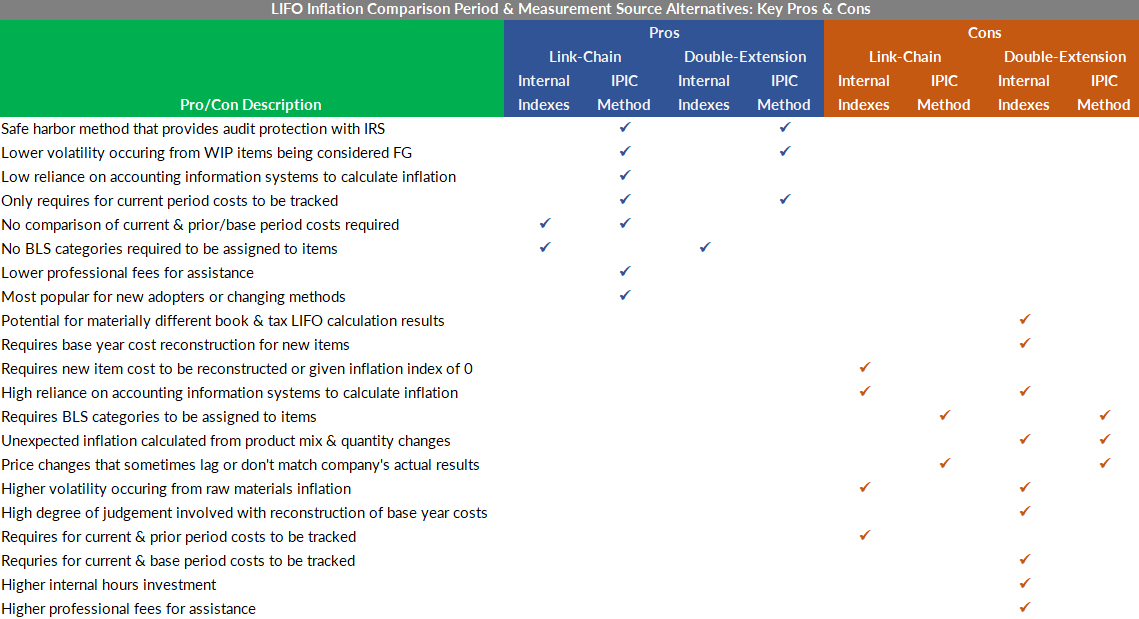
(a) Authorization — A taxpayer may use the method provided in subsection (b) (whether or not such method has been prescribed under section 471) in inventorying goods specified in an application to use such method filed at such time and in such manner as the Secretary may prescribe. The change to, and the use of, such method shall be in accordance with such regulations as the Secretary may prescribe as necessary in order that the use of such method may clearly reflect income.
(b) Method Applicable — In inventorying goods specified in the application described in subsection (a), the taxpayer shall:
(1) — Treat those remaining on hand at the close of the taxable year as being: First, those included in the opening inventory of the taxable year (in the order of acquisition) to the extent thereof; and second, those acquired in the taxable year;
(2) — Inventory them at cost; and
(3) — Treat those included in the opening inventory of the taxable year in which such method is first used as having been acquired at the same time and determine their cost by the average cost method.
(c) Condition — Subsection (a) shall apply only if the taxpayer establishes to the satisfaction of the Secretary that the taxpayer has used no procedure other than that specified in paragraphs (1) and (3) of subsection (b) in inventorying such goods to ascertain the income, profit, or loss of the first taxable year for which the method described in subsection (b) is to be used, for the purpose of a report or statement covering such taxable year—
(1) — to shareholders, partners, or other proprietors, or to beneficiaries, or
(2) — for credit purposes.
(d) 3-Year Averaging For Increases In Inventory Value — The beginning inventory for the first taxable year for which the method described in subsection (b) is used shall be valued at cost. Any change in the inventory amount resulting from the application of the preceding sentence shall be taken into account ratably in each of the 3 taxable years beginning with the first taxable year for which the method described in subsection (b) is first used.
(e) Subsequent Inventories — If a taxpayer, having complied with subsection (a), uses the method described in subsection (b) for any taxable year, then such method shall be used in all subsequent taxable years unless—
(1) — with the approval of the Secretary a change to a different method is authorized; or,
(2) — the Secretary determines that the taxpayer has used for any such subsequent taxable year some procedure other than that specified in paragraph (1) of subsection (b) in inventorying the goods specified in the application to ascertain the income, profit, or loss of such subsequent taxable year for the purpose of a report or statement covering such taxable year (A) to shareholders, partners, or other proprietors, or beneficiaries, or (B) for credit purposes; and requires a change to a method different from that prescribed in subsection (b) beginning with such subsequent taxable year or any taxable year thereafter.
If paragraph (1) or (2) of this subsection applies, the change to, and the use of, the different method shall be in accordance with such regulations as the Secretary may prescribe as necessary in order that the use of such method may clearly reflect income.
(f) Use Of Government Price Indexes In Pricing Inventory — The Secretary shall prescribe regulations permitting the use of suitable published governmental indexes in such manner and circumstances as determined by the Secretary for purposes of the method described in subsection (b).
(g) Conformity Rules Applied On Controlled Group Basis
(1) In General — Except as otherwise provided in regulations, all members of the same group of financially related corporations shall be treated as 1 taxpayer for purposes of subsections (c) and (e)(2).
(2) Group Of Financially Related Corporations — For purposes of paragraph (1), the term “group of financially related corporations” means—
(A) — any affiliated group as defined in section 1504 determined by substituting “50 percent” for “80 percent” each place it appears in section 1504(a) and without regard to section 1504(b), and
(B) — any other group of corporations which consolidate or combine for purposes of financial statements.
(a) Any taxpayer permitted or required to take inventories pursuant to the provisions of section 471, and pursuant to the provisions of §§ 1.471-1 to 1.471-9, inclusive, may elect with respect to those goods specified in his application and properly subject to inventory to compute his opening and closing inventories in accordance with the method provided by section 472, this section, and § 1.472-2. Under this last-in, first-out (LIFO) inventory method, the taxpayer is permitted to treat those goods remaining on hand at the close of the taxable year as being:
1. Those included in the opening inventory of the taxable year, in the order of acquisition and to the extent thereof, and
2. Those acquired during the taxable year.
3. The LIFO inventory method is not dependent upon the character of the business in which the taxpayer is engaged, or upon the identity or want of identity through commingling of any of the goods on hand, and may be adopted by the taxpayer as of the close of any taxable year.
(b) If the LIFO inventory method is used by a taxpayer who regularly and consistently, in a manner similar to hedging on a futures market, matches purchases with sales, then firm purchases and sales contracts (i.e., those not legally subject to cancellation by either party) entered into at fixed prices on or before the date of the inventory may be included in purchases or sales, as the case may be, for the purpose of determining the cost of goods sold and the resulting profit or loss, provided that this practice is regularly and consistently adhered to by the taxpayer and provided that, in the opinion of the Commissioner, income is clearly reflected thereby.
(c) A manufacturer or processor who has adopted the LIFO inventory method as to a class of goods may elect to have such method apply to the raw materials only (including those included in goods in process and in finished goods) expressed in terms of appropriate units. If such method is adopted, the adjustments are confined to costs of the raw material in the inventory and the cost of the raw material in goods in process and in finished goods produced by such manufacturer or processor and reflected in the inventory. The provisions of this paragraph may be illustrated by the following examples:
Example (1) Assume that the opening inventory had 10 units of raw material, 10 units of goods in process, and 10 units of finished goods, and that the raw material cost was 6 cents a unit, the processing cost 2 cents a unit, and overhead cost 1 cent a unit. For the purposes of this example, it is assumed that the entire amount of goods in process was 50 percent processed.

In the closing inventory there are 20 units of raw material, 6 units of goods in process, and 8 units of finished goods and the costs were: Raw material 10 cents, processing cost 4 cents, and overhead 1 cent.
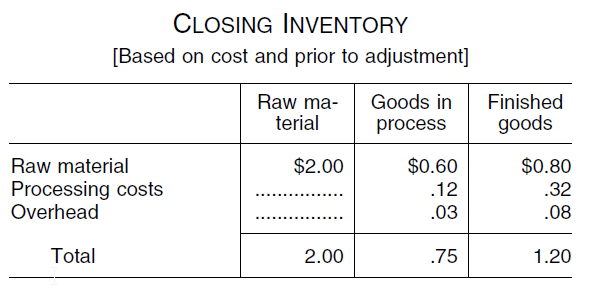
There were 30 units of raw material in the opening inventory and 34 units in the closing inventory. The adjustment to the closing inventory would be as follows:
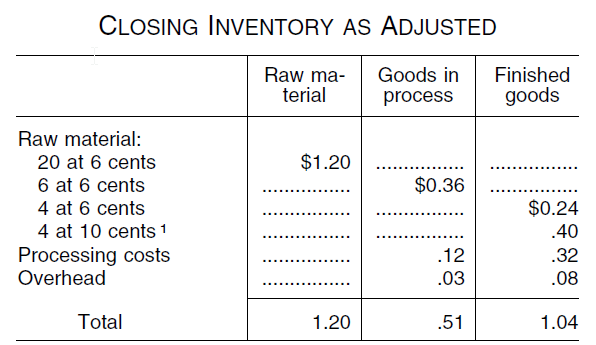
Example (2) Assume that the opening inventory had 5 units of raw material, 10 units of goods in process, and 20 units of finished goods, with the same prices as in Example 1, and that the closing inventory had 20 units of raw material, 20 units of goods in process, and 10 units of finished goods, with raw material costs as in the closing inventory in Example 1. The adjusted closing inventory would be as follows in so far as the raw material is concerned:
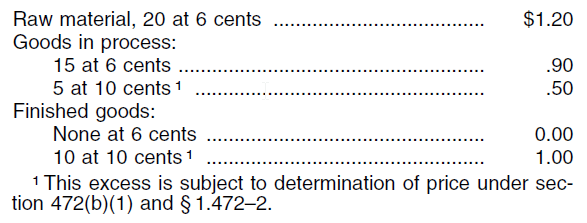
The 20 units of raw material in the raw state plus 15 units of raw material in goods in process make up the 35 units of raw material that were contained in the opening inventory.
(d) For the purposes of this section, raw material in the opening inventory must be compared with similar raw material in the closing inventory. There may be several types of raw materials, depending upon the character, quality, or price, and each type of raw material in the opening inventory must be compared with a similar type in the closing inventory.
(e) In the cotton textile industry there may be different raw materials depending upon marked differences in length of staple, in color or grade of the cotton. But where different staple lengths or grades of cotton are being used at different times in the same mill to produce the same class of goods, such differences would not necessarily require the classification into different raw materials.
(f) As to the pork packing industry a live hog is considered as being composed of various raw materials, different cuts of a hog varying markedly in price and use. Generally a hog is processed into approximately 10 primal cuts and several miscellaneous articles. However, due to similarity in price and use, these may be grouped into fewer classifications, each group being classed as one raw material.
(g) When the finished product contains two or more different raw materials as in the case of cotton and rayon mixtures, each raw material is treated separately and adjustments made accordingly.
(h) Upon written notice addressed to the Commissioner of Internal Revenue, Attention T:R, Washington, D.C. 20224 by the taxpayer, a taxpayer who has heretofore adopted the LIFO inventory method in respect of any goods may adopt the method authorized in this section and limit the election to the raw material including raw materials entering into goods in process and in finished goods. If this method is adopted as to any specific goods, it must be used exclusively for such goods for any prior taxable year (not closed by agreement) to which the prior election applies and for all subsequent taxable years, unless permission to change is granted by the Commissioner.
(i) The election may also be limited to that phase in the manufacturing process where a product is produced that is recognized generally as a salable product as, for example, in the textile industry where one phase of the process is the production of yarn. Since yarn is generally recognized as a salable product, the election may be limited to that portion of the process when yarn is produced. In the case of copper and brass processors, the election may be limited to the production of bars, plates, sheets, etc., although these may be further processed into other products.
(j) The election may also apply to any one raw material, when two or more raw materials enter into the composition of the finished product; for example, in the case of cotton and rayon yarn, the taxpayer may elect to inventory the cotton only. However, a taxpayer who has previously made an election to use the LIFO inventory method may not later elect to exclude any raw materials that were covered by such previous election.
(k) If a taxpayer using the retail method of pricing inventories, authorized by § 1.471-8, elects to use in connection therewith the LIFO inventory method authorized by section 472 and this section, the apparent cost of the goods on hand at the end of the year, determined pursuant to § 1.471-8, shall be adjusted to the extent of price changes therein taking place after the close of the preceding taxable year. The amount of any apparent inventory increase or decrease to be eliminated in this adjustment shall be determined by reference to acceptable price indexes established to the satisfaction of the Commissioner. Price indexes prepared by the United States Bureau of Labor Statistics which are applicable to the goods in question will be considered acceptable to the Commissioner. Price indexes which are based upon inadequate records, or which are not subject to complete and detailed audit within the Internal Revenue Service, will not be approved.
(l) If a taxpayer uses consistently the so-called “dollar-value” method of pricing inventories, or any other method of computation established to the satisfaction of the Commissioner as reasonably adaptable to the purpose and intent of section 472 and this section, and if such taxpayer elects under section 472 to use the LIFO inventory method authorized by such section, the taxpayer’s opening and closing inventories shall be determined under section 472 by the use of the appropriate adaptation. See § 1.472-8 for rules relating to the use of the dollar-value method.
Except as otherwise provided in § 1.472-1 with respect to raw material computations, with respect to retail inventory computations, and with respect to other methods of computation established to the satisfaction of the Commissioner as reasonably adapted to the purpose and intent of section 472, and in § 1.472-8 with respect to the “dollar-value” method, the adoption and use of the LIFO inventory method is subject to the following requirements:
(a) The taxpayer shall file an application to use such method specifying with particularity the goods to which it is to be applied.
(b) The inventory shall be taken at cost regardless of market value.
(c) Goods of the specified type included in the opening inventory of the taxable year for which the method is first used shall be considered as having been acquired at the same time and at a unit cost equal to the actual cost of the aggregate divided by the number of units on hand. The actual cost of the aggregate shall be determined pursuant to the inventory method employed by the taxpayer under the regulations applicable to the prior taxable year with the exception that restoration shall be made with respect to any writedown to market values resulting from the pricing of former inventories.
(d) Goods of the specified type on hand as of the close of the taxable year in excess of what were on hand as of the beginning of the taxable year shall be included in the closing inventory, regardless of identification with specific invoices and regardless of specific cost accounting records, at costs determined pursuant to the provisions of subparagraph (1) or (2) of this paragraph, dependent upon the character of the transactions in which the taxpayer is engaged:
(i) In the case of a taxpayer engaged in the purchase and sale of merchandise, such as a retail grocer or druggist, or engaged in the initial production of merchandise and its sale without processing, such as a miner selling his ore output without smelting or refining, such costs shall be determined –
(a) By reference to the actual cost of the goods most recently purchased or produced;
(b) By reference to the actual cost of the goods purchased or produced during the taxable year in the order of acquisition;
(c) By application of an average unit cost equal to the aggregate cost of all of the goods purchased or produced throughout the taxable year divided by the total number of units so purchased or produced, the goods reflected in such inventory increase being considered for the purposes of section 472 as having been acquired all at the same time; or
(d) Pursuant to any other proper method which, in the opinion of the Commissioner, clearly reflects income.
(ii) Whichever of the several methods of valuing the inventory increase is adopted by the taxpayer and approved by the Commissioner shall be consistently adhered to in all subsequent taxable years so long as the LIFO inventory method is used by the taxpayer.
(iii) The application of subdivisions (i) and (ii) of this subparagraph may be illustrated by the following examples:
Example 1.
Suppose that the taxpayer adopts the LIFO inventory method for the taxable year 1957 with an opening inventory of 10 units at 10 cents per unit, that it makes 1957 purchases of 10 units as follows:

and that it has a 1957 closing inventory of 15 units. This closing inventory, depending upon the taxpayer’s method of valuing inventory increases, will be computed as follows:
(a) Most recent purchases –

(b) In order of acquisitions –

or
(c) At an annual average –

Example 2.
Suppose that the taxpayer’s closing inventory for 1958, the year following that involved in Example 1 of this subdivision, reflects an inventory decrease for the year, and not an increase; suppose that there is, accordingly, a 1958 closing inventory of 13 units. Inasmuch as the decreased closing inventory will be determined wholly by reference to the 15 units reflected in the opening inventory for the year, and will be taken “in the order of acquisition” pursuant to section 472 (b) (1), and inasmuch as the character of the taxpayer’s opening inventory for 1958 will be dependent upon its method of valuing its 5-unit inventory increase for 1957, the closing inventory for 1958 will be computed as follows:
(a) In case the increase for 1957 was taken by reference to the most recent purchases –

or
(b) In case the increase for 1957 was taken in the order of acquisition –

or
(c) In case the increase for 1957 was taken on the basis of an average –

(2) In the case of a taxpayer engaged in manufacturing, fabricating, processing, or otherwise producing merchandise, such costs shall be determined:
(i) In the case of raw materials purchased or initially produced by the taxpayer, in the manner elected by the taxpayer under subparagraph (1) of this paragraph to the same extent as if the taxpayer were engaged in purchase and sale transactions; and
(ii) In the case of goods in process, regardless of the stage to which the manufacture, fabricating, or processing may have advanced, and in the case of finished goods, pursuant to any proper method which, in the opinion of the Commissioner, clearly reflects income.
(e) LIFO conformity requirement –
(1)In general. The taxpayer must establish to the satisfaction of the Commissioner that the taxpayer, in ascertaining the income, profit, or loss for the taxable year for which the LIFO inventory method is first used, or for any subsequent taxable year, for credit purposes or for purposes of reports to shareholders, partners, or other proprietors, or to beneficiaries, has not used any inventory method other than that referred to in § 1.472-1 or at variance with the requirement referred to in § 1.472-2(c). See paragraph (e)(2) of this section for rules relating to the meaning of the term “taxable year” as used in this paragraph. The following are not considered at variance with the requirement of this paragraph:
(i) The taxpayer’s use of an inventory method other than LIFO for purposes of ascertaining information reported as a supplement to or explanation of the taxpayer’s primary presentation of the taxpayer’s income, profit, or loss for a taxable year in credit statements or financial reports (including preliminary and unaudited financial reports). See paragraph (e)(3) of this section for rules relating to the reporting of supplemental and explanatory information ascertained by the use of an inventory method other than LIFO.
(ii) The taxpayer’s use of an inventory method other than LIFO to ascertain the value of the taxpayer’s inventory of goods on hand for purposes of reporting the value of such inventories as assets. See paragraph (e)(4) of this section for rules relating to such disclosures.
(iii) The taxpayer’s use of an inventory method other than LIFO for purposes of ascertaining information reported in internal management reports. See paragraph (e)(5) of this section for rules relating to such reports.
(iv) The taxpayer’s use of an inventory method other than LIFO for purposes of issuing reports or credit statements covering a period of operations that is less than the whole of a taxable year for which the LIFO method is used for Federal income tax purposes. See paragraph (e)(6) of this section for rules relating to series of interim reports.
(v) The taxpayer’s use of the lower of LIFO cost or market method to value LIFO inventories for purposes of financial reports and credit statements. However, except as provided in paragraph (e)(7) of this section, a taxpayer may not use market value in lieu of cost to value inventories for purposes of financial reports or credit statements.
(vi) The taxpayer’s use of a costing method or accounting method to ascertain income, profit, or loss for credit purposes or for purposes of financial reports if such costing method or accounting method is neither inconsistent with the inventory method referred to in § 1.472-1 nor at variance with the requirement referred to in § 1.472-2(c), regardless of whether such costing method or accounting method is used by the taxpayer for Federal income tax purposes. See paragraph (e)(8) of this section for examples of such costing methods and accounting methods.
(vii) For credit purposes or for purposes of financial reports, the taxpayer’s treatment of inventories, after such inventories have been acquired in a transaction to which section 351 applies from a transferor that used the LIFO method with respect to such inventories, as if such inventories had the same acquisition dates and costs as in the hands of the transferor.
(viii) For credit purposes or for purposes of financial reports relating to a taxable year, the taxpayer’s determination of income, profit, or loss for the taxable year by valuing inventories in accordance with the procedures described in section 472(b) (1) and (3), notwithstanding that such valuation differs from the valuation of inventories for Federal income tax purposes because the taxpayer either –
(A) Adopted such procedures for credit or financial reporting purposes beginning with an accounting period other than the taxable year for which the LIFO method was first used by the taxpayer for Federal income tax purposes, or
(B) With respect to such inventories treated a business combination for credit or financial reporting purposes in a manner different from the treatment of the business combination for Federal income tax purposes.
(2)One-year periods other than a taxable year. The rules of this paragraph relating to the determination of income, profit, or loss for a taxable year and credit statements or financial reports that cover a taxable year also apply to the determination of income, profit, or loss for a one-year period other than a taxable year and credit statements or financial reports that cover a one-year period other than a taxable year, but only if the one-year period both begins and ends in a taxable year or years for which the taxpayer uses the LIFO method for Federal income tax purposes. For example, the requirements of paragraph (e)(1) of this section apply to a taxpayer’s determination of income for purposes of a credit statement that covers a 52-week fiscal year beginning and ending in a taxable year for which the taxpayer uses the LIFO method for Federal income tax purposes. Similarly, in the case of a calendar year taxpayer, the requirements of paragraph (e)(1) of this section apply to the taxpayer’s determination of income for purposes of a credit statement that covers the period October 1, 1981, through September 30, 1982, if the taxpayer uses the LIFO method for Federal income tax purposes in taxable years 1981 and 1982. However, the Commissioner will waive any violation of the requirements of this paragraph in the case of a credit statement or financial report that covers a one-year period other than a taxable year if the report was issued before January 22, 1981.
(3)Supplemental and explanatory information –
(i)Face of the income statement. Information reported on the face of a taxpayer’s financial income statement for a taxable year is not considered a supplement to or explanation of the taxpayer’s primary presentation of the taxpayer’s income, profit, or loss for the taxable year in credit statements or financial reports. For purposes of paragraph (e)(3) of this section, the face of an income statement does not include notes to the income statement presented on the same page as the income statement, but only if all notes to the financial income statement are presented together.
(ii)Notes to the income statement. Information reported in notes to a taxpayer’s financial income statement is considered a supplement to or explanation of the taxpayer’s primary presentation of income, profit, or loss for the period covered by the income statement if all notes to the financial income statement are presented together and if they accompany the income statement in a single report. If notes to an income statement are issued in a report that does not include the income statement, the question of whether the information reported therein is supplemental or explanatory is determined under the rules in paragraph (e)(3)(iv) of this section.
(iii)Appendices and supplements to the income statement. Information reported in an appendix or supplement to a taxpayer’s financial income statement is considered a supplement to or explanation of the taxpayer’s primary presentation of income, profit, or loss for the period covered by the income statement if the appendix or supplement accompanies the income statement in a single report and the information reported in the appendix or supplement is clearly identified as a supplement to or explanation of the taxpayer’s primary presentation of income, profit, or loss as reported on the face of the taxpayer’s income statement. If an appendix or supplement to an income statement is issued in a report that does not include the income statement, the question of whether the information reported therein is supplemental or explanatory is determined under the rules in paragraph (e)(3)(iv) of this section. For purposes of paragraph (e)(3)(iii) of this section, an appendix or supplement to an income statement includes written statements, schedules, and reports that are labelled supplements or appendices to the income statement. However, sections of an annual report such as those labelled “President’s Letter”, “Management’s Analysis”, “Statement of Changes in Financial Position”, “Summary of Key Figures”, and similar sections are reports described in paragraph (e)(3)(iv) of this section and are not considered “supplements or appendices to an income statement” within the meaning of paragraph (e)(3)(iii) of this section, regardless of whether such sections are also labelled as supplements or appendices. For purposes of paragraph (e)(3)(iii) of this section, information is considered to be clearly identified as a supplement to or explanation of the taxpayer’s primary presentation of income, profit, or loss as reported on the face of the taxpayer’s income statement if the information either –
(A) Is reported in an appendix or supplement that contains a general statement identifying all such supplemental or explanatory information;
(B) Is identified specifically as supplemental or explanatory by a statement immediately preceding or following the disclosure of the information;
(C) Is disclosed in the context of making a comparison to corresponding information disclosed both on the face of the taxpayer’s income statement and in the supplement or appendix; or
(D) Is a disclosure of the effect on an item reported on the face of the taxpayer’s income statement of having used the LIFO method.
For example, a restatement of cost of goods sold based on an inventory method other than LIFO is considered to be clearly identified as supplemental or explanatory information if the supplement or appendix containing the restatement contains a general statement that all information based on such inventory method is reported in the appendix or supplement as a supplement to or explanation of the taxpayer’s primary presentation of income, profit, or loss as reported on the face of the taxpayer’s income statement.
(iv)Other reports; in general. The rules of paragraph (e)(3) (iv), (v), and (vi) of this section apply to the following types of reports: news releases; letters to shareholders, partners, or other proprietors or beneficiaries; oral statements at press conferences, shareholders’ meetings or securities analysts’ meetings; sections of an annual report such as those labelled “President’s Letter”, “Management’s Analysis”, “Statement of Changes in Financial Position”, “Summary of Key Figures”, and similar sections; and reports other than a taxpayer’s income statement or accompanying notes, appendices, or supplements. Information disclosed in such a report is considered a supplement to or explanation of the taxpayer’s primary presentation of income, profit, or loss for the period covered by an income statement if the supplemental or explanatory information is clearly identified as a supplement to or explanation of the taxpayer’s primary presentation of income, profit, or loss as reported on the face of the taxpayer’s income statement and the specific item of information being explained or supplemented, such as the cost of goods sold, net income, or earnings per share ascertained using the LIFO method, is also reported in the other report.
(v)Other reports; disclosure of non-LIFO income. For purposes of paragraph (e)(3)(iv) of this section, supplemental or explanatory information is considered to have been clearly identified as such if it would be considered to have been clearly identified as such under the rules of paragraph (e)(3)(iii) of this section, relating to information reported in supplements or appendices to an income statement. For example, if at a securities analysts’ meeting the following question is asked, “What would the reported earnings per share for the year have been if the FIFO method had been used to value inventories?”, it would be permissible to respond “Reported earnings per share for the year were $6.00. If the company had used the FIFO method to value inventories this year and had computed earnings based upon the following assumptions, earnings per share would have been $8.20. FIFO earnings are based on the following assumptions:
“(A) The use of the same effective tax rate as used in computing LIFO earnings, and
“(B) All other conditions and assumptions remain the same, including –
“(1) The use of the LIFO method for Federal income tax purposes and
“(2) The investment of the tax savings resulting from such use of the LIFO method, the income from which is included in both LIFO and FIFO “earnings.”
(vi)Other reports; disclosure of effect on income. For purposes of paragraph (e)(3)(iv) of this section, if the only supplement to or explanation of a specific item is the effect on the item of having used LIFO instead of a method other than LIFO to value inventories, it is not necessary to also report the specific item. For example, if at a shareholders’ meeting the question is asked, “What was the effect on reported earnings per share of not having used FIFO to value inventories?”, it would be permissible to respond “If earnings would have been computed on the basis of the following assumptions, the use of LIFO instead of FIFO to value inventories would have decreased reported earnings per share by $2.20. FIFO earnings are based on the following assumptions:
“(A) The use of the same effective tax rate as used in computing LIFO earnings, and
“(B) All other conditions and assumptions remain the same, including –
“(1) The use of the LIFO method for Federal income tax purposes and
“(2) The investment of the tax savings resulting from such use of the LIFO method, the income from which is included in both LIFO and FIFO earnings.”
(4)Inventory asset value disclosures. Under paragraph (e)(1)(ii) of this section, the use of an inventory method other than LIFO to ascertain the value of the taxpayer’s inventories for purposes of reporting the value of the inventories as assets is not considered the ascertainment of income, profit, or loss and therefore is not considered at variance with the requirement of paragraph (e)(1) of this section. Therefore, a taxpayer may disclose the value of inventories on a balance sheet using a method other than LIFO to identify the inventories, and such a disclosure will not be considered at variance with the requirement of paragraph (e)(1) of this section. However, the disclosure of income, profit, or loss for a taxable year on a balance sheet issued to creditors, shareholders, partners, other proprietors, or beneficiaries is considered at variance with the requirement of paragraph (e)(1) of this section if such income information is ascertained using an inventory method other than LIFO and such income information is for a taxable year for which the LIFO method is used for Federal income tax purposes. Therefore, a balance sheet that discloses the net worth of a taxpayer, determined as if income had been ascertained using an inventory method other than LIFO, may be at variance with the requirement of paragraph (e)(1) of this section if the disclosure of net worth is made in a manner that also discloses income, profit, or loss for a taxable year.
However, a disclosure of income, profit, or loss using an inventory method other than LIFO is not considered at variance with the requirement of paragraph (e)(1) of this section if the disclosure is made in the form of either a footnote to the balance sheet or a parenthetical disclosure on the face of the balance sheet. In addition, an income disclosure is not considered at variance with the requirement of paragraph (e)(1) of this section if the disclosure is made on the face of a supplemental balance sheet labelled as a supplement to the taxpayer’s primary presentation of financial position, but only if, consistent with the rules of paragraph (e)(3) of this section, such a disclosure is clearly identified as a supplement to or explanation of the taxpayer’s primary presentation of financial income as reported on the face of the taxpayer’s income statement.
(5)Internal management reports. [Reserved]
(6)Series of interim reports. For purposes of paragraph (e)(1)(iv) of this section, a series of credit statements or financial reports is considered a single statement or report covering a period of operations if the statements or reports in the series are prepared using a single inventory method and can be combined to disclose the income, profit, or loss for the period. However, the Commissioner will waive any violation of the requirement of this paragraph in the case of a series of interim reports issued before February 6, 1978, that cover a taxable year, or a series of interim reports issued before January 22, 1981 that cover a one-year period other than a taxable year.
(7)Market value. The Commissioner will waive any violation of the requirement of this paragraph in the case of a taxpayer’s use of market value in lieu of cost for a credit statement or financial report issued before January 22, 1981. However, the special rule of this (7) applies only to a taxpayer’s use of market value in lieu of cost and does not apply to the use of a method of valuation such as market value in lieu of cost but not more than FIFO cost.
(8)Use of different methods. The following are examples of costing methods and accounting methods that are neither inconsistent with the inventory method referred to in § 1.472-1 nor at variance with the requirement of § 1.472-2(c) and which, under paragraph (e)(1)(vi) of this section, may be used to ascertain income, profit, or loss for credit purposes or for purposes of financial reports regardless of whether such method is also used by the taxpayer for Federal income tax purposes:
(i) Any method relating to the determination of which costs are includible in the computation of the cost of inventory under the full absorption inventory method.
(ii) Any method of establishing pools for inventory under the dollar-value LIFO inventory method.
(iii) Any method of determining the LIFO value of a dollar-value inventory pool, such as the double-extension method, the index method, and the link chain method.
(iv) Any method of determining or selecting a price index to be used with the index or link chain method of valuing inventory pools under the dollar-value LIFO inventory method.
(v) Any method permitted under § 1.472-8 for determining the current-year cost of closing inventory for purposes of using the dollar-value LIFO inventory method.
(vi) Any method permitted under § 1.472-2(d) for determining the cost of goods in excess of goods on hand at the beginning of the year for purposes of using a LIFO method other than the dollar-value LIFO method.
(vii) Any method relating to the classification of an item as inventory or a capital asset.
(viii) The use of an accounting period other than the period used for Federal income tax purposes.
(ix) The use of cost estimates.
(x) The use of actual cost of cut timber or the cost determined under section 631(a).
(xi) The use of inventory costs unreduced by any adjustment required by the application of section 108 and section 1017, relating to discharge of indebtedness.
(xii) The determination of the time when sales or purchases are accrued.
(xiii) The use of a method to allocate basis in the case of a business combination other than the method used for Federal income tax purposes.
(xiv) The treatment of transfers of inventory between affiliated corporations in a manner different from that required by § 1.1502-13.
(9)Reconciliation of LIFO inventory values. A taxpayer may be required to reconcile differences between the value of inventories maintained for credit or financial reporting purposes and for Federal income tax purposes in order to show that the taxpayer has satisfied the requirements of this paragraph.
(f) Goods of the specified type on hand as of the close of the taxable year preceding the taxable year for which this inventory method is first used shall be included in the taxpayer’s closing inventory for such preceding taxable year at cost determined in the manner prescribed in paragraph (c) of this section.
(g) The LIFO inventory method, once adopted by the taxpayer with the approval of the Commissioner, shall be adhered to in all subsequent taxable years unless –
(1) A change to a different method is approved by the Commissioner; or
(2) The Commissioner determines that the taxpayer, in ascertaining income, profit, or loss for the whole of any taxable year subsequent to his adoption of the LIFO inventory method, for credit purposes or for the purpose of reports to shareholders, partners, or other proprietors, or to beneficiaries, has used any inventory method at variance with that referred to in § 1.472-1 and requires of the taxpayer a change to a different method for such subsequent taxable year or any taxable year thereafter.
(h) The records and accounts employed by the taxpayer in keeping his books shall be maintained in conformity with the inventory method referred to in § 1.472-1; and such supplemental and detailed inventory records shall be maintained as will enable the district director readily to verify the taxpayer’s inventory computations as well as his compliance with the requirements of section 472 and §§ 1.472-1 through 1.472-7.
(i) Where the taxpayer is engaged in more than one trade or business, the Commissioner may require that if the LIFO method of valuing inventories is used with respect to goods in one trade or business the same method shall also be used with respect to similar goods in the other trades or businesses if, in the opinion of the Commissioner, the use of such method with respect to such other goods is essential to a clear reflection of income.
(a) The LIFO inventory method may be adopted and used only if the taxpayer files with his income tax return for the taxable year as of the close of which the method is first to be used a statement of his election to use such inventory method. The statement shall be made on Form 970 pursuant to the instructions printed with respect thereto and to the requirements of this section, or in such other manner as may be acceptable to the Commissioner. Such statement shall be accompanied by an analysis of all inventories of the taxpayer as of the beginning and as of the end of the taxable year for which the LIFO inventory method is proposed first to be used, and also as of the beginning of the prior taxable year. In the case of a manufacturer, this analysis shall show in detail the manner in which costs are computed with respect to raw materials, goods in process, and finished goods, segregating the products (whether in process or finished goods) into natural groups on the basis of either (1) similarity in factory processes through which they pass, or (2) similarity of raw materials used, or (3) similarity in style, shape, or use of finished products. Each group of products shall be clearly described.
(b) The taxpayer shall submit for the consideration of the Commissioner in connection with the taxpayer’s adoption or use of the LIFO inventory method such other detailed information with respect to his business or accounting system as may be at any time requested by the Commissioner.
(c) As a condition to the taxpayer’s use of the LIFO inventory method, the Commissioner may require that the method be used with respect to goods other than those specified in the taxpayer’s statement of election if, in the opinion of the Commissioner, the use of such method with respect to such other goods is essential to a clear reflection of income.
(d) Whether or not the taxpayer’s application for the adoption and use of the LIFO inventory method should be approved, and whether or not such method, once adopted, may be continued, and the propriety of all computations incidental to the use of such method, will be determined by the Commissioner in connection with the examination of the taxpayer’s income tax returns.
A taxpayer may not change to the LIFO method of taking inventories unless, at the time he files his application for the adoption of such method, he agrees to such adjustments incident to the change to or from such method, or incident to the use of such method, in the inventories of prior taxable years or otherwise, as the district director upon the examination of the taxpayer’s returns may deem necessary in order that the true income of the taxpayer will be clearly reflected for the years involved.
An election made to adopt and use the LIFO inventory method is irrevocable, and the method once adopted shall be used in all subsequent taxable years, unless the use of another method is required by the Commissioner, or authorized by him pursuant to a written application therefor filed as provided in paragraph (e) of § 1.446-1.
If the taxpayer is granted permission by the Commissioner to discontinue the use of LIFO method of taking inventories, and thereafter to use some other method, or if the taxpayer is required by the Commissioner to discontinue the use of the LIFO method by reason of the taxpayer’s failure to conform to the requirements detailed in § 1.472-2, the inventory of the specified goods for the first taxable year affected by the change and for each taxable year thereafter shall be taken –
(a) In conformity with the method used by the taxpayer under section 471 in inventorying goods not included in his LIFO inventory computations; or
(b) If the LIFO inventory method was used by the taxpayer with respect to all of his goods subject to inventory, then in conformity with the inventory method used by the taxpayer prior to his adoption of the LIFO inventory method; or
(c) If the taxpayer had not used inventories prior to his adoption of the LIFO inventory method and had no goods currently subject to inventory by a method other than the LIFO inventory method, then in conformity with such inventory method as may be selected by the taxpayer and approved by the Commissioner as resulting in a clear reflection of income; or
(d) In any event, in conformity with any inventory method to which the taxpayer may change pursuant to application approved by the Commissioner.
For additional rules in the case of certain corporate acquisitions specified in section 381(a), see section 381(c)(5) and the regulations thereunder.
(a) Election to use dollar-value method. Any taxpayer may elect to determine the cost of his LIFO inventories under the so-called “dollar-value” LIFO method, provided such method is used consistently and clearly reflects the income of the taxpayer in accordance with the rules of this section. The dollar-value method of valuing LIFO inventories is a method of determining cost by using “base-year” cost expressed in terms of total dollars rather than the quantity and price of specific goods as the unit of measurement. Under such method the goods contained in the inventory are grouped into a pool or pools as described in paragraphs (b) and (c) of this section. The term “base-year cost” is the aggregate of the cost (determined as of the beginning of the taxable year for which the LIFO method is first adopted, i.e., the base date) of all items in a pool. The taxable year for which the LIFO method is first adopted with respect to any item in the pool is the “base year” for that pool, except as provided in paragraph (g)(3) of this section. Liquidations and increments of items contained in the pool shall be reflected only in terms of a net liquidation or increment for the pool as a whole. Fluctuations may occur in quantities of various items within the pool, new items which properly fall within the pool may be added, and old items may disappear from the pool, all without necessarily effecting a change in the dollar value of the pool as a whole. An increment in the LIFO inventory occurs when the end of the year inventory for any pool expressed in terms of base-year cost is in excess of the beginning of the year inventory for that pool expressed in terms of base-year cost. In determining the inventory value for a pool, the increment, if any, is adjusted for changing unit costs or values by reference to a percentage, relative to base-year-cost, determined for the pool as a whole. See paragraph (e) of this section. See also paragraph (f) of this section for rules relating to the change to the dollar-value LIFO method from another LIFO method.
(b) Principles for establishing pools of manufacturers and processors –
(1)Natural business unit pools. A pool shall consist of all items entering into the entire inventory investment for a natural business unit of a business enterprise, unless the taxpayer elects to use the multiple pooling method provided in subparagraph (3) of this paragraph. Thus, if a business enterprise is composed of only one natural business unit, one pool shall be used for all of its inventories, including raw materials, goods in process, and finished goods. If, however, a business enterprise is actually composed of more than one natural business unit, more than one pool is required. Where similar types of goods are inventoried in two or more natural business units of the taxpayer, the Commissioner may apportion or allocate such goods among the various natural business units, if he determines that such apportionment or allocation is necessary in order to clearly reflect the income of such taxpayer. Where a manufacturer or processor is also engaged in the wholesaling or retailing of goods purchased from others, any pooling of the LIFO inventory of such purchased goods for the wholesaling or retailing operations shall be determined in accordance with the rules of paragraph (c) of this section.
(2)Definition of natural business unit.
(i) Whether an enterprise is composed of more than one natural business unit is a matter of fact to be determined from all the circumstances. The natural business divisions adopted by the taxpayer for internal management purposes, the existence of separate and distinct production facilities and processes, and the maintenance of separate profit and loss records with respect to separate operations are important considerations in determining what is a business unit, unless such divisions, facilities, or accounting records are set up merely because of differences in geographical location. In the case of a manufacturer or processor, a natural business unit ordinarily consists of the entire productive activity of the enterprise within one product line or within two or more related product lines including (to the extent engaged in by the enterprise) the obtaining of materials, the processing of materials, and the selling of manufactured or processed goods. Thus, in the case of a manufacturer or processor, the maintenance and operation of a raw material warehouse does not generally constitute, of itself, a natural business unit. If the taxpayer maintains and operates a supplier unit the production of which is both sold to others and transferred to a different unit of the taxpayer to be used as a component part of another product, the supplier unit will ordinarily constitute a separate and distinct natural business unit. Ordinarily, a processing plant would not in itself be considered a natural business unit if the production of the plant, although saleable at this stage, is not sold to others, but is transferred to another plant of the enterprise, not operated as a separate division, for further processing or incorporation into another product. On the other hand, if the production of a manufacturing or processing plant is transferred to a separate and distinct division of the taxpayer, which constitutes a natural business unit, the supplier unit itself will ordinarily be considered a natural business unit. However, the mere fact that a portion of the production of a manufacturing or processing plant may be sold to others at a certain stage of processing with the remainder of the production being further processed or incorporated into another product will not of itself be determinative that the activities devoted to the production of the portion sold constitute a separate business unit. Where a manufacturer or processor is also engaged in the wholesaling or retailing of goods purchased from others, the wholesaling or retailing operations with respect to such purchased goods shall not be considered a part of any manufacturing or processing unit.
(ii) The rules of this subparagraph may be illustrated by the following examples:
Example 1.
A corporation manufactures, in one division, automatic clothes washers and driers of both commercial and domestic grade as well as electric ranges, mangles, and dishwashers. The corporation manufactures, in another division, radios and television sets. The manufacturing facilities and processes used in manufacturing the radios and television sets are distinct from those used in manufacturing the automatic clothes washers, etc. Under these circumstances, the enterprise would consist of two business units and two pools would be appropriate, one consisting of all of the LIFO inventories entering into the manufacture of clothes washers and driers, electric ranges, mangles, and dishwashers and the other consisting of all of the LIFO inventories entering into the production of radio and television sets.
Example 2.
A taxpayer produces plastics in one of its plants. Substantial amounts of the production are sold as plastics. The remainder of the production is shipped to a second plant of the taxpayer for the production of plastic toys which are sold to customers. The taxpayer operates his plastics plant and toy plant as separate divisions. Because of the different product lines and the separate divisions the taxpayer has two natural business units.
Example 3.
A taxpayer is engaged in the manufacture of paper. At one stage of processing, uncoated paper is produced. Substantial amounts of uncoated paper are sold at this stage of processing. The remainder of the uncoated paper is transferred to the taxpayer’s finishing mill where coated paper is produced and sold. This taxpayer has only one natural business unit since coated and uncoated paper are within the same product line.
(3)Multiple pools –
(i)Principles for establishing multiple pools.
(a) A taxpayer may elect to establish multiple pools for inventory items which are not within a natural business unit as to which the taxpayer has adopted the natural business unit method of pooling as provided in subparagraph (1) of this paragraph. Each such pool shall ordinarily consist of a group of inventory items which are substantially similar. In determining whether such similarity exists, consideration shall be given to all the facts and circumstances. The formulation of detailed rules for selection of pools applicable to all taxpayers is not feasible. Important considerations to be taken into account include, for example, whether there is substantial similarity in the types of raw materials used or in the processing operations applied; whether the raw materials used are readily interchangeable; whether there is similarity in the use of the products; whether the groupings are consistently followed for purposes of internal accounting and management; and whether the groupings follow customary business practice in the taxpayer’s industry. The selection of pools in each case must also take into consideration such factors as the nature of the inventory items subject to the dollar-value LIFO method and the significance of such items to the taxpayer’s business operations. Where similar types of goods are inventoried in natural business units and multiple pools of the taxpayer, the Commissioner may apportion or allocate such goods among the natural business units and the multiple pools, if he determines that such apportionment or allocation is necessary in order to clearly reflect the income of the taxpayer.
(b) Raw materials which are substantially similar shall be pooled together in accordance with the principles of this subparagraph. However, inventories of raw or unprocessed materials of an unlike nature may not be placed into one pool, even though such materials become part of otherwise identical finished products.
(c) Finished goods and goods-in-process in the inventory shall be placed into pools classified by major classes or types of goods. The same class or type of finished goods and goods-in-process shall ordinarily be included in the same pool. Where the material content of a class of finished goods and goods-in-process included in a pool has been changed, for example, to conform with current trends in an industry, a separate pool of finished goods and goods-in-process will not ordinarily be required unless the change in material content results in a substantial change in the finished goods.
(d) The requirement that pools be established by major types of materials or major classes of goods is not to be construed so as to preclude the establishment of a miscellaneous pool. Since a taxpayer may elect the dollar-value LIFO method with respect to all or any designated goods in his inventory, there may be a number of such inventory items covered in the election. A miscellaneous pool shall consist only of items which are relatively insignificant in dollar value by comparison with other inventory items in the particular trade or business and which are not properly includible as part of another pool.
(ii)Raw materials content pools. The dollar-value method of pricing LIFO inventories may be used in conjunction with the raw materials content method authorized in § 1.472-1. Raw materials (including the raw material content of finished goods and goods-in-process) which are substantially similar shall be pooled together in accordance with the principles of subdivision (i) of this subparagraph. However, inventories of materials of an unlike nature may not be placed into one pool, even though such materials become part of otherwise identical finished products.
(4)IPIC method pools. A manufacturer or processor that elects to use the inventory price index computation method described in paragraph (e)(3) of this section (IPIC method) for a trade or business may elect to establish dollar-value pools for those items accounted for using the IPIC method based on the 2-digit commodity codes (i.e., major commodity groups) in Table 6 (Producer price indexes and percent changes for commodity groupings and individual items, not seasonally adjusted) of the “PPI Detailed Report” published monthly by the United States Bureau of Labor Statistics (available from New Orders, Superintendent of Documents, PO Box 371954, Pittsburgh, PA 15250-7954). A taxpayer electing to establish dollar-value pools under this paragraph (b)(4) may combine IPIC pools that comprise less than 5 percent of the total current-year cost of all dollar-value pools to form a single miscellaneous IPIC pool. A taxpayer electing to establish dollar-value pools under this paragraph (b)(4) may combine a miscellaneous IPIC pool that comprises less than 5 percent of the total current-year cost of all dollar-value pools with the largest IPIC pool. Each of these 5 percent rules is a method of accounting. A taxpayer may not change to, or cease using, either 5 percent rule without obtaining the Commissioner’s prior consent. Whether a specific IPIC pool or the miscellaneous IPIC pool satisfies the applicable 5 percent rule must be determined in the year of adoption or year of change (whichever is applicable) and redetermined every third taxable year. Any change in pooling required or permitted as a result of a 5 percent rule is a change in method of accounting. A taxpayer must secure the consent of the Commissioner pursuant to § 1.446-1(e) before combining or separating pools and must combine or separate its IPIC pools in accordance with paragraph (g)(2) of this section.
(c) Principles for establishing pools for wholesalers, retailers, etc –
(1)In general. Items of inventory in the hands of wholesalers, retailers, jobbers, and distributors shall be placed into pools by major lines, types, or classes of goods. In determining such groupings, customary business classifications of the particular trade in which the taxpayer is engaged is an important consideration. An example of such customary business classification is the department in the department store. In such case, practices are relatively uniform throughout the trade, and departmental grouping is peculiarly adapted to the customs and needs of the business. However, in appropriate cases, the principles set forth in paragraphs (b) (1) and (2) of this section, relating to pooling by natural business units, may be used, with permission of the Commissioner, by wholesalers, retailers, jobbers, or distributors. Where a wholesaler or retailer is also engaged in the manufacturing or processing of goods, the pooling of the LIFO inventory for the manufacturing or processing operations shall be determined in accordance with the rules of paragraph (b) of this section.
(2)IPIC method pools. A retailer that elects to use the inventory price index computation method described in paragraph (e)(3) of this section (IPIC method) for a trade or business may elect to establish dollar-value pools for those items accounted for using the IPIC method based on either the general expenditure categories (i.e., major groups) in Table 3 (Consumer Price Index for all Urban Consumers (CPI-U): U.S. city average, detailed expenditure categories) of the “CPI Detailed Report” or the 2-digit commodity codes (i.e., major commodity groups) in Table 6 (Producer price indexes and percent changes for commodity groupings and individual items, not seasonally adjusted) of the “PPI Detailed Report.” A wholesaler, jobber, or distributor that elects to use the IPIC method for a trade or business may elect to establish dollar-value pools for any group of goods accounted for using the IPIC method and included within one of the 2-digit commodity codes (i.e., major commodity groups) in Table 6 (Producer price indexes and percent changes for commodity groupings and individual items, not seasonally adjusted) of the “PPI Detailed Report.” The “CPI Detailed Report” and the “PPI Detailed Report” are published monthly by the United States Bureau of Labor Statistics (BLS) (available from New Orders, Superintendent of Documents, P.O. Box 371954, Pittsburgh, PA 15250-7954). A taxpayer electing to establish dollar-value pools under this paragraph (c)(2) may combine IPIC pools that comprise less than 5 percent of the total current-year cost of all dollar-value pools to form a single miscellaneous IPIC pool. A taxpayer electing to establish pools under this paragraph (c)(2) may combine a miscellaneous IPIC pool that comprises less than 5 percent of the total current-year cost of all dollar-value pools with the largest IPIC pool. Each of these 5 percent rules is a method of accounting. Thus, a taxpayer may not change to, or cease using, either 5 percent rule without obtaining the Commissioner’s prior consent. Whether a specific IPIC pool or the miscellaneous IPIC pool satisfies the applicable 5 percent rule must be determined in the year of adoption or year of change (whichever is applicable) and redetermined every third taxable year. Any change in pooling required or permitted under a 5 percent rule is a change in method of accounting. A taxpayer must secure the consent of the Commissioner pursuant to section 1.446-1(e) before combining or separating pools and must combine or separate its IPIC pools in accordance with paragraph (g)(2) of this section.
(d) Determination of appropriateness of pools. Whether the number and the composition of the pools used by the taxpayer is appropriate, as well as the propriety of all computations incidental to the use of such pools, will be determined in connection with the examination of the taxpayer’s income tax returns. Adequate records must be maintained to support the base-year unit cost as well as the current-year unit cost for all items priced on the dollar-value LIFO inventory method, regardless of the method authorized by paragraph (e) of this section which is used in computing the LIFO value of the dollar-value pool. The pool or pools selected must be used for the year of adoption and for all subsequent taxable years unless a change is required by the Commissioner in order to clearly reflect income, or unless permission to change is granted by the Commissioner as provided in paragraph (e) of § 1.446-1. However, see paragraph (h) of this section for authorization to change the method of pooling in certain specified cases.
(e) Methods of computation of the LIFO value of a dollar-value pool –
(1)Methods authorized. A taxpayer may ordinarily use only the so-called “double-extension” method for computing the base-year and current-year cost of a dollar-value inventory pool. Where the use of the double-extension method is impractical, because of technological changes, the extensive variety of items, or extreme fluctuations in the variety of the items, in a dollar-value pool, the taxpayer may use an index method for computing all or part of the LIFO value of the pool. An index may be computed by double-extending a representative portion of the inventory in a pool or by the use of other sound and consistent statistical methods. The index used must be appropriate to the inventory pool to which it is to be applied. The appropriateness of the method of computing the index and the accuracy, reliability, and suitability of the use of such index must be demonstrated to the satisfaction of the district director in connection with the examination of the taxpayer’s income tax returns. The use of any so-called “link-chain” method will be approved for taxable years beginning after December 31, 1960, only in those cases where the taxpayer can demonstrate to the satisfaction of the district director that the use of either an index method or the double-extension method would be impractical or unsuitable in view of the nature of the pool. A taxpayer using either an index or link-chain method shall attach to his income tax return for the first taxable year beginning after December 31, 1960, for which the index or link-chain method is used, a statement describing the particular link-chain method or the method used in computing the index. The statement shall be in sufficient detail to facilitate the determination as to whether the method used meets the standards set forth in this subparagraph. In addition, a copy of the statement shall be filed with the Commissioner of Internal Revenue, Attention: T:R, Washington, D.C. 20224. The taxpayer shall submit such other information as may be requested with respect to such index or link-chain method. Adequate records must be maintained by the taxpayer to support the appropriateness, accuracy, and reliability of an index or link-chain method. A taxpayer may request the Commissioner to approve the appropriateness of an index or link-chain method for the first taxable year beginning after December 31, 1960, for which it is used. Such request must be submitted within 90 days after the beginning of the first taxable year beginning after December 31, 1960, in which the taxpayer desires to use the index or link-chain method, or on or before May 1, 1961, whichever is later. A taxpayer entitled to use the retail method of pricing LIFO inventories authorized by paragraph (k) of § 1.472-1 may use retail price indexes prepared by the United States Bureau of Labor Statistics. Any method of computing the LIFO value of a dollar-value pool must be used for the year of adoption and all subsequent taxable years, unless the taxpayer obtains the consent of the Commissioner in accordance with paragraph (e) of § 1.446-1 to use a different method.
(2)Double-extension method.
(i) Under the double-extension method the quantity of each item in the inventory pool at the close of the taxable year is extended at both base-year unit cost and current-year unit cost. The respective extensions at the two costs are then each totaled. The first total gives the amount of the current inventory in terms of base-year cost and the second total gives the amount of such inventory in terms of current-year cost.
(ii) The total current-year cost of items making up a pool may be determined –
(a) By reference to the actual cost of the goods most recently purchased or produced;
(b) By reference to the actual cost of the goods purchased or produced during the taxable year in the order of acquisition;
(c) By application of an average unit cost equal to the aggregate cost of all of the goods purchased or produced throughout the taxable year divided by the total number of units so purchased or produced; or
(d) Pursuant to any other proper method which, in the opinion of the Commissioner, clearly reflects income.
(iii) Under the double-extension method a base-year unit cost must be ascertained for each item entering a pool for the first time subsequent to the beginning of the base year. In such a case, the base-year unit cost of the entering item shall be the current-year cost of that item unless the taxpayer is able to reconstruct or otherwise establish a different cost. If the entering item is a product or raw material not in existence on the base date, its cost may be reconstructed, that is, the taxpayer using reasonable means may determine what the cost of the item would have been had it been in existence in the base year. If the item was in existence on the base date but not stocked by the taxpayer, he may establish, by using available data or records, what the cost of the item would have been to the taxpayer had he stocked the item. If the base-year unit cost of the entering item is either reconstructed or otherwise established to the satisfaction of the Commissioner, such cost may be used as the base-year unit cost in applying the double-extension method. If the taxpayer does not reconstruct or establish to the satisfaction of the Commissioner a base-year unit cost, but does reconstruct or establish to the satisfaction of the Commissioner the cost of the item at some year subsequent to the base year, he may use the earliest cost which he does reconstruct or establish as the base-year unit cost.
(iv) To determine whether there is an increment or liquidation in a pool for a particular taxable year, the end of the year inventory of the pool expressed in terms of base-year cost is compared with the beginning of the year inventory of the pool expressed in terms of base-year cost. When the end of the year inventory of the pool is in excess of the beginning of the year inventory of the pool an increment occurs in the pool for that year. If there is an increment for the taxable year, the ratio of the total current-year cost of the pool to the total base-year cost of the pool must be computed. This ratio when multiplied by the amount of the increment measured in terms of base-year cost gives the LIFO value of such increment. The LIFO value of each such increment is hereinafter referred to in this section as the “layer of increment” and must be separately accounted for and a record thereof maintained as a separate layer of the pool, and may not be combined with a layer of increment occurring in a different year. On the other hand, when the end of the year inventory of the pool is less than the beginning of the year inventory of the pool, a liquidation occurs in the pool for that year. Such liquidation is to be reflected by reducing the most recent layer of increment by the excess of the beginning of the year inventory over the end of the year inventory of the pool. However, if the amount of the liquidation exceeds the amount of the most recent layer of increment, the preceding layers of increment in reverse chronological order are to be successively reduced by the amount of such excess until all the excess is absorbed. The base-year inventory is to be reduced by liquidation only to the extent that the aggregate of all liquidation exceeds the aggregate of all layers of increment.
(v) The following examples illustrate inventories under the double-extension the computation of the LIFO value of method.
Example 1.
(a) A taxpayer elects, beginning with the calendar year 1961, to compute his inventories by use of the LIFO inventory method under section 472 and further elects to use the dollar-value method in pricing such inventories as provided in paragraph (a) of this section. He creates Pool No. 1 for items A, B, and C. The composition of the inventory for Pool No. 1 at the base date, January 1, 1961, is as follows:
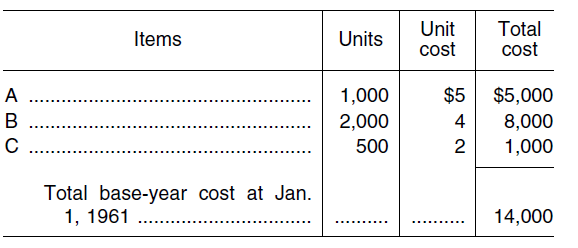
(b) The closing inventory of Pool No. 1 at December 31, 1961, contains 3,000 units of A, 1,000 units of B, and 500 units of C. The taxpayer computes the current-year cost of the items making up the pool by reference to the actual cost of goods most recently purchased. The most recent purchases of items A, B, and C are as follows:
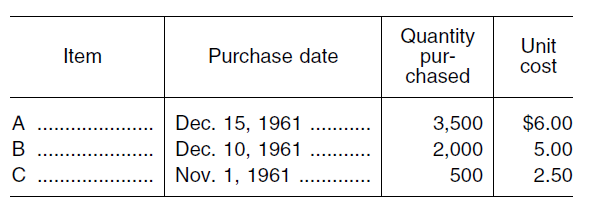
(c) The inventory of Pool No. 1 at December 31, 1961, shown at base-year and current-year cost is as follows:
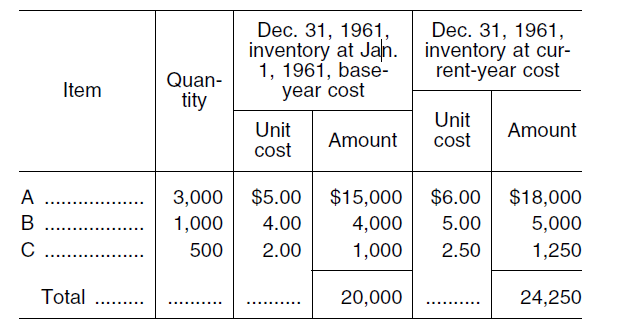
(d) If the amount of the December 31, 1961, inventory at base-year cost were equal to, or less than, the base-year cost of $14,000 at January 1, 1961, such amount would be the closing LIFO inventory at December 31, 1961. However, since the base-year cost of the closing LIFO inventory at December 31, 1961, amounts to $20,000, and is in excess of the $14,000 base-year cost of the opening inventory for that year, there is a $6,000 increment in Pool No. 1 during the year. This increment must be valued at current-year cost, i.e., the ratio of 24,250/20,000, or 121.25 percent. The LIFO value of the inventory at December 31, 1961, is $21,275, computed as follows:
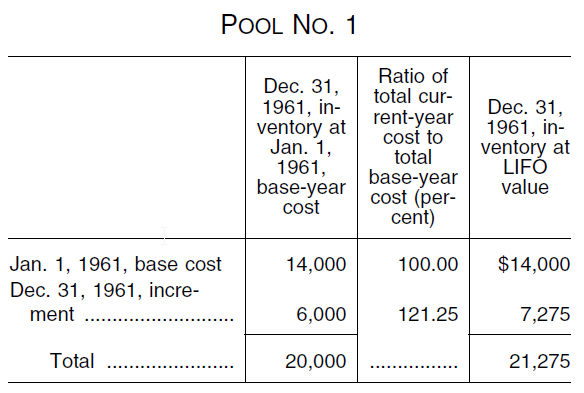
Example 2.
(a) Assume the taxpayer in Example 1 during the year 1962 completely disposes of item C and purchases item D. Assume further that item D is properly includible in Pool No. 1 under the provisions of this section. The closing inventory on December 31, 1962, consists of quantities at current-year unit cost, as follows:
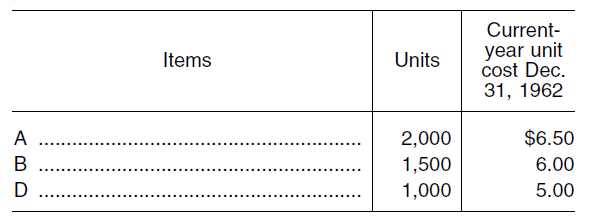
(b) The taxpayer establishes that the cost of item D, had he acquired it on January 1, 1961, would have been $2.00 per unit. Such cost shall be used as the base-year unit cost for item D, and the LIFO computations at December 31, 1962, are made as follows:

(c) Since the closing inventory at base-year cost, $18,000, is less than the 1962 opening inventory at base-year cost, $20,000, a liquidation of $2,000 has occurred during 1962. This liquidation is to be reflected by reducing the most recent layer of increment. The LIFO value of the inventory at December 31, 1962, is $18,850, and is summarized as follows:
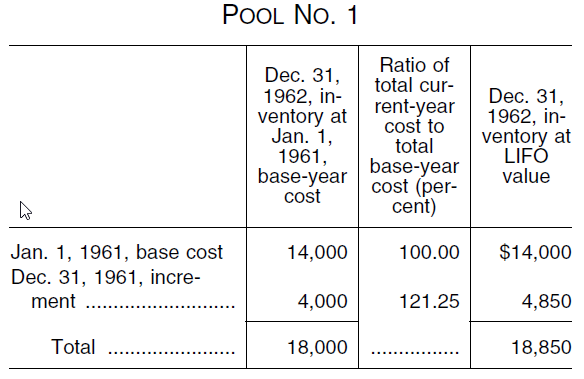
(3)Inventory price index computation (IPIC) method –
(i)In general. The inventory price index computation method provided by this paragraph (e)(3) (IPIC method) is an elective method of determining the LIFO value of a dollar-value pool using consumer or producer price indexes published by the United States Bureau of Labor Statistics (BLS). A taxpayer using the IPIC method must compute a separate inventory price index (IPI) for each dollar-value pool. This IPI is used to convert the total current-year cost of the items in a dollar-value pool to base-year cost in order to determine whether there is an increment or liquidation in terms of base-year cost and, if there is an increment, to determine the LIFO inventory value of the current year’s layer of increment (layer). Using one IPI to compute the base-year cost of a dollar-value pool for the current taxable year and using a different IPI to compute the LIFO inventory value of the current taxable year’s layer is not permitted under the IPIC method. The IPIC method will be accepted by the Commissioner as an appropriate method of computing an index, and the use of that index to compute the LIFO value of a dollar-value pool will be accepted as accurate, reliable, and suitable. The appropriateness of a taxpayer’s computation of an IPI, which includes all the steps described in paragraph (e)(3)(iii) of this section, will be determined in connection with an examination of the taxpayer’s federal income tax return. A taxpayer using the IPIC method may elect to establish dollar-value pools according to the special rules in paragraphs (b)(4) and (c)(2) of this section or the general rules in paragraphs (b) and (c) of this section. Taxpayers eligible to use the IPIC method are described in paragraph (e)(3)(ii) of this section. The manner in which an IPI is computed is described in paragraph (e)(3)(iii) of this section. Rules relating to the adoption of, or change to, the IPIC method are in paragraph (e)(3)(iv) of this section.
(ii)Eligibility. Any taxpayer electing to use the dollar-value LIFO method may elect to use the IPIC method. Except as provided in this paragraph (e)(3)(ii) or in other published guidance, a taxpayer that elects to use the IPIC method for a specific trade or business must use that method to account for all items of dollar-value LIFO inventory. A taxpayer that uses the retail price indexes computed by the BLS and published in “Department Store Inventory Price Indexes” (available from the BLS by calling (202) 606-6325 and entering document code 2415) may elect to use the IPIC method for items that do not fall within any of the major groups listed in “Department Store Inventory Price Indexes.”
(iii)Computation of an inventory price index –
(A)In general. The computation of an IPI for a dollar-value pool requires the following four steps, which are described in more detail in this paragraph (e)(3)(iii): First, selection of a BLS table and an appropriate month; second, assignment of items in a dollar-value pool to BLS categories (selected BLS categories); third, computation of category inflation indexes for selected BLS categories; and fourth, computation of the IPI. A taxpayer may compute the IPI for each dollar-value pool using either the double-extension method (double-extension IPIC method) or the link-chain method (link-chain IPIC method), without regard to whether the use of a double-extension method is impractical or unsuitable. The use of either the double-extension IPIC method or the link-chain IPIC method is a method of accounting, and the adopted method must be applied consistently to all dollar-value pools within a trade or business accounted for under the IPIC method. A taxpayer that wants to change from the double-extension IPIC method to the link-chain IPIC method, or vice versa, must secure the consent of the Commissioner under § 1.446-1(e). This change must be made with a new base year as described in paragraph (e)(3)(iv)(B)(1).
(B)Selection of BLS table and appropriate month –
(1)In general. Under the IPIC method, an IPI is computed using the consumer or producer price indexes for certain categories (BLS price indexes and BLS categories, respectively) listed in the selected BLS table of the “CPI Detailed Report” or the “PPI Detailed Report” for the appropriate month.
(2) BLS table selection. Manufacturers, processors, wholesalers, jobbers, and distributors must select BLS price indexes from Table 6 (Producer price indexes and percent changes for commodity groupings and individual items, not seasonally adjusted) of the “PPI Detailed Report”, unless the taxpayer can demonstrate that selecting BLS price indexes from another table of the “PPI Detailed Report” is more appropriate. Retailers may select BLS price indexes from either Table 3 (Consumer Price Index for all Urban Consumers (CPI-U): U.S. city average, detailed expenditure categories) of the “CPI Detailed Report” or from Table 6 (or another more appropriate table) of the “PPI Detailed Report.” The selection of a BLS table is a method of accounting and must be used for the taxable year of adoption and all subsequent years, unless the taxpayer obtains the Commissioner’s consent under § 1.446-1(e) to change its table selection. A taxpayer that changes its BLS table must establish a new base year in the year of change as described in paragraph (e)(3)(iv)(B) of this section.
(3) Appropriate month. In the case of a retailer using the retail method, the appropriate month is the last month of the retailer’s taxable year. In the case of all other taxpayers, the appropriate month is the month most consistent with the method used to determine the current-year cost of the dollar-value pool under paragraph (e)(2)(ii) of this section and the taxpayer’s history of inventory production or purchases during the taxable year. A taxpayer not using the retail method may annually select an appropriate month for each dollar-value pool or make an election on Form 970, “Application to Use LIFO Inventory Method,” to use a representative appropriate month (representative month). An election to use a representative month is a method of accounting and the month elected must be used for the taxable year of the election and all subsequent taxable years, unless the taxpayer obtains the Commissioner’s consent under § 1.446-1(e) to change or revoke its election.
(4)Examples. The following examples illustrate the rules of this paragraph (e)(3)(iii)(B)(3):
Example 1. Determining an appropriate month.
A wholesaler of seasonal goods timely files a Form 970, “Application to Use LIFO Inventory Method,” for the taxable year ending December 31, 2001. The taxpayer indicates elections to use the dollar-value LIFO method, to determine the current-year cost using the earliest acquisitions method in accordance with paragraph (e)(2)(ii)(b) of this section, and to use the IPIC method under paragraph (e)(3) of this section. Although the taxpayer purchases inventory items regularly throughout the year, the items purchased vary according to the seasons. The seasonal items on hand at December 31, 2001, are purchased between October and December. Thus, based on the taxpayer’s use of the earliest acquisitions method of determining current-year cost and its experience with inventory purchases, the appropriate month for the items represented in the ending inventory at December 31, 2001, is October.
Example 2. Electing a representative month.
A retailer not using the retail method timely files a Form 970, “Application to Use LIFO Inventory Method,” for the taxable year ending December 31, 2001. The taxpayer indicates elections to use the dollar-value LIFO method, the most recent purchases method of determining current-year cost under paragraph (e)(2)(ii)(a) of this section, the IPIC method under paragraph (e)(3) of this section, and December as its representative month under paragraph (e)(3)(iii)(B)(3) of this section. The items in the taxpayer’s ending inventory are purchased fairly uniformly throughout the year, with the first purchases normally occurring in January and the last purchases normally occurring in December. The taxpayer’s election to use December as its representative month is permissible because the taxpayer elected to use the most recent purchases method and the taxpayer’s last purchases of the taxable year normally occur during December, the last month of the taxpayer’s taxable year.
Example 3. Changing representative month.
The facts are the same as in Example 2, except the taxpayer files a Form 3115, “Application for Change in Accounting Method,” requesting permission to change to the earliest acquisitions method of determining current-year cost in accordance with paragraph (e)(2)(ii)(b) of this section and to change its representative month from December to January beginning with the taxable year ending December 31, 2003. If the Commissioner consents to the taxpayer’s request to change to the earliest acquisitions method, December will no longer be a permissible representative month for this taxpayer because of the absence of a nexus between the earliest acquisitions method, the month of December (the last month of the taxpayer’s taxable year), and the taxpayer’s experience with inventory purchases during the year. Thus, the Commissioner will permit the taxpayer to change its representative month to January, the first month of the taxpayer’s taxable year.
Example 4. Changing representative month.
The facts are the same as in Example 2. In 2002, the taxpayer changes its annual accounting period to a taxable year ending June 30, which requires the taxpayer to file a return for the short taxable year beginning January 1, 2002, and ending June 30, 2002. As a result, December is no longer a permissible representative month because of the absence of a nexus between the most recent purchases method, the month of December, and the taxpayer’s experience with inventory purchases during the year. The taxpayer should file a Form 3115 requesting permission to change its representative month from December to June beginning with the short taxable year ending June 30, 2002. Because the taxpayer’s last purchases of the taxable year now will occur in June, the Commissioner will consent to the taxpayer’s request to change its representative month to June.
Example 5. Changing representative month.
The facts are the same as in Example 2, except that the taxpayer elects to use January as its representative month. The taxpayer timely files a Form 3115 requesting permission to change its representative month from January to December beginning with the taxable year ending December 31, 2003. January is not a permissible representative month because of the absence of a nexus between the most recent purchases method, the taxpayer’s history of inventory purchases, and the month of January, the first month in the taxpayer’s taxable year. Because December is a permissible representative month, the Commissioner will permit the taxpayer to change its representative month to December.
(C)Assignment of inventory items to BLS categories –
(1)In general. Except as provided in paragraph (e)(3)(iii)(C)(2) of this section, a taxpayer must assign each item in a dollar-value pool to the most-detailed BLS category of the selected BLS table that contains that item. For example, in Table 6 of the “PPI Detailed Report” for a given month, the commodity codes for the various BLS categories run from 2 to 8 digits, with the least-detailed BLS categories having a 2-digit code and the most-detailed BLS categories usually (but not always) having an 8-digit code. For purposes of assigning items to the most-detailed BLS category, manufacturers and processors must assign each raw material item to the most-detailed PPI category that includes that raw material and must assign each finished good item to the most-detailed PPI category that includes that finished good. In addition, manufacturers and processors must assign each work-in-process (WIP) item to the most-detailed PPI category that includes the finished good into which the item will be manufactured or processed. For this purpose, finished good means a salable item that the taxpayer regularly sells. For example, a gasoline-engine manufacturer that also manufactures the pistons used in those engines and regularly sells some of the pistons (e.g., to retailers of replacement parts) must assign both finished pistons that have not been affixed to an engine block and piston WIP items to the most-detailed PPI category that includes pistons. Finished pistons that have been affixed to an engine block must be assigned to the most-detailed PPI category that includes gasoline engines. In contrast, if sales of these pistons occur infrequently, the taxpayer must assign both finished pistons and piston WIP items to the most-detailed PPI category that includes gasoline engines.
(2)10 percent method. Instead of assigning each item in a dollar-value pool to the most-detailed BLS categories, as described in paragraph (e)(3)(iii)(C)(1) of this section, a taxpayer may elect to use the 10 percent method described in this paragraph (e)(3)(iii)(C)(2). Under the 10 percent method, items are assigned to BLS categories using a three-step procedure. First, when the current-year cost of a specific item is 10 percent or more of the total current-year cost of the dollar-value pool, the taxpayer must assign that item to the most-detailed BLS category that includes that item (10 percent BLS category). Any other item that is includible in that 10 percent BLS category (other than an item that qualifies for its own 10 percent BLS category under the preceding sentence) must be assigned to that 10 percent BLS category. Second, if one or more items have not been assigned to BLS categories in the first step, the taxpayer must investigate successively less-detailed BLS categories and assign the unassigned item(s) to the first BLS category that contains unassigned items whose current-year cost, in the aggregate, is 10 percent or more of the total current-year cost of the dollar-value pool (also, 10 percent BLS categories). This step must be repeated until all the items in the dollar-value pool have been included in an appropriate 10 percent BLS category, the current-year cost of the unassigned items, in the aggregate, is less than 10 percent of the total current-year cost of the dollar-value pool, or the taxpayer determines that a single BLS category is not appropriate for the aggregate of the unassigned items. Third, if items in a dollar-value pool have not been assigned to a 10 percent BLS category because the current-year cost of those items, in the aggregate, is less than 10 percent of the total current-year cost of the dollar-value pool, the taxpayer must assign those items to the most-detailed BLS category that includes all those items (also, a 10 percent category). On the other hand, if items in a dollar-value pool have not been assigned to a 10 percent BLS category because the taxpayer determines that a single BLS category is not appropriate for the aggregate of those items, the taxpayer must assign each of those items to a single miscellaneous BLS category created by the taxpayer (also, a 10 percent category). In no event may a taxpayer assign items in a dollar-value pool to a BLS category that is less detailed than either the major groups of consumer goods described in Table 3 of the monthly “CPI Detailed Report” or the major commodity groups of producer goods described in Table 6 of the monthly “PPI Detailed Report.” Principles similar to those described in paragraph (e)(3)(iii)(C)(1) apply for purposes of assigning raw material, work-in-process, and finished good items to the most-detailed BLS category under the 10 percent method.
(3)Change in method of accounting. The 10 percent method of assigning items in a dollar-value pool to BLS categories is a method of accounting. In addition, a taxpayer’s selection of a BLS category for a specific item is a method of accounting. However, the assignment of items to different BLS categories solely as a result of the application of the 10 percent method is a change in underlying facts and not a change in method of accounting. Likewise, the selection of a new BLS category for a specific item as a result of a revision to a BLS table is a change in underlying facts and not a change in method of accounting. A taxpayer that wants to change its method of selecting BLS categories (i.e., to or from the 10-percent method) or of selecting a BLS category for a specific item must secure the Commissioner’s consent in accordance with § 1.446-1(e). A taxpayer that voluntarily changes its method of selecting BLS categories or of selecting a BLS category for a specific item must establish a new base year in the year of change as described in paragraph (e)(3)(iv)(B) of this section.
(D)Computation of a category inflation index –
(1)In general. As described in more detail in this paragraph (e)(3)(iii)(D), a category inflation index reflects the inflation that occurs in the BLS price indexes for a selected BLS category (or, if applicable, 10 percent BLS category) during the relevant measurement period.
(2)BLS price indexes. The BLS price indexes are the cumulative indexes published in the selected BLS table for the appropriate month. A taxpayer may elect to use either preliminary or final BLS price indexes for the appropriate month, provided that the selected BLS price indexes are used consistently. However, a taxpayer that elects to use final BLS price indexes for the appropriate month must use preliminary BLS price indexes for any taxable year for which the taxpayer files its original federal income tax return before the BLS publishes final BLS price indexes for the appropriate month. If a BLS price index for a most-detailed or 10 percent BLS category is not otherwise available for the appropriate or representative month (but not because the BLS categories in the BLS table have been revised), the taxpayer must use the BLS price index for the next most-detailed BLS category that includes the specific item(s) in the most-detailed or 10 percent BLS category. If a BLS price index is not otherwise available for the appropriate or representative month because the BLS categories in the BLS table have been revised, the rules of paragraph (e)(3)(iii)(D)(4) of this section apply.
(3)Category inflation index –
(i)In general. Except as provided in paragraph (e)(3)(iii)(D)(4) of this section (concerning compound category inflation indexes) or (e)(3)(iii)(D)(5) of this section (concerning category inflation indexes for certain 10 percent BLS categories), a category inflation index for a selected BLS category (or, if applicable, 10 percent BLS category) is computed under the rules of this paragraph (e)(3)(iii)(D)(3).
(ii)Double-extension IPIC method. In the case of a taxpayer using the double-extension IPIC method, the category inflation index for a BLS category is the quotient of the BLS price index for the appropriate or representative month of the current year divided by the BLS price index for the appropriate month of the taxable year preceding the base year (base month). However, if the taxpayer did not have an opening inventory in the year that its election to use the dollar-value LIFO method and double-extension IPIC method became effective, the category inflation index for a BLS category is the quotient of the BLS price index for the appropriate or representative month of the current year divided by the BLS price index for the month immediately preceding the month of the taxpayer’s first inventory production or purchase.
(iii)Link-chain IPIC method. In the case of a taxpayer using the link-chain IPIC method, the category inflation index for a BLS category is the quotient of the BLS price index for the appropriate or representative month of the current year divided by the BLS price index for the appropriate month used for the immediately preceding taxable year. However, if the taxpayer did not have an opening inventory in the year that its election to use the dollar-value LIFO method and link-chain IPIC method became effective, the category inflation index for a BLS category for the year of election is the quotient of the BLS price index for the appropriate or representative month of the current year divided by the BLS price index for the month immediately preceding the month of the taxpayer’s first inventory production or purchase.
(iv)Special rules concerning representative months. A taxpayer electing to use a representative month under paragraph (e)(3)(iii)(B)(3) of this section must use an appropriate month, rather than the representative month, to determine category inflation indexes in the circumstances described in this paragraph (e)(3)(iii)(D)(3)(iv) and in other similar circumstances. For example, in the case of a short taxable year, the category inflation index should reflect the inflation that occurs from the base month (in the case of the double-extension IPIC method), or the appropriate or representative month used for the preceding taxable year (in the case of the link-chain IPIC method), and the appropriate month for the short taxable year. Similarly, if a taxpayer using the link-chain IPIC method is granted consent to change both its method of determining the current-year cost of a dollar-value pool and its representative month, the category inflation index for the year of change should reflect the inflation that occurs between the old representative month used for the preceding taxable year and the new representative month used for the year of change.
(4)Compound category inflation index for revised BLS categories or price indexes –
(i)In general. Periodically, the BLS revises a BLS table to add one or more new BLS categories, eliminate one or more previously reported BLS categories, or reset the base-year BLS price index of one or more BLS categories. If the BLS has revised the applicable BLS table for a taxable year, a taxpayer must compute the category inflation index for each BLS category for which the taxpayer cannot compute a category inflation index in accordance with paragraph (e)(3)(iii)(D)(3) of this section (affected BLS category) using a reasonable method, provided the method is used consistently for all affected BLS categories within a particular taxable year. For example, if the BLS revised the CPI by adding new BLS categories as of January 2001 and eliminating some previously reported BLS categories as of December 2000, January 2002 would be the first month for which it would be possible to compute a category inflation index for a 12-month period using the BLS price indexes for any affected category. The compound category inflation index described in paragraph (e)(3)(iii)(D)(4)(ii) of this section is a reasonable method of computing the category inflation index for an affected BLS category.
(ii)Computation of compound category inflation index. When the applicable BLS table is revised as described in paragraph (e)(3)(iii)(D)(4)(i) of this section, a taxpayer may use the procedure described in this paragraph (e)(3)(iii)(D)(4)(ii) to compute a compound category inflation index for each affected BLS category represented in the taxpayer’s ending inventory. For this purpose, a compound category inflation index is the product of the category inflation index for the “first portion” multiplied by the corresponding category inflation index for the “second portion.” The category inflation index for the first portion must reflect the inflation that occurs between the end of the base month (in the case of the double-extension IPIC method), or the preceding year’s appropriate or representative month (in the case of the link-chain IPIC method), and the end of the last month covered by the unrevised BLS table based on the old BLS category. The corresponding category inflation index for the second portion must reflect the inflation that occurs between the beginning of the first month covered by the revised BLS table based on the new BLS category and the end of the current year’s appropriate or representative month. First, using the revised BLS table for the current-year’s appropriate or representative month, the taxpayer assigns items in the dollar-value pool using its method of assigning items to BLS categories as described in paragraph (e)(3)(iii)(C) of this section. Second, for each affected BLS category represented in the ending inventory, the taxpayer computes the category inflation index for the second portion using this formula: [A/B], where A equals the BLS price index for the current year’s appropriate or representative month and B equals the BLS price index for the last month covered by the unrevised BLS table (as published for the first month of the revised BLS table). Third, using the unrevised BLS table for the base month (in the case of the double extension IPIC method) or the preceding year’s appropriate or representative month (in the case of the link-chain IPIC method), the taxpayer assigns each of the items in the dollar-value pool using its method of assigning items to BLS categories. Fourth, for each affected BLS category represented in the ending inventory, the taxpayer computes the category inflation index for the first portion using this formula: [C/D], where C equals the BLS price index for the last month covered by the unrevised BLS table (as published for the last month of the unrevised BLS table) and D equals the BLS price index for the base month (in the case of the double-extension IPIC method) or the preceding year’s appropriate or representative month (in the case of the link-chain IPIC method). Fifth, for each affected BLS category represented in the ending inventory, the taxpayer computes the compound category inflation index using this formula: [X*Y], where X equals the category inflation index for the second portion, and Y equals the corresponding category inflation index for the first portion. For the purpose of computing the compound category inflation index for each affected BLS category, the corresponding category inflation index for the first portion is the category inflation index for the unrevised BLS category that includes the specific inventory item(s) included in the revised BLS category. If items included in a single revised BLS category had been included in separate BLS categories before the revision of the BLS table, the corresponding category inflation index for the first portion is the weighted harmonic mean of the category inflation indexes for these unrevised BLS categories. See paragraph (e)(3)(iii)(E)(1) of this section for a formula of the weighted harmonic mean. When computing this weighted-average category inflation index, a taxpayer must use the current-year costs (or in the case of a retailer using the retail method, the retail selling prices) in ending inventory as the weights.
(iii) New base year. A taxpayer may establish a new base year in the year following the taxable year for which the taxpayer computed a compound category inflation index under this paragraph (e)(3)(iii)(D)(4) for one or more affected BLS categories in a dollar-value pool. See paragraph (e)(3)(iv)(B) of this section for the procedures and computations incident to establishing a new base year.
(iv) Examples. The following examples illustrate the rules of this paragraph (e)(3)(iii)(D)(4):
Example 1. BLS categories eliminated.
(i) A retailer, whose taxable year ends January 31, elected to account for its inventories using the dollar-value LIFO method and double-extension IPIC method (based on the CPI), beginning with the taxable year ending January 31, 1997. The taxpayer does not use the retail method, but elected to use January as its representative month. On January 31, 1999, the taxpayer’s only dollar-value pool contains only two items – lemons and peaches. The total current-year cost of these items is as follows: lemons, $40, and peaches, $30.
(ii) The CPI was revised in October of 1998 to eliminate the “Citrus fruits” subcategory of “Other fresh fruits.” In addition, the base-year BLS price index for “Other fresh fruits” was reset to 100.00 as of October 1, 1998. In relevant part, the January 1999 CPI permits the assignment of both lemons and peaches to “Other fresh fruits.” The January 1999 BLS price indexes for “Citrus fruits” and “Other fresh fruits” are 96.6 and 105.6, respectively. In relevant part, the September 1998 CPI permits the assignment of lemons to “Citrus fruits” and peaches to “Other fresh fruits.” The September 1998 BLS price indexes for “Citrus fruits” and “Other fresh fruits” are 194.9 and 294.9, respectively, and the January 1997 BLS price indexes for “Citrus fruits” and “Other fresh fruits” are 190.2 and 290.2, respectively.
(iii) Because the BLS eliminated the category, “Citrus fruits,” as of October 1998, it did not publish a BLS price index for that category in the January 1999 CPI. Thus, the taxpayer cannot compute a category inflation index for “Citrus fruits” under the normal procedures, but may compute a compound category inflation index for that affected BLS category using the procedures described in paragraph (e)(3)(iii)(D)(4)(ii) of this section.
(iv) The taxpayer computes a compound category inflation index for the two BLS categories that formerly included lemons and peaches. The taxpayer first assigns lemons and peaches to “Other fresh fruits,” the most-detailed index in the January 1999 CPI, and then computes the category inflation index for the second portion as follows:

(v) The taxpayer assigns the lemons and peaches to the most-detailed BLS categories in the January 1998 CPI as follows: lemons to “Citrus fruits” and peaches to “Other fresh fruits.” Then, the taxpayer computes the category inflation index for the first portion as follows:

(vi) Because lemons and peaches, which are included together in the revised “Other fresh fruits” category, had been included in separate BLS categories before the BLS table was revised, the taxpayer must compute a single corresponding category inflation index for the affected BLS categories for the first portion. This corresponding category inflation index is the weighted harmonic mean of the separate corresponding category inflation indexes for the first portion using the cost of the items in ending inventory as the weights. The taxpayer computes the corresponding category inflation index for “Other fresh fruits” for the first portion as follows:

(vii) Finally, the taxpayer computes the compound category inflation index for Other fresh fruits as follows:

(viii) The taxpayer may establish a new base year for the taxable year ending January 31, 2000.
Example 2. BLS categories separated.
(i) The facts are the same as in Example 1, except prior to October 1998, both lemons and peaches were assigned to “Other fresh fruits” and in the October 1998 CPI, the BLS created a new category, “Citrus fruits,” for citrus fruits, such as lemons. Moreover, the BLS reset the base-year BLS price index for “Other fresh fruits” to 100.0 as of October 1, 1998. As a result of these changes, the taxpayer may no longer assign lemons to “Other fresh fruits.”
(ii) Because “Citrus fruits” is new as of October 1998, the BLS did not publish a BLS price index for this BLS category in the January 1999 CPI. Thus, because the taxpayer cannot compute a category inflation index for “Citrus fruits” under the normal procedures, the taxpayer may compute a compound category inflation index for the affected BLS category using the procedures described in paragraph (e)(3)(iii)(D)(4)(ii) of this section.
(iii) Based on the January 1999 CPI, the taxpayer assigns lemons to “Citrus fruits” and peaches to “Other fresh fruits.” Then, the taxpayer computes a compound category inflation index for each of the two BLS categories. The computation of the category inflation index for the second portion is as follows:

(iv) Then, the taxpayer computes the category inflation index for the first portion as follows:

(v) Finally, the taxpayer computes the compound category inflation index for “Citrus fruits” and “Other fresh fruits”:

(vi) The taxpayer may establish a new base year for the taxable year ending January 31, 2000.
(5)10 percent method.
(i) Applicability. A taxpayer that elects to use the 10 percent method described in paragraph (e)(3)(iii)(C)(2) of this section must compute a category inflation index for a less-detailed 10 percent BLS category as provided in this paragraph (e)(3)(iii)(D)(5). A less-detailed 10 percent category is a BLS category that –
(A) subsumes two or more BLS categories;
(B) Does not have a single assigned item whose current-year cost is 10 percent or more of the current-year cost of all the items in the dollar-value pool;
(C) Has at least one item in at least one of the subsumed BLS categories; and
(D) Has at least one subsumed BLS category that either does not have any assigned items or is a separate 10 percent BLS category.
(ii) Determination of category inflation index. If the rules of this paragraph (e)(3)(iii)(D)(5) apply, the category inflation index for the less-detailed 10 percent BLS category is equal to the weighted arithmetic mean of the category inflation index (or, compound category inflation index, if applicable) for each of the subsumed BLS categories that have been assigned at least one item from the taxpayer’s dollar-value pool (excluding any item that is properly assigned to a separate 10 percent BLS category). [Weighted Arithmetic Mean = Sum of (Weight × Category Inflation Index)]/Sum of Weights]. The appropriate weight for each of the most-detailed BLS categories referenced in the preceding sentence is the corresponding BLS weight. Currently, in January of each year, the BLS publishes the BLS weights determined for December of the preceding year. In the case of a taxpayer using the double-extension IPIC method, the BLS weights for December of the taxable year preceding the base year are to be used for all taxable years. In the case of a taxpayer using the link-chain IPIC method, the BLS weights for December of a given calendar year are to be used for taxable years that end during the 12-month period that begins on July 1 of the following calendar year. However, if the BLS weights are not published for all of the most-detailed BLS categories referenced above, the taxpayer may use the current-year cost (or in the case of a retailer using the retail method, the retail selling prices) of all items assigned to a specific most-detailed BLS category as the appropriate weight for that category, but must compute a weighted harmonic mean. See paragraph (e)(3)(iii)(E)(1) of this section for a formula of the weighted harmonic mean.
(E)Computation of Inventory Price Index (IPI) –
(1) Double-extension IPIC method. Under the double-extension IPIC method, the IPI for a dollar-value pool is the weighted harmonic mean of the category inflation indexes (or, if applicable, compound category inflation indexes) determined under paragraph (e)(3)(iii)(D) of this section for each selected BLS category (or, if applicable 10 percent BLS category) represented in the taxpayer’s dollar-value pool at the end of the taxable year. The formula for computing the weighted harmonic mean of the category inflation indexes is: [Sum of Weights/Sum of (Weight/Category Inflation Index)]. The weights to be used when computing this weighted harmonic mean are the current-year costs (or, in the case of a retailer using the retail method, the retail selling prices) in each selected BLS category represented in the dollar-value pool at the end of the taxable year.
(2) Link-chain IPIC method. Under the link-chain IPIC method, the IPI for a dollar-value pool is the product of the weighted harmonic mean of the category inflation indexes (or, if applicable, the compound category inflation indexes) determined under paragraph (e)(3)(iii)(D) of this section for each selected BLS category (or, if applicable, 10 percent BLS category) represented in the taxpayer’s dollar-value pool at the end of the taxable year multiplied by the IPI for the immediately preceding taxable year. The formula for computing the weighted harmonic mean of the category inflation indexes is: [Sum of Weights/Sum of (Weight/Category Inflation Index)]. The weights to be used when computing this weighted harmonic mean are the current-year costs (or, in the case of a retailer using the retail method, the retail selling prices) in each selected BLS category represented in the dollar-value pool at the end of the taxable year.
(3) Examples. The following examples illustrate the rules of this paragraph (e)(3)(iii)(E):
Example 1. Double-extension method.
(i)Introduction. R is a retail furniture merchant that does not use the retail method. For the taxable year ending December 31, 2000, R used the first-in, first-out method of identifying inventory and valued its inventory at cost. The total cost of R’s inventory on December 31, 2000, was $850,000. R elected to use the dollar-value LIFO and double-extension IPIC methods for its taxable year ending December 31, 2001. R does not elect to use the 10 percent method described in paragraph (e)(3)(iii)(C)(2) of this section. R determines the current-year cost of the items using the actual cost of the most recently purchased goods. R elected to pool its inventory based on the major groups in Table 6 of the monthly “PPI Detailed Report” in accordance with the special IPIC pooling rules of paragraph (b)(4) of this section. All items in R’s inventory fall within the 2-digit commodity code in Table 6 of the monthly “PPI Detailed Report” for “furniture and household durables.” Therefore, R will maintain a single dollar-value pool.
(ii)Select a BLS table and appropriate month for 2001. R determines that the appropriate month for 2001 is October. R also determines that the appropriate month for 2000 would have been December if R had used the IPIC method for that year.
(iii)Assign inventory items to BLS categories for 2001. For 2001, R assigns all items in the dollar-value pool to the most-detailed BLS categories listed in Table 6 of the October 2001 “PPI Detailed Report” that contain those items. The BLS categories and the current-year cost of the items assigned to them are summarized as follows:

(iv)Compute category inflation indexes for 2001. Because R elected to use the double-extension IPIC method and did not elect the 10 percent method, the category inflation indexes are computed in accordance with paragraph (e)(3)(iii)(D)(3)(ii) of this section (BLS price indexes for October 2001 divided by BLS price indexes for December 2000). R computes the category inflation indexes for 2001 as follows:

(v)Compute IPI for 2001. R must compute the IPI for 2001, which is the weighted harmonic mean of the category inflation indexes for 2001. The formula for the weighted harmonic mean provided in paragraph (e)(3)(iii)(E)(1) of this section is [Sum of Weights/Sum of (Weight/Category Inflation Index)]. The IPI for 2001 is computed as follows:
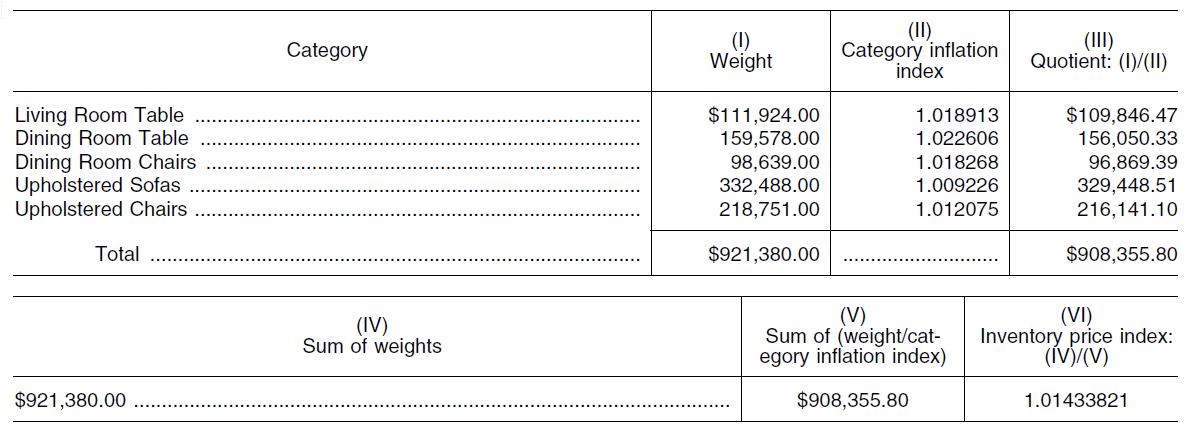
(vi)Determine the LIFO value of the dollar-value pool for 2001. For 2001, R determines the total base-year cost of its ending inventory by dividing the total current-year cost of the items in the dollar-value pool by the IPI for 2001. The total base-year cost of R’s ending inventory is $908,355.80 ($921,380/1.01433821). Comparing the base-year cost of the ending inventory to the base-year cost of the beginning inventory, R determines that the base-year cost of the 2001 increment is $58,355.80 ($908,355.80 – $850,000.00). R multiplies the base-year cost of the 2001 increment by the IPI for 2001 and determines that the LIFO value of the 2001 layer is $59,192.52 ($58,355.80 * 1.01433821). Thus, the LIFO value of R’s total inventory at the end of 2001 is $909,192.52 ($850,000.00 (opening inventory) $59,192.52 (2001 layer)).
(vii)Select a BLS table and appropriate month for 2002. For 2002, R must compute a new IPI under the double-extension IPIC method to determine the LIFO value of its dollar-value pool. R determines that the appropriate month for 2002 is November.
(viii)Assign inventory items to BLS categories for 2002. For 2002, R assigns all items in the dollar-value pool to the most-detailed BLS categories listed in Table 6 of the November 2002 “PPI Detailed Report” that contain those items. The BLS categories and the current-year cost of the items assigned to them are summarized as follows:

(ix)Compute category inflation indexes for 2002. Because R uses the double-extension IPIC method and did not elect the 10 percent method, the category inflation indexes are computed in accordance with paragraph (e)(3)(iii)(D)(3)(ii) of this section (BLS price indexes for November 2002 divided by BLS price indexes for December 2000). R computes the category inflation indexes for 2002 as follows:

(x)Compute IPI for 2002. R must compute the IPI for 2002, which is the weighted harmonic mean [Sum of Weights/Sum of (Weight/Category Inflation Index)] of the category inflation indexes for 2002. The IPI for 2002 is computed as follows:

(xi)Determine the LIFO value of the pool for 2002. For 2002, R determines the total base-year cost of its ending inventory by dividing the total current-year cost of the items in the dollar-value pool by the IPI for 2002. The total base-year cost of the ending inventory is $916,441.28 ($951,743.00/1.03852044). Comparing the base-year cost of the ending inventory to the base-year cost of the beginning inventory, R determines that the base-year cost of the 2002 increment is $8,085.48 ($916,441.28−$908,355.80). R multiplies the base-year cost of the 2002 increment by the IPI for 2002 and determines that the LIFO value of the 2002 layer is $8,396.94 ($8,085.48 * 1.03852044). Thus, the LIFO value of R’s total inventory at the end of 2002 is $917,589.46 ($850,000.00 (opening inventory) $59,192.52 (2001 layer) $8,396.94 (2002 layer)).
Example 2. Link-chain method.
(i)Introduction. The facts are the same as Example 1, except that R uses the link-chain IPIC method. The double-extension IPIC method and the link-chain IPIC method yield the same results for the first taxable year in which the dollar-value LIFO and IPIC methods are used. Therefore, this example illustrates only how R will compute the IPI for, and determine the LIFO value of, its dollar-value pool for 2002.
(ii)Select a BLS table and appropriate month for 2002. R determines that the appropriate month for 2002 is November.
(iii)Assign inventory items to BLS categories for 2002. For 2002, R assigns all items in the dollar-value pool to the most-detailed BLS categories listed in Table 6 of the November 2002 “PPI Detailed Report” that contain those items. The BLS categories and the current-year cost of the items assigned to them are summarized as follows:

(iv)Compute category inflation indexes for 2002. Because R uses the link-chain IPIC method and did not elect the 10 percent method, the category inflation indexes are computed in accordance with paragraph (e)(3)(iii)(D)(3)(iii) of this section (BLS price indexes for November 2002 divided by BLS price indexes for October 2001). R computes the category inflation indexes for 2002 as follows:

(v)Compute IPI for 2002. As provided in paragraph (e)(3)(iii)(E)(2) of this section, R must compute the IPI for 2002 by multiplying the weighted harmonic mean of the category inflation indexes for 2002 by the IPI for 2001. The IPI for 2002 is computed as follows:

(vi)Determine the LIFO value of the pool for 2002. R determines the total base-year cost of its ending inventory by dividing the total current-year cost of the items in the dollar-value pool by the IPI for 2002. The total base-year cost of the ending inventory is $915,313.91 ($951,743.00 / 1.03979956). Comparing the base-year cost of the ending inventory to the base-year cost of the beginning inventory, R determines that the base-year cost of the 2002 layer is $6,958.11 ($915,313.91-$908,355.80). R multiplies the base-year cost of the 2002 layer by the IPI for 2002 and determines that the LIFO value of the 2002 layer is $7,235.04 ($6,958.11 * 1.03979956). Thus, the LIFO value of R’s total inventory at the end of 2002 is $916,427.56 ($850,000.00 (opening inventory) $59,192.52 (2001 layer) $7,235.04 (2002 layer)).
(iv)Adoption or change of method –
(A)Adoption or change to IPIC method. The use of an inventory price index computed under the IPIC method is a method of accounting. A taxpayer permitted to adopt the dollar-value LIFO method without first securing the Commissioner’s consent also may adopt the IPIC method without first securing the Commissioner’s consent. The IPIC method may be adopted and used, however, only if the taxpayer provides the following information on a Form 970, “Application to Use LIFO Inventory Method,” or in another manner as may be acceptable to the Commissioner: A complete list of dollar-value pools (including a description of the items in each dollar-value pool); the BLS table (i.e., CPI or PPI) selected for each dollar-value pool; the representative month, if applicable, elected for each dollar-value pool; the BLS categories to which the items in each dollar-value pool will be assigned; the method of assigning items to BLS categories (e.g., the 10 percent method) for each dollar-value pool; and the method of computing the IPI (i.e., double-extension IPIC method or link-chain IPIC method) for each dollar-value pool. In the case of a taxpayer permitted to adopt the IPIC method without requesting the Commissioner’s consent, the Form 970 must be attached to the taxpayer’s income tax return for the taxable year of adoption. In all other cases, a taxpayer may change to the IPIC method only after securing the Commissioner’s consent as provided in § 1.446-1(e). In these latter cases, the Form 970 containing the information described in this paragraph (e)(3)(iv)(A) must be attached to a Form 3115, “Application for Change in Accounting Method,” filed as required by § 1.446-1(e). A taxpayer that simultaneously changes to the dollar-value LIFO and IPIC methods from another LIFO method must apply the rules of paragraph (f)(2) of this section before applying the rules of paragraph (e)(3)(iv)(B)(1) of this section. To satisfy the requirements of § 1.472-2(h), taxpayers must maintain adequate books and records, including those concerning the use of the IPIC method and necessary computations. Notwithstanding the rules in paragraph (e)(1) of this section, a taxpayer that adopts, or changes to, the link-chain IPIC method is not required to demonstrate that the use of any other method of determining the LIFO value of a dollar-value pool is impractical.
(B)New base year –
(1)Voluntary change –
(i)In general. In the case of a taxpayer using a non-IPIC method to determine the LIFO value of inventory, the layers previously determined under that method, if any, and the LIFO values of those layers are retained if the taxpayer voluntarily changes to the IPIC method. Instead of using the earliest taxable year for which the taxpayer adopted the LIFO method for any items in the dollar-value pool, the year of change is used as the new base year for the purpose of determining the amount of increments and liquidations, if any, for the year of change and subsequent taxable years. The base-year cost of the layers in a dollar-value pool at the beginning of the year of change must be restated in terms of new base-year cost using the year of change as the new base year and, if applicable, the indexes for the previously determined layers must be recomputed accordingly. The recomputed indexes will be used to determine the LIFO value of subsequent liquidations. For purposes of computing an IPI under paragraph (e)(3)(iii)(E) of this section, the IPI for the immediately preceding year is 1.00. The new total base-year cost of the items in a dollar-value pool for the purpose of determining future increments and liquidations is equal to the total current-year cost of the items in the dollar-value pool (determined using the taxpayer’s method of determining the total current-year cost of the items in the dollar-value pool under paragraph (e)(2)(ii) of this section). A taxpayer must allocate this new total base-year cost to each layer based on the ratio of the old base-year cost of the layer to the old total base-year cost of the dollar-value pool.
(ii)Example. The following example illustrates the rules of this paragraph (e)(3)(iv)(B)(1):
Example.
(i) In 1990, X elected to use a dollar-value LIFO method (other than the IPIC method) for its single dollar-value pool. X is granted permission to change to the link-chain IPIC method, beginning with the taxable year ending December 31, 2001. X will continue using a single dollar-value pool. X’s beginning inventory as of January 1, 2001, computed using its former inventory method, is as follows:

(ii) Under X’s method of determining the current-year cost of items in a dollar-value pool, the current-year cost of the beginning inventory is $391,000. Thus, X’s new base-year cost as of January 1, 2001, is $391,000. X allocates this new base-year cost to each layer based on the ratio of old base-year cost of the layer to the total old base-year cost of the dollar-value pool. To recompute the inflation indexes for each of its layers, X divides the LIFO value of each layer by the new base-year cost attributable to the layer. The new base-year cost, recomputed inflation indexes, and LIFO value of X’s layers as of January 1, 2001, are as follows:

(iii) In 2001, the current-year cost of X’s ending inventory is $430,139. The weighted harmonic mean of the category inflation indexes applicable to X’s ending inventory is 1.075347, and in accordance with paragraph (e)(3)(iv)(B)(1)(i) of this section, the inflation index for the immediately preceding taxable year is 1.00. Thus, X’s IPI for 2001 is 1.075347 (1.00 * 1.075347). The total base-year cost of X’s ending inventory is $400,000 ($430,139/1.075347). The base-year cost, IPI, and LIFO value of X’s layers as of December 31, 2001, are as follows:

(iv) In 2002, the current-year cost of X’s ending inventory is $418,000. The weighted harmonic mean of the category inflation indexes applicable to X’s ending inventory is 1.02292562, and the IPI for the immediately preceding year is 1.075347. Thus, X’s IPI for 2001 is 1.10 (1.075347 * 1.02292562). The total base-year cost of X’s ending inventory is $380,000 ($418,000/1.10), which results in a liquidation of $20,000 ($400,000−$380,000) in terms of base-year cost. This liquidation eliminates the 2001 layer ($9,000 base-year cost), the 1997 layer ($3,400 base-year cost), and part of the 1995 layer ($7,600 base-year cost). The base-year cost, indexes, and LIFO value of X’s layers as of December 31, 2002, are as follows:

(2)Involuntary change –
(i) In general. If a taxpayer uses a non-IPIC method to compute the LIFO value of a dollar-value pool, and if the Commissioner determines that the taxpayer’s method does not clearly reflect income, the Commissioner may require the taxpayer to change to the IPIC method. If the Commissioner requires a taxpayer to change to the IPIC method, and the taxpayer does not provide sufficient information from its books and records to compute an adjustment under section 481, the Commissioner may implement the change using the simplified transition method described in paragraph (e)(3)(iv)(B)(2)(ii) of this section.
(ii)Simplified Transition Method. Under the simplified transition method, the Commissioner will recompute the LIFO value of each dollar-value pool as of the beginning of the year of change using the double-extension IPIC method or the link-chain IPIC method. The adjustment under section 481 is equal to the difference between the recomputed LIFO value and the LIFO value of the pool determined under the taxpayer’s former method. The Commissioner will compute an IPI using the double-extension IPIC method or link-chain IPIC method for each taxable year in which the LIFO method was used by the taxpayer based on the assumptions that the ending inventory of the pool in each taxable year was comprised of items that fall into the same BLS categories as the items in the ending inventory of the year of change and that the relative weights of those BLS categories in all prior years were the same as the relative weights of those BLS categories in the ending inventory of the year of change. The base-year cost of the items in a dollar-value pool at the end of a taxable year will be determined by dividing the IPI computed for the taxable year into the current-year cost of the items in that pool determined in accordance with paragraph (e)(2)(ii) of this section. If the comparison of the base-year cost of the beginning and ending inventory produces a current-year increment, the base-year cost of that increment will be multiplied by the IPI computed for that taxable year to determine the LIFO value of that layer.
(iii)Example. The following example illustrates the rules of this paragraph (e)(3)(iv)(B)(2)(ii).
Example.
(i) Z began using a dollar-value LIFO method other than the IPIC method in the taxable year ending December 31, 1998, and maintains a single dollar-value pool. Z’s beginning inventory as of January 1, 2000, computed using its method of accounting, was as follows:

(ii) Upon examining Z’s federal income tax return for the taxable year ending December 31, 2000, the examining agent determines that Z’s dollar-value LIFO method does not clearly reflect income. The examining agent chooses to change Z to the double-extension IPIC method for 2000 and implements the change using the simplified transition method as follows. First, the inventory in Z’s dollar-value pool at the end of 2000 is assigned to the most-detailed categories in the CPI or PPI, whichever is appropriate. Assume that 80 percent of the current-year cost of Z’s inventory as of December 31, 2000, is assigned to Category 1, 10 percent is assigned to Category 2, and 10 percent is assigned to Category 3. Assume further that the current-year cost of the inventory in Z’s dollar-value pool at the end of 1998 and 1999 was $133,000 and $145,000, respectively.
(iii) The category inflation indexes for 1998 computed under the double-extension IPIC method are 1.17 for Category 1, 1.26 for Category 2, and 1.19 for Category 3. The weights to be used in computing the IPI for 1998 are $106,400 ($133,000 * 80 percent) for Category 1, $13,300 ($133,000 * 10 percent) for Category 2, and $13,300 ($133,000 * 10 percent) for Category 3. The IPI for 1998 is computed as follows:

(iv) The base-year cost of the inventory in Z’s pool at the end of 1998 is $112,672 ($133,000/1.180417), and the base-year cost of the 1998 increment is $7,672 ($112,672−$105,000). The LIFO value of the 1998 layer is $9,056 ($7,672 × 1.180417).
(v) The category inflation indexes for 1999 computed under the double-extension IPIC method were 1.21 for Category 1, 1.29 for Category 2 and 1.23 for Category 3. The weights to be used in computing the IPI for 1999 are $116,000 ($145,000 × 80 percent) for Category 1, $14,500 ($145,000 × 10 percent) for Category 2, and $14,500 ($145,000 × 10 percent) for Category 3. The IPI for 1999 is computed as follows:

(vi) The base-year cost of the inventory in Z’s pool at the end of 1999 is $118,897 ($145,000/1.219543), and the base-year cost of the 1999 layer is $6,225 ($118,897−$112,672). The LIFO value of the 1999 layer is $7,592 ($6,225 × 1.219543).
(vii) The LIFO value of Z’s dollar-value pool at the end of 1999 computed under the double-extension IPIC method is as follows:

(viii) The section 481(a) adjustment is equal to the difference between the LIFO value of the inventory at the beginning of 2000 computed under Z’s former method of accounting and recomputed by the examining agent under the double-extension IPIC method, or $12,448 ($121,648 – $109,200).
(ix) Finally, the examining agent will recompute Z’s taxable income for 2000 and succeeding taxable years using the double-extension IPIC method.
(v)Effective date –
(A)In general. The rules of this paragraph (e)(3) and paragraphs (b)(4) and (c)(2) of this section are applicable for taxable years ending on or after December 31, 2001.
(B)Change in method of accounting. Any change in a taxpayer’s method of accounting necessary to comply with this paragraph (e)(3) or with paragraphs (b)(4) or (c)(2) of this section is a change in method of accounting to which the provisions of section 446 and the regulations thereunder apply. For the first or second taxable year ending on or after December 31, 2001, a taxpayer is granted the consent of the Commissioner to change its method of accounting to a method required or permitted by this paragraph (e)(3) and paragraphs (b)(4) and (c)(2) of this section. A taxpayer that wants to change its method of accounting under this paragraph (e)(3)(v) must follow the automatic consent procedures in Rev. Proc. 2002-9 (2002-3 I.R.B. xxx) (see § 601.601(d)(2) of this chapter). However, the scope limitations in section 4.02 of Rev. Proc. 2002-9 do not apply, and the five-year limitation on the readoption of the LIFO method under section 10.01(2) of the appendix is waived. In addition, if the taxpayer’s method of accounting for its LIFO inventories is an issue under consideration at the time the application is filed with the national office, the audit protection of section 7 of Rev. Proc. 2002-9 does not apply. If a taxpayer changing its method of accounting under this paragraph (e)(3)(v)(B) is under examination, before an appeals office, or before a federal court with respect to any income tax issue, the taxpayer must provide a copy of the application to the examining agent(s), appeals officer or counsel for the government, as appropriate, at the same time it files the application with the national office. Any change under this paragraph (e)(3)(v)(B) must be made using a cut-off method and new base year. See paragraph (e)(3)(iv)(B)(1) of this section for an example of this computation. Because a change under this paragraph (e)(3)(v)(B) is made using a cut-off method, a section 481(a) adjustment is not permitted. However, a taxpayer changing its method of accounting under this paragraph (e)(3)(v)(B) must comply with the requirements of section 10.06(3) of the APPENDIX of Rev. Proc. 2002-9 (concerning bargain purchases).
(f) Change to dollar-value method from another method of pricing LIFO inventories –
(1)Consent required. Except as provided in § 1.472-3 in the case of a taxpayer electing to use a LIFO inventory method for the first time, or in the case of a taxpayer changing to the dollar-value method and continuing to use the same pools as were used under another LIFO method, a taxpayer using another LIFO method of pricing inventories may not change to the dollar-value method of pricing such inventories unless he first secures the consent of the Commissioner in accordance with paragraph (e) of § 1.446-1.
(2)Method of converting inventory. Where the taxpayer changes from one method of pricing LIFO inventories to the dollar-value method, the ending LIFO inventory for the taxable year immediately preceding the year of change shall be converted to the dollar-value LIFO method. This is done to establish the base-year cost for subsequent calculations. Thus, if the taxpayer was previously valuing LIFO inventories on the specific goods method, these separate values shall be combined into appropriate pools. For this purpose, the base year for the pool shall be the earliest taxable year for which the LIFO inventory method had been adopted for any item in that pool. No change will be made in the overall LIFO value of the opening inventory for the year of change as a result of the conversion, and that inventory will merely be restated in the manner used under the dollar-value method. All layers of increment for such inventory must be retained, except that all layers of increment which occurred in the same taxable year must be combined. The following examples illustrate the provisions of this subparagraph:
Example 1.
(i) Assume that the taxpayer has used another LIFO method for finished goods since 1954 and has complied with all the requirements prerequisite for a change to the dollar-value method. Items A, B, and C, which have previously been inventoried under the specific goods LIFO method, may properly be included in a single dollar-value LIFO pool. The LIFO inventory value of items A, B, and C at December 31, 1960, is $12,200, computed as follows:

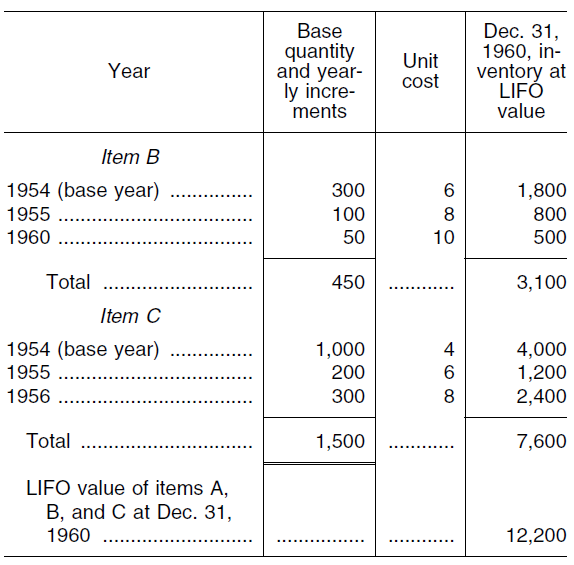
There were no increments in the years 1957, 1958, or 1959.
(ii) The computation of the ratio of the total current-year cost to the total base-year cost for the base year and each layer of increment in Pool No. 1 is shown as follows:
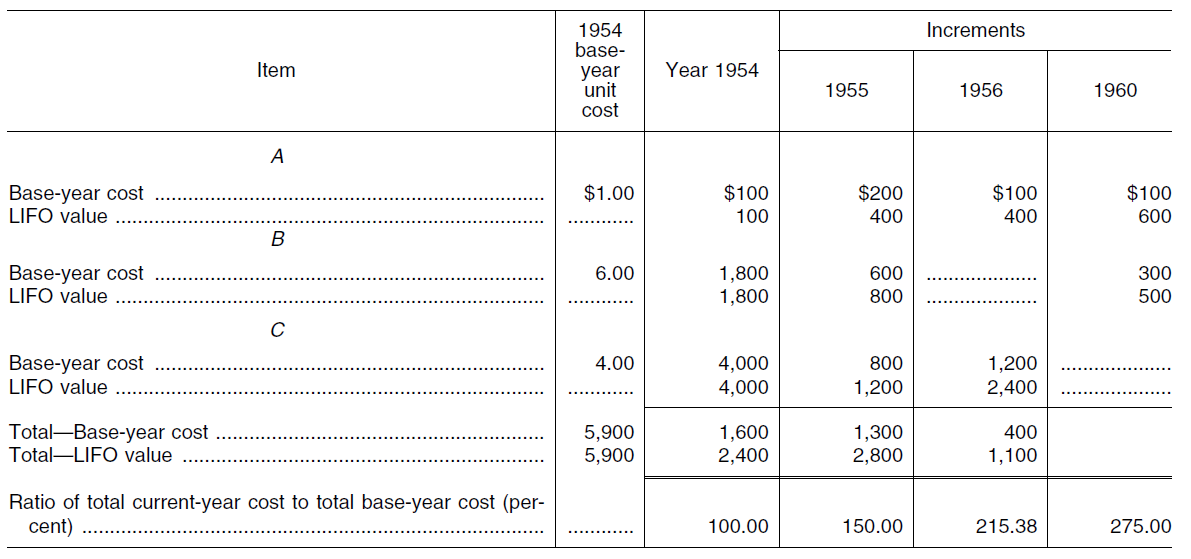
(iii) On the basis of the foregoing computations, the LIFO inventory of Pool No. 1, at December 31, 1960, is restated as follows:

Example 2.
Assume the same facts as in Example 1 and assume further that the base-year cost of Pool No. 1 at December 31, 1961, is $8,350. Since the closing inventory for the taxable year 1961 at base-year cost is less than the opening inventory for that year at base-year cost, a liquidation has occurred during 1961. This liquidation absorbs all of the 1960 layer of increment and part of the 1956 layer of increment. The December 31, 1961, inventory is $10,131, computed as follows:
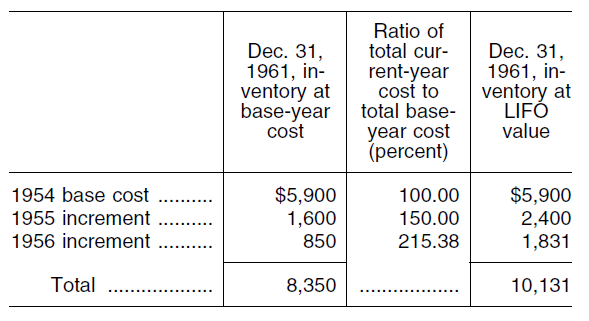
(g) Transitional rules –
(1)Change in method of pooling. Any method of pooling authorized by this section and used by the taxpayer in computing his LIFO inventories under the dollar-value method shall be treated as a method of accounting. Any method of pooling which is authorized by this section shall be used for the year of adoption and for all subsequent taxable years unless a change is required by the Commissioner in order to clearly reflect income, or unless permission to change is granted by the Commissioner as provided in paragraph (e) of § 1.446-1. Where the taxpayer changes from one method of pooling to another method of pooling permitted by this section, the ending LIFO inventory for the taxable year preceding the year of change shall be restated under the new method of pooling.
(2)Manner of combining or separating dollar-value pools.
(i) A taxpayer who has been using the dollar-value LIFO method and who is permitted or required to change his method of pooling, shall combine or separate the LIFO value of his inventory for the base year and each yearly layer of increment in order to conform to the new pool or pools. Each yearly layer of increment in the new pool or pools must be separately accounted for and a record thereof maintained, and any liquidation occurring in the new pool or pools subsequent to the formation thereof shall be treated in the same manner as if the new pool or pools had existed from the date the taxpayer first adopted the LIFO inventory method. The combination or separation of the LIFO value of his inventory for the base year and each yearly layer of increment shall be made in accordance with the appropriate method set forth in this subparagraph, unless the use of a different method is approved by the Commissioner.
(ii) Where the taxpayer is permitted or required to separate a pool into more than one pool, the separation shall be made in the following manner: First, each item in the former pool shall be placed in an appropriate new pool. Every item in each new pool is then extended at its base-year unit cost and the extensions are totaled. Each total is the amount of inventory for each new pool expressed in terms of base-year cost. Then a ratio of the total base-year cost of each new pool to the base-year cost of the former pool is computed. The resulting ratio is applied to the amount of inventory for the base year and each yearly layer of increment of the former pool to obtain an allocation to each new pool of the base-year inventory of the former pool and subsequent layers of increment thereof. The foregoing may be illustrated by the following example of a change for the taxable year 1961:
Example.
(a) Assume that items A, B, C, and D are all grouped together in one pool prior to December 31, 1960. The LIFO inventory value at December 31, 1960, is computed as follows:
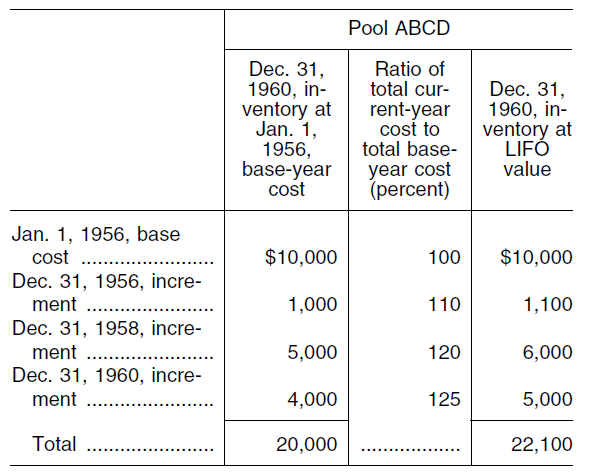
(b) The extension of the quantity of items A, B, C, and D at respective base-year unit costs is as follows:

(c) Under the provisions of this section the taxpayer separates former Pool ABCD into two pools, Pool AB and Pool CD. The computation of the ratio of total base-year cost for each of the new pools to the base-year cost of the former pool is as follows:
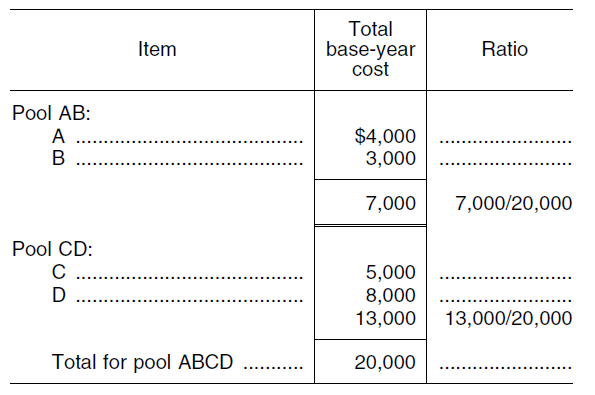
(d) The ratio of the base-year cost of new Pools AB and CD to the base-year cost of former Pool ABCD is 7,000/20,000 and 13,000/20,000, respectively. The allocation of the January 1, 1956 base cost and subsequent yearly layers of increment of former Pool ABCD to new Pools AB and CD is as follows:

(e) The LIFO value of new Pools AB and CD at December 31, 1960, as allocated, is as follows:


(iii) Where the taxpayer is permitted or required to combine two or more pools having the same base year, they shall be combined into one pool in the following manner: The LIFO value of the base-year inventory of each of the former pools is combined to obtain a LIFO value of the base-year inventory for the new pool. Then, any layers of increment in the various pools which occurred in the same taxable year are combined into one total layer of increment for that taxable year. However, layers of increment which occurred in different taxable years may not be combined. In combining the layers of increment a new ratio of current-year cost to base-year cost is computed for each of the combined layers of increment. The foregoing may be illustrated by the following example:
Example.
(a) Assume the taxpayer has two pools at December 31, 1960. Under the provisions of this section the taxpayer combines these pools into a single pool as of January 1, 1961. The LIFO inventory value of each pool at December 31, 1960, is shown as follows:
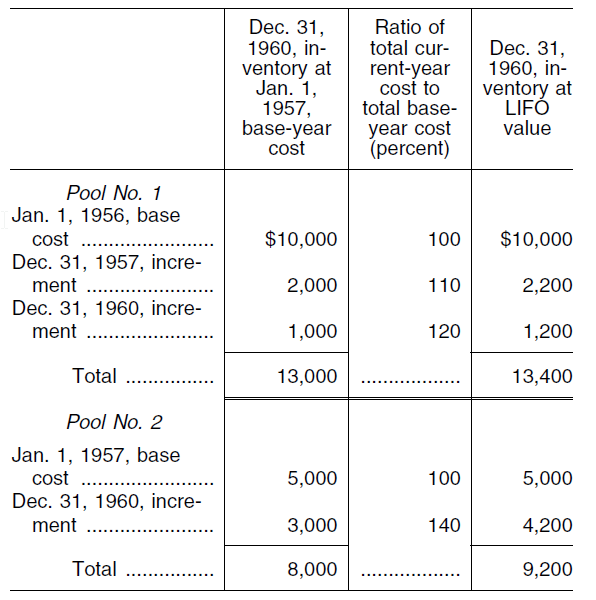
(b) The computation of the ratio of the total current-year cost to the total base-year cost for the base year and each yearly layer of increment in the new pool is as follows:
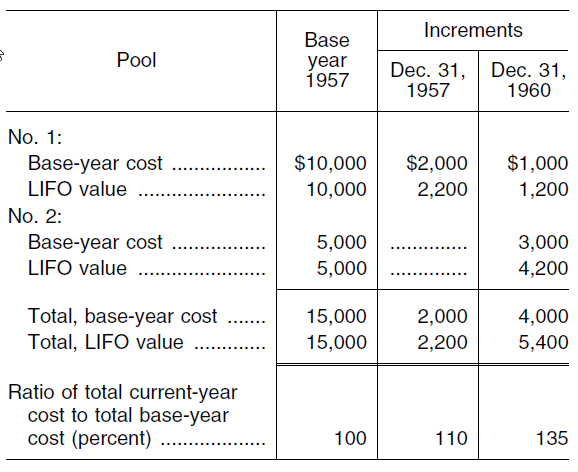
(c) On the basis of the foregoing computations, the LIFO inventory of the new pool at December 31, 1960, is restated as follows:

(iv) In combining pools having different base years, the principles set forth in subdivision (iii) of this subparagraph are to be applied, except that all base years subsequent to the earliest base year shall be treated as increments, and the base-year costs for all pools having a base year subsequent to the earliest base year of any pool shall be redetermined in terms of the base cost for the earliest base year. The foregoing may be illustrated by the following example:
Example.
(a) Assume that the taxpayer has two pools at December 31, 1960. Under the provisions of this section the taxpayer combines these pools into a single pool as of January 1, 1961. The LIFO inventory value of each pool at December 31, 1960, is shown as follows:

(b) The next step is to redetermine the 1958 base-year cost for Pool No. 2 in terms of 1956 base-year cost. January 1, 1956 base-year unit cost must be reconstructed or established in accordance with paragraph (e)(2) of this section for each item in Pool No. 2. Such costs are assumed to be $9.00 for item A, $20.00 for item B, and $1.80 for item C. A ratio of the 1958 total base-year cost to the 1956 total base-year cost for Pool No. 2 is computed as follows:
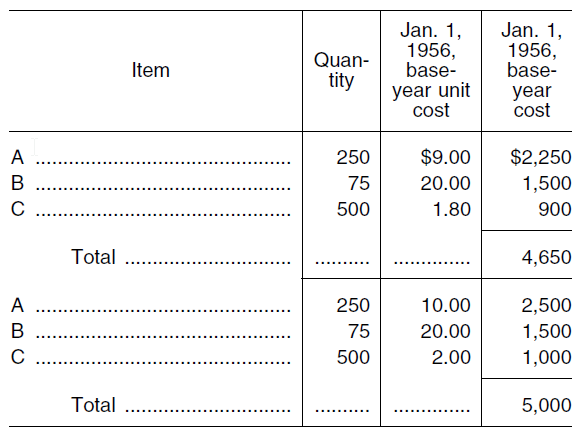
(c) The ratio of the 1956 total base-year cost to the 1958 total base-year cost for Pool No. 2 is 4,650/5,000 or 93 percent. The January 1, 1958 base cost and each yearly layer of increment at 1958 base-year cost is multiplied by this ratio. Such computation is as follows:
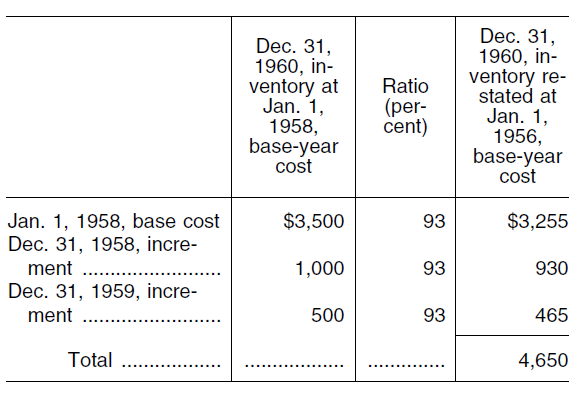
(d) The computation of the ratio of the total current-year cost to the total base-year cost for the base year (1956) and each yearly layer of increment in the new pool is as follows:
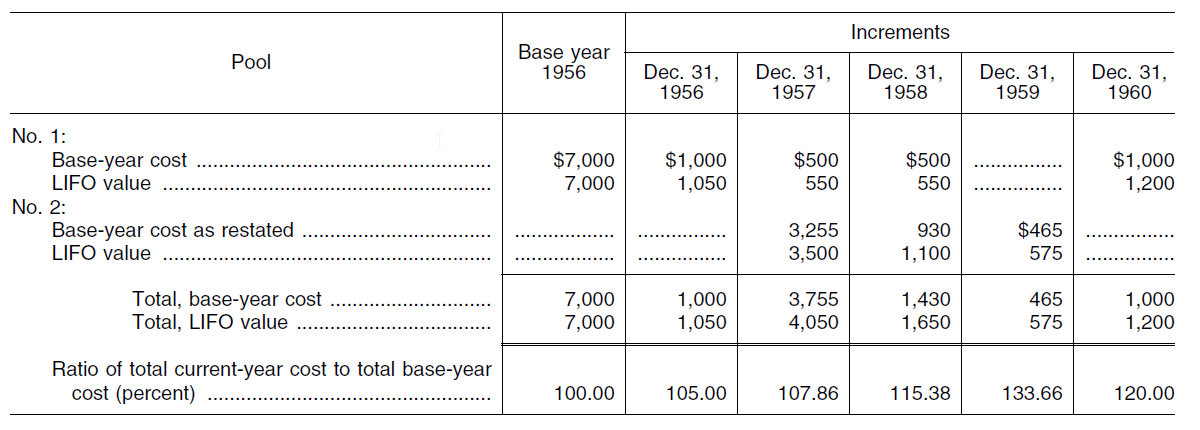
(e) On the basis of the foregoing computation, the LIFO inventory of the new pool at December 31, 1960, is restated as follows:

(3)Change in methods of computation at the LIFO value of a dollar-value pool. For the first taxable year beginning after December 31, 1960, the taxpayer must use a method authorized by paragraph (e)(1) of this section in computing the base-year cost and current-year cost of a dollar-value inventory pool for the end of such year. If the taxpayer had previously used any methods other than one authorized by paragraph (e)(1) of this section, he shall not be required to recompute his LIFO inventories for taxable years beginning on or before December 31, 1960, under a method authorized by such paragraph. The base cost and layers of increment previously computed by such other method shall be retained and treated as if such base cost and layers of increment had been computed under a method authorized by paragraph (e)(1) of this section. The taxpayer shall use the year of change as the base year in applying the double-extension method or other method approved by the Commissioner, instead of the earliest year for which he adopted the LIFO method for any items in the pool.
(h) LIFO inventories received in certain nonrecognition transactions –
(1)In general. Except as provided in paragraph (h)(3) of this section, if inventory items accounted for under the LIFO method are received in a transaction described in paragraph (h)(2) of this section, then, for the purpose of determining future increments and liquidations, the transferee must use the year of transfer as the base year and must use its current-year cost (computed under the transferee’s method of accounting) of those items as their new base-year cost. If the transferee had opening inventories in the year of transfer, then, for the purpose of determining future increments and liquidations, the transferee must use its current-year cost (computed under the transferee’s method of accounting) of those inventories as their new base-year cost. For this purpose, “opening inventory” refers to all items owned by the transferee before the transfer for which the transferee uses, or elects to use, the LIFO method. The total new base-year cost of the transferee’s inventory as of the beginning of the year of transfer is equal to the new base-year cost of the inventory received from the transferor and the new base-year cost of the transferee’s opening inventory. The index (or, the cumulative index in the case of the link-chain method) for the year immediately preceding the year of transfer is 1.00. The base-year cost of any layers in the dollar-value pool, as determined after the transfer, must be recomputed accordingly. See paragraph (e)(3)(iv)(B)(1) of this section for an example of this computation.
(2)Transactions to which this paragraph (h) applies. The rules in this paragraph (h) apply to a transaction in which –
(i) The transferee determines its basis in the inventories, in whole or in part, by reference to the basis of the inventories in the hands of the transferor;
(ii) The transferor used the dollar-value LIFO method to account for the transferred inventories;
(iii) The transferee uses the dollar-value LIFO method to account for the inventories in the year of the transfer; and
(iv) The transaction is not described in section 381(a).
(3)Anti-avoidance rule. The rules in this paragraph (h) do not apply to a transaction entered into with the principal purpose to avail the transferee of a method of accounting that would be unavailable to the transferor (or would be unavailable to the transferor without securing consent from the Commissioner). In determining the principal purpose of a transfer, consideration will be given to all of the facts and circumstances. However, a transfer is deemed made with the principal purpose to avail the transferee of a method of accounting that would be unavailable to the transferor without securing consent from the Commissioner if the transferor acquired inventory in a bargain purchase within the five taxable years preceding the year of the transfer and used a dollar-value LIFO method to account for that inventory that did not treat the bargain purchase inventory and physically identical inventory acquired at market prices as separate items. Inventory is deemed acquired in a bargain purchase if the actual cost of the inventory (or, if appropriate, the allocated cost of the inventory) was less than or equal to 50 percent of the replacement cost of physically identical inventory. Inventory is not considered acquired in a bargain purchase if the actual cost of the inventory (or, if appropriate, the allocated cost of the inventory) was greater than or equal to 75 percent of the replacement cost of physically identical inventory.
(4)Effective date. The rules of this paragraph (h) are applicable for transfers that occur during a taxable year ending on or after December 31, 2001.
A taxpayer’s current Last In-First Out (LIFO) inventory is a historic accumulation of quantity and price changes from the taxpayer’s initial year of the LIFO election. Therefore, the taxpayer must maintain supplemental and detailed LIFO inventory records that support the current value of the inventory and the clear reflection of income. The LIFO regulations underline the importance of these historic records by specifically requiring that taxpayers maintain them. See Treas. Reg. 1.472-2(h).
The taxpayer must maintain a current cost detail listing in its supplemental records for every year in which it employs the LIFO election. See Treas. Reg. 1.472-8(e). The detailed product listing includes the stock-keeping unit (SKU ) number, item description, quantity, and current cost of each item in inventory. These listings are necessary so that the examiner can verify the LIFO computation at any time during the duration of the LIFO election and verify when new items enter the inventory and the current cost of such items.
The taxpayer must maintain detailed records of the current cost and the base cost of the items in inventory and the detail of all index determinations. Treas. Reg.1.472-2(e)(9)(h).
The Service may terminate a taxpayer’s LIFO election if the taxpayer does not maintain adequate books and records for its LIFO inventory and all computations. See Rev. Proc. 79-23. However, termination in these situations is not automatic due to the Service’s discretionary authority in IRC 472(e)(2) and the underlying regulations.
Analysis #1.1 – LIFO Records
The taxpayer must maintain historic LIFO inventory records to verify the current value of its LIFO inventory. The regulations clearly call for the taxpayer to maintain historic records, but they do not specifically identify or define what records the taxpayer must maintain. The LIFO computational methodology sheds light on the type of information necessary for the examiner to verify the appropriateness of the inventory valuation. Please see the LIFO computational methodology shown below.
Regardless of the LIFO sub-method, the taxpayer computes LIFO inventory on a pool by pool basis, which consists of six basic steps:
Analysis #1.2 – LIFO Records, continued
The examiner will need records for the first two steps to reproduce or verify the amounts. Steps three through six are mathematical; the examiner can reproduce and verify these steps without taxpayer records. However, for steps one and two, it is essential the taxpayer maintain sufficient records to enable the examiner to verify the annual current and base cost of the inventory, and the original base cost of the inventory.
The taxpayer’s detail product listing of each item or good in the pool is fundamental to the verification process, because Treas. Reg. 1.472-8(e)(2) requires the taxpayer, under the dollar-value double-extension method, to extend the quantity of each “item” or “good” in the inventory pool at the close of the taxable year at both base-year unit cost and current-year unit cost.
Although Treas. Reg. 1.472-8(e)(2) does not specifically define the term “item,” a SKU would generally meet the definition. A SKU is a unique number for each item in the taxpayer’s inventory. A SKU identifies a product’s details, such as color, size, style, price, manufacturer, and brand. Under the double-extension method, Treas. Reg. 1.472-8(e)(2)(ii) uses the term “good.” Although a “good” (or “item”) under the double-extension method might arguably be a single SKU, many taxpayers group similar SKU’s together to identify a good for LIFO purposes.
Analysis #1.3 – LIFO Records, continued
The double-extension method is comparable to the link-chain, Inventory Price Index Computation (IPIC), and index methods and the taxpayer must maintain the same records for such methods.
Determine Current Cost
The taxpayer needs to:
The examiner needs to:
Analysis #1.4 – LIFO Records, continued
Determine Base Year Cost
The taxpayer must maintain records necessary to verify the base cost of the goods in inventory. These records include the detailed current cost listing of the items in the taxpayer’s ending inventory for the year prior to the election of the LIFO method, adjusted as required by IRC 472(b)(2) in order to reflect inventory at cost, such as restoring prior write downs.
The listing should include the quantity of each item on hand at the end of the tax year prior to the LIFO election, and the unit cost of each item. The taxpayer must maintain this listing for the duration of the LIFO election.
Additional Records
As part of its supplemental and detailed inventory records, the taxpayer must maintain records of the double extensions used to compute the base cost of the inventory, under either the double-extension method or another index method, such as the link-chain method. See Treas. Reg. 1.472-2(e)(9)(h). Please see Practice Unit -Introduction to Dollar Value LIFO.Treas. Reg. 1.472-8(e)(1) states that the taxpayer must maintain adequate records to support the appropriateness, accuracy, and reliability of an index or link-chain method.
Analysis #2.1 – Termination of LIFO Election
The Service may terminate a taxpayer’s LIFO election in certain situations set forth below. See Rev. Proc. 79-23. However, termination in these situations is not automatic due to the Service’s discretionary authority in IRC 472(e)(2) and the underlying regulations.
Analysis #2.2 – Termination of LIFO Election, continued
In Boecking v. Commissioner, T.C. Memo. 1993-497, the Tax Court conferred broad authority on the Service to terminate a taxpayer’s LIFO election because of inadequate books and records. In this case, the taxpayer’s LIFO methodology contained a few deficiencies relating to the calculation of current-year cost and base-year cost. On audit, the taxpayer was unable to correct these deficiencies to the Service’s satisfaction. The Service terminated the taxpayer’s LIFO election rather than attempting to estimate or extrapolate a corrected calculation and the Tax Court upheld the termination. (See Schneider, Federal Taxation of Inventories, chapter 10.02[2][d]. release 38, 1998.)
Analysis #2.3 – Termination of LIFO Election, continued
The Commissioner’s determination with respect to clear reflection of income is entitled to more than the usual presumption of correctness, and the taxpayer bears a heavy burden of overcoming a determination that a method of accounting does not clearly reflect income. Hamilton Industries v. Commissioner,97 T.C. 120 (1991).
Whether a method of accounting clearly reflects income is a question of fact which must be decided on a case-by-case basis. Peninsula Steel Products & Equipment Co. v. Commissioner,78 T.C. 1029, 1045 (1982).
The Commissioner’s determination as to the proper method of accounting for inventory must be upheld unless shown to be plainly erroneous. Lucas v. Kansas City Structural Steel Co., 281 U.S. 264, 271 (1930). The Service provided that the taxpayer should keep adequate records pertaining to LIFO calculations including supporting accounting data, and invoices and records. The taxpayer’s failure to maintain all invoices since the first year of the LIFO election is not, by itself, sufficient to terminate an election. But failure to maintain original inventory records sufficient to enable the Service to verify LIFO calculations could fail the record keeping requirement and allow termination.
Analysis #3.1 – Method of Accounting
When an adjustment is warranted due to the taxpayer incorrectly computing the valuation of the current LIFO inventory, it is probable that there is a change in a method of accounting.
If a change from the improper method to a proper method is not voluntary, IRC 481(a) requires a computation beginning with the first year in which the error occurred and making appropriate adjustments to each LIFO year from that first year to the current year. The IRC 481(a) amount is the cumulative adjustment from the first day of the tax year that the error first occurred.
Although Rev. Proc. 97-27 allows the Service to estimate an IRC 481(a) adjustment, such an estimate may not uncover other errors that may have occurred in those prior years. Also, a court of law may consider the Service’s computation arbitrary. Therefore, the examiner should consider termination of the LIFO election in situations where the taxpayer has failed to maintain adequate records and the IRC 481(a) adjustment is not resolved.
A change in the value of closing inventory, including a change in the treatment of “items” within a LIFO pool, constitutes a change in method of accounting. Hamilton Industries, 97 T.C. 120 (1991); Pacific Enterprises v. Commissioner, 101 T.C. 1 (1993).
Analysis #3.2 – Method of Accounting, continued
The taxpayer in Consolidated Manufacturing, Inc. v. Commissioner, 111 T.C. 1 (1998), aff’d in part, rev’d in part, 249 F.3d 1231 (10th Cir. 2001), maintained records for their method but did not maintain the basic records for current and base cost detail. If the Service raised the issue with the use of summarized items, the court may require the taxpayer maintain cost detail at the SKU level to substantiate clear reflection of income. The Tax Court concluded:
Analysis #4.1 – Change in Accounting Methods
A change from a LIFO Method to a non-LIFO method for valuing inventory is a change in accounting method. See IRC 472(e) and 446.A change in accounting method is made under IRC 446.
If the Service terminates a taxpayer’s LIFO election, the taxpayer must follow the rules outlined in Treas. Reg. 1.472-6. Under a Service-imposed LIFO termination, the taxpayer must value the inventory using the below ordering rules:
If the Service terminates a taxpayer’s LIFO election, the taxpayer will not be entitled to any special relief provisions. The termination adjustment is a change in accounting method under IRC 446 for the earliest year under examination with a corresponding IRC 481(a) adjustment equal to the taxpayer’s LIFO tax reserve as of the first day of the year of change (YOC). In addition, there would be a current year adjustment for the method determined above under Treas. Reg. 1.472-6.
Analysis #4.2 – Change in Accounting Methods, continued
The LIFO reserve is the difference between the ending inventory valued using LIFO and ending inventory valued at current year cost.

Analysis #4.3 – Change in Accounting Methods, continued
In Rev. Proc. 2015-13, the Service reaffirmed that, absent unusual circumstances, a taxpayer may not readopt the LIFO method for at least five taxable years after terminating the election. When the Service determines a taxpayer is using an impermissible method of accounting, the Service may change the taxpayer’s inventory method of accounting to a permissible inventory method. Please see Chapters 1, 5, and 6 of the Change in Methods book within the Servicewide Virtual Library, Examination Floor, Corporate/Business & Credits Knowledge Base (KB), Methods of Accounting and Timing shelf.
Analysis #5 – Audit Techniques
During the exam, follow the steps below:
Any taxpayer may elect to determine the cost of Last In-First Out (LIFO) inventories under the “dollar-value” LIFO method, provided the taxpayer uses the method consistently and it clearly reflects income in accordance with the rules of Treas. Reg. 1.472–8 Dollar-value method of pricing LIFO inventories.
The dollar-value method of valuing LIFO inventories is a method of determining cost by using “base-year” costs expressed in total dollars rather than the quantity and price of specific goods as the unit of measurement. Under this method, the taxpayer groups goods contained in the inventory into a pool(s). The method groups related inventory and uses an overall price index, under one of three approaches, to approximate changes in inventory cost. Rather than tracking individual units, taxpayers measure value based on the total value of the pool.
The term “base-year cost” is the aggregate of the cost of all items in a pool determined as of the base date. The base date is the beginning of the taxable year for which the taxpayer first adopts the LIFO method. The taxable year for which the taxpayer firstadopts the LIFO method for any item in the pool is the “base year” for that pool.
Liquidations (decrements) and increments of items contained in the pool are reflected only in terms of a net liquidation or net increment for the pool. Fluctuations may occur in quantities of various items within the pool, new items that properly fall within the pool may be added, and old items may disappear from the pool, all without necessarily changing the dollar value of the pool.
An increment in the LIFO inventory occurs when the end of the year inventory for any pool expressed in terms of base-year cost is more than the beginning of the year inventory for that pool expressed in terms of base-year cost. Pool liquidation occurs when the year’s ending inventory is less than beginning inventory after correcting for inflation. Because liquidations and increments are reflected only on a net basis, the dollar-value LIFO method minimizes liquidation in most cases.
In determining the inventory value for a pool, the taxpayer adjusts the increment, if any, for changing unit costs or values by reference to a percentage, relative to base-year-cost, determined for the pool.
Analysis #1.1
IRC 472(b)(2) states that if the taxpayer uses the LIFO inventory method, it must value the inventory at cost regardless of market value. Lower of cost or market write-downs are not allowed.
Treas. Reg. 1.472-8 covers the dollar-value method of pricing LIFO Inventories. This method measures inventory based on dollars and not particular units. The taxpayer groups the inventory into a pool or pools.
There are various methods the taxpayer can choose for computing the LIFO value:
The following two sections first describe various LIFO methods then provide examples.
Analysis #1.2
Current-year Cost
The total current-year cost of items making up a pool may be determined:
Link-chain Method
The Link-chain method is described in Treas. Reg. 1.472-8(e)(1) & Treas. Reg. 1.472-8(e)(3)(iii)(D)(iii).
Double-extension Method
The Double-extension method is described in Treas. Reg. 1.472-8(e)(2).
The cumulative inflation is calculated as follows:

Inventory Price Index Computation (IPIC) Method
The IPIC method is described in Treas. Reg. 1.472-8(e)(3).
The IPIC method values inventories under LIFO. This method uses an external index found in the Bureau of Labor Statistics (BLS). The index is used to value the items in inventory. The taxpayer must assign every item to the most detailed BLS category for the selected BLS table that contains that item.
When using the IPIC method, the taxpayer may compute the inflationary index using either:
Under the IPIC method the taxpayer may use:
When using the IPIC method pooling:
Inventory Price Index Computation (IPIC) Method (cont’d)
5% Rules with IPIC Method Pooling (Treas. Reg. 1.472-8(b)(4) and (c)(2)): If a major category of inventory (an IPIC Pool) is less than 5% of the total current-year costs, then the taxpayer may combine the less than 5% category with the largest major category of inventory (an IPIC Pool). This eliminates small pools and increases the size of the largest pool.
To use this method a taxpayer:
Other IPIC Method Pooling Audit Issues
Retail LIFO Method
The Retail LIFO method is described in Treas. Regs. 1.472–1(k) and 1.472-8.
The Retail LIFO method is a dollar-value LIFO method which uses retail sales values to calculate increments and decrements to the LIFO layers.
The taxpayer converts the retail value of the closing inventory to cost by applying a cost complement. The cost complement reflects the relationship of the retail values to the cost. Compute the cost complement as follows, per Treas. Reg. 1.471-8:
A retailer may determine its annual-inflation index under a traditional dollar-value technique (Double-extension or Link-chain) or by using indexes the government publishes.
Example #1 – Link-chain Method
Year 1, Illustration #1.1 – Establish base-year cost (BYC) when LIFO is elected.
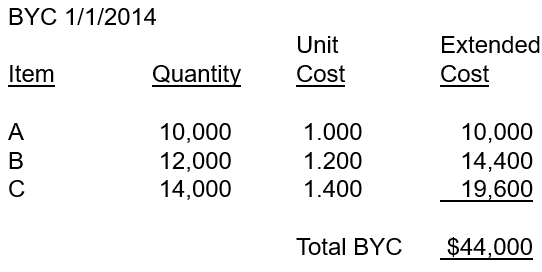
Year 1, Illustration #1.2 – Calculate current-year cost (CYC)

Year 1, Illustration #1.3 – Compute the current year index by multiplying the end of year quantities (EOYQ) by end of year (EOY) costs and divide that amount by the end of year quantities by beginning of year costs. Then compute the current year cumulative index by multiplying the current year’s index by the base-year cost index of 1.000 in the year of election.
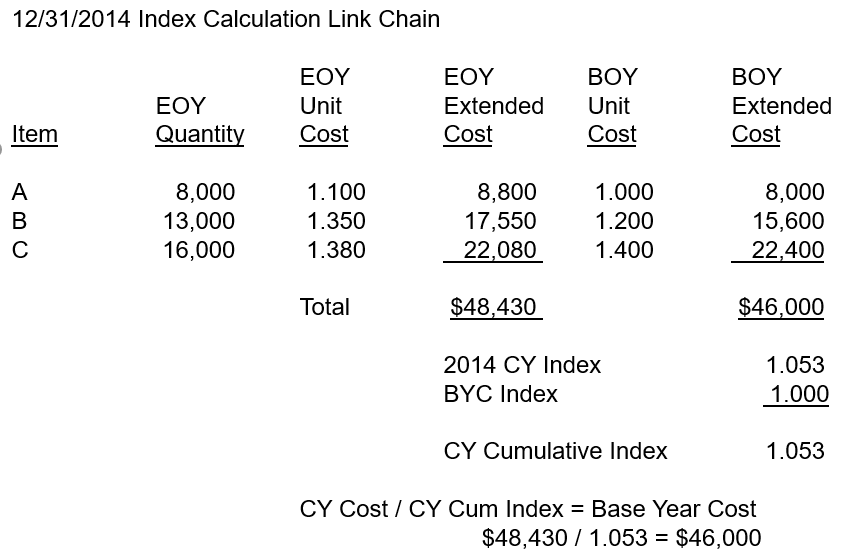
Year 1, Illustration #1.4 – Deflate the current-year cost to base-year cost by dividing the current-year cost by the current year’s cumulative index. When the ending inventory is deflated to base-year cost, determine if a new base year layer is created. If a new base year layer is created, the layer is inflated to current cost to create a new LIFO layer. Add the LIFO layers together and calculate the LIFO inventory value. Calculate the LIFO reserve by subtracting the LIFO inventory from the current costs (FIFO) inventory cost.
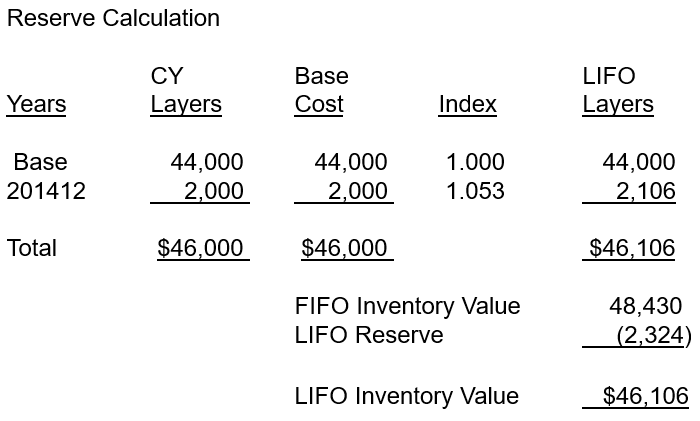
Year 2, Illustration #2.1 – Calculate current-year cost (CYC)

Year 2, Illustration #2.2 – Calculate the current year’s index. Calculate the current year cumulative index by multiplying the current year index by the prior year’s cumulative index.
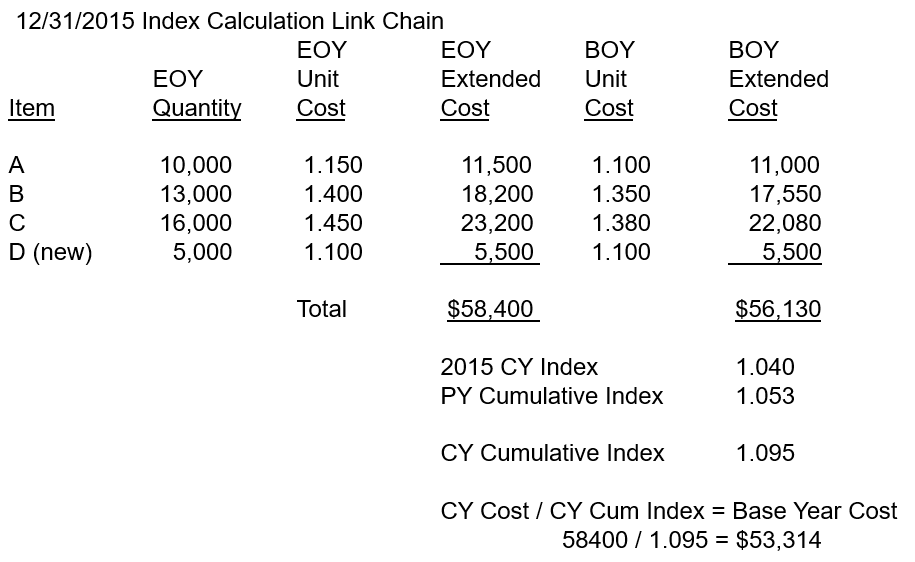
Year 2, Illustration #2.3 -Deflate the current-year cost to base-year cost and determine if a new base year layer is created. If a new base year layer is created, the layer is inflated to current cost to create a new LIFO layer. Add the LIFO layers and calculate the LIFO inventory value. Calculate the LIFO reserve by subtracting the LIFO inventory from the current costs (FIFO) inventory cost.
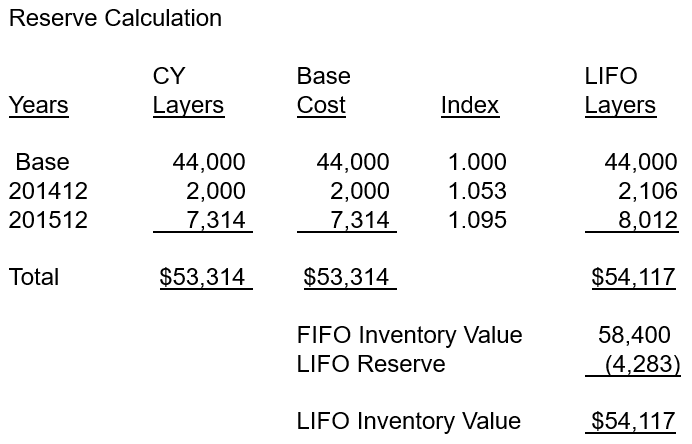
Year 3, Illustration #3.1 – Calculate current-year cost (CYC)
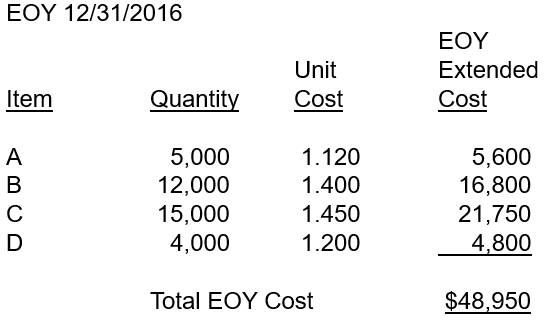
Year 3, Illustration #3.2 – Calculate the current year’s index. Calculate the current year cumulative index by multiplying the current year index by the prior year’s cumulative index.
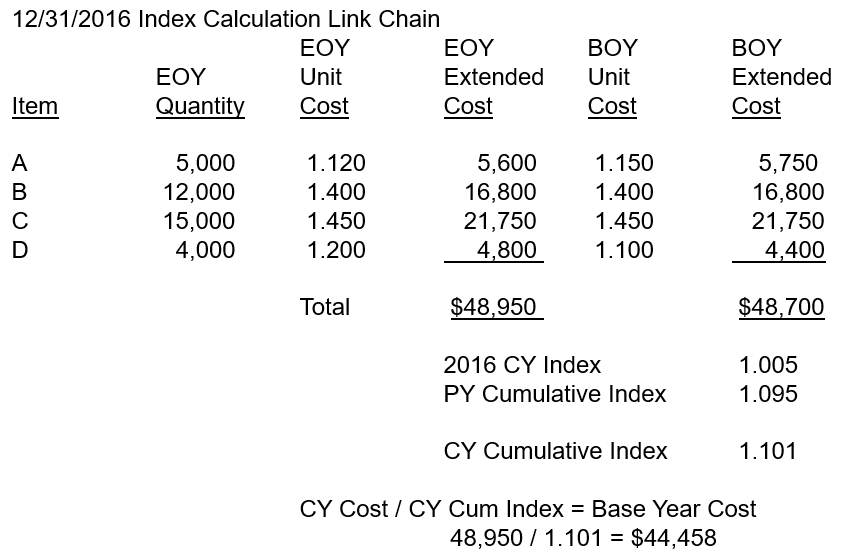
Year 3, Illustration #3.3 – Determine if a new base year layer is created. If not, then reduce the layers and recalculate LIFO for the remaining base layers. Calculate the LIFO inventory value and LIFO reserve.
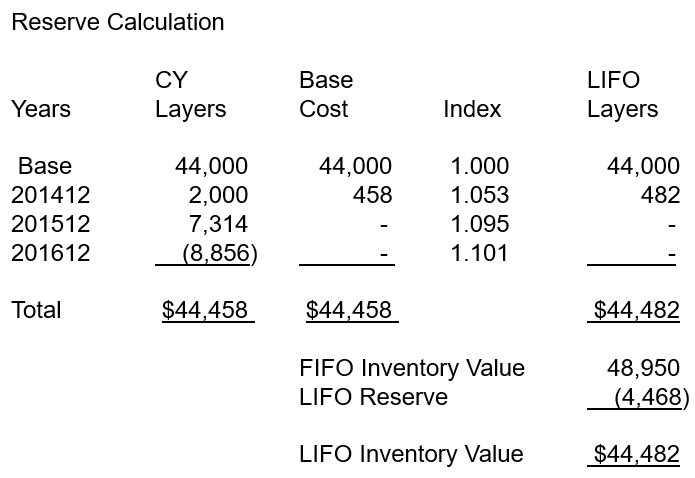
Year 4, Illustration #4.1 – Calculate current-year cost (CYC)
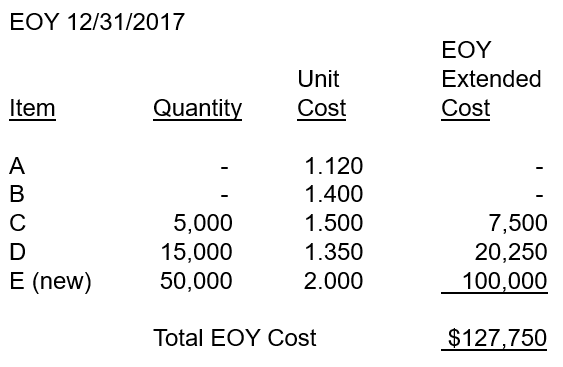
Year 4, Illustration #4.2 – Calculate the current year’s index. Calculate the current year cumulative index by multiplying the current year index by the prior year’s cumulative index.
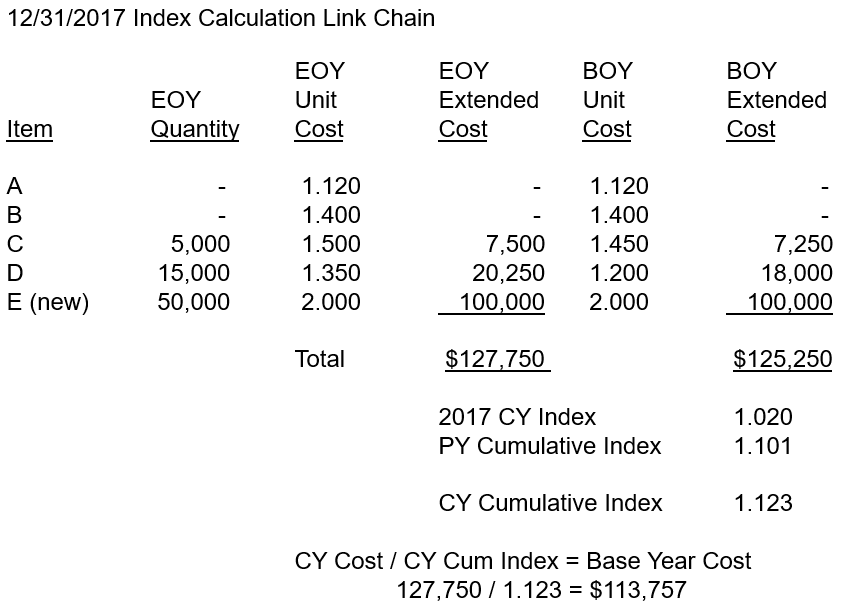
Year 4, Illustration #4.3 – Deflate the current-year cost to base-year cost and determine if a new base year layer is created. If a new base year layer is created, then the layer is inflated to current cost to create a new LIFO layer. Add the LIFO layers together and calculate the LIFO inventory value. Calculate the LIFO reserve by subtracting the LIFO inventory from the current costs (FIFO) inventory cost.
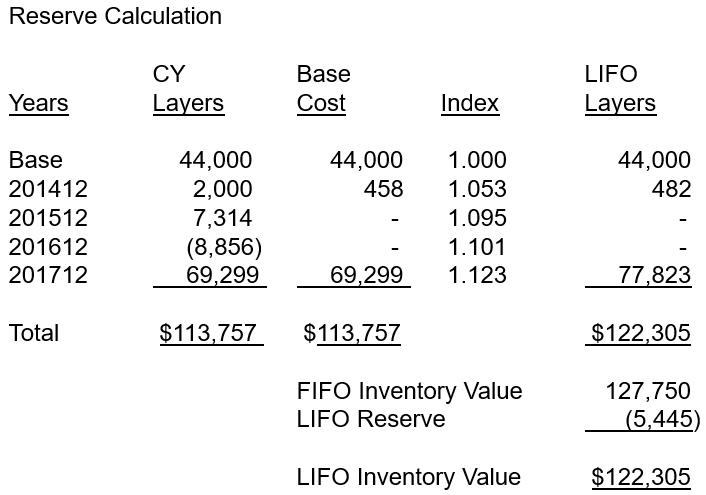
Example #2 – IPIC LIFO
Calculating IPIC LIFO Using 7 Steps
IPIC LIFO Steps 1,2 & 3

IPIC LIFO Steps 4, 5, 6 & 7
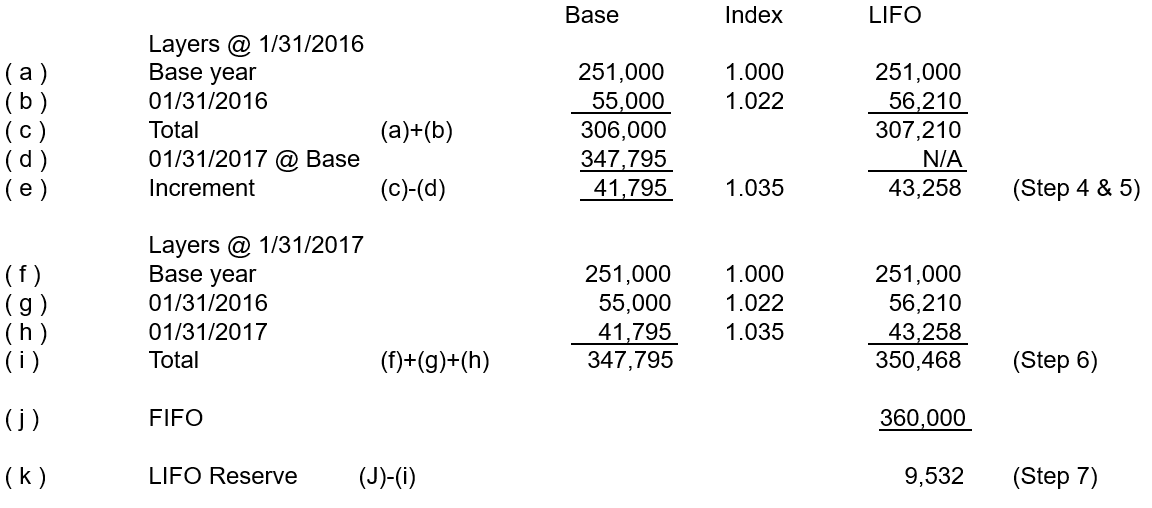
Example #3 – Retail Inventory Method (RIM)
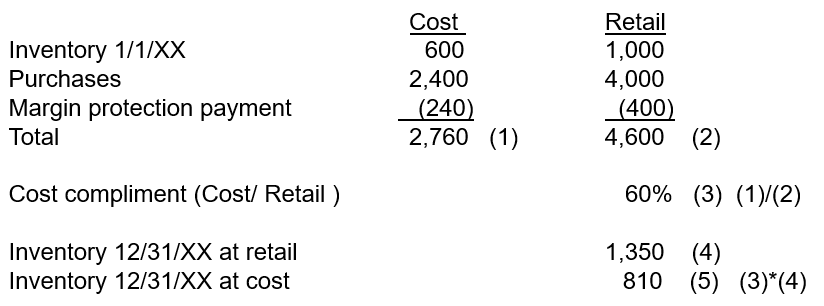
Example #4 – Double-extension Method
Year 1, Illustration #1.1 – Establish the extended base-year cost (BYC) for the first year when LIFO was elected by multiplying the quantities on hand at the beginning of the base year by the unit costs for each item on hand at the beginning of the base year.
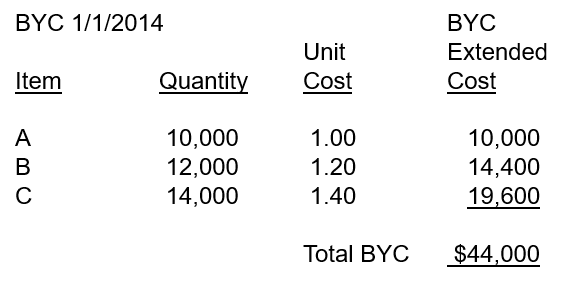
Year 1, Illustration #1.2 – Calculate current-year costs (CYC) for the first tax year. Calculate the end of year (EOY) extended cost for each item by multiplying the end of year (EOY) quantity for each item on hand by the end of year unit cost for each item. The sum of the EOY extended costs is the total current-year cost (CYC).
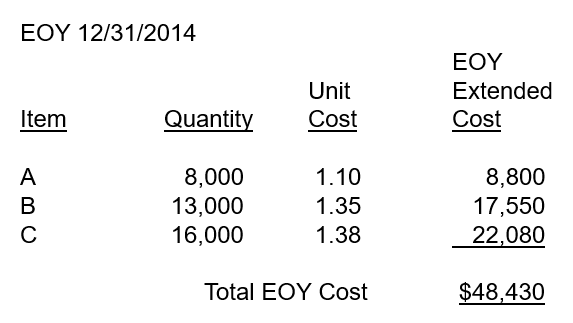
Year 1, Illustration #1.3 – Compute the current year Inflation index for the base year by (1) multiplying the end of year quantities (EOYQ) by end of year (EOY) unit costs to determine EOY extended cost, then (2). multiply base-year (BYC) unit cost by EOY quantity to determine BYC extended cost, then, (3) divide the EOY extended cost by BYC extended cost.
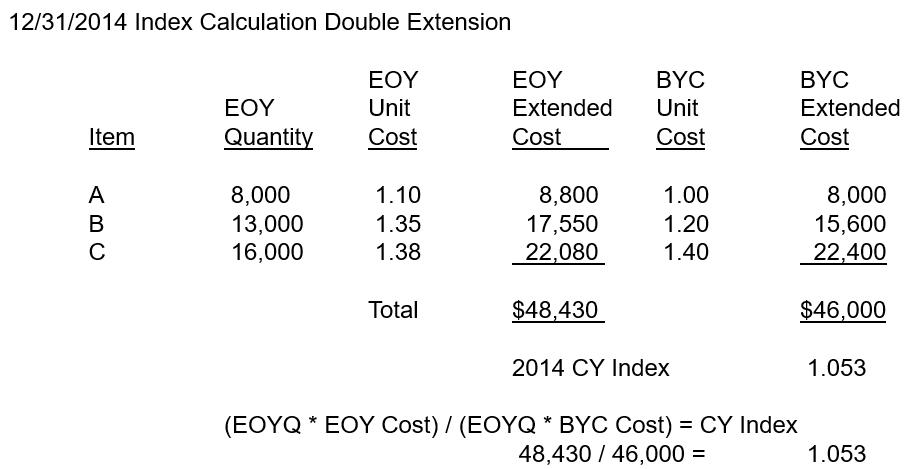
Year 1, Illustration #1.4 – Deflate the current-year cost to base-year cost by dividing current-year cost by the current-year index. When the ending inventory is deflated to base-year cost, determine if a new base year layer is created. If a new base year layer is created, the layer is inflated to current cost to create a new LIFO layer. Add the LIFO layers together to calculate the LIFO inventory value. Calculate the LIFO reserve by subtracting the LIFO inventory from the FIFO inventory value. The FIFO inventory value is the EOY Extended Cost for all items at the end of the most recent year.
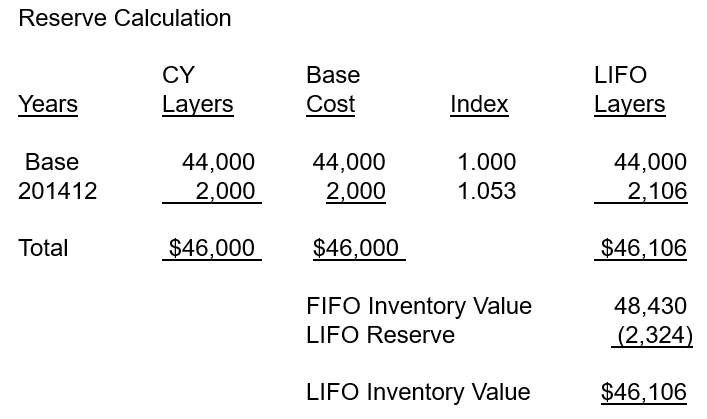
Year 2, Illustration #2.1 – Calculate current-year cost (CYC) for the second tax year. Calculate the end of year (EOY) extended cost for each item by multiplying the end of year (EOY) quantity for each item on hand by the end of year unit cost for each item. The sum of the EOY extended costs is the total current-year cost (CYC).
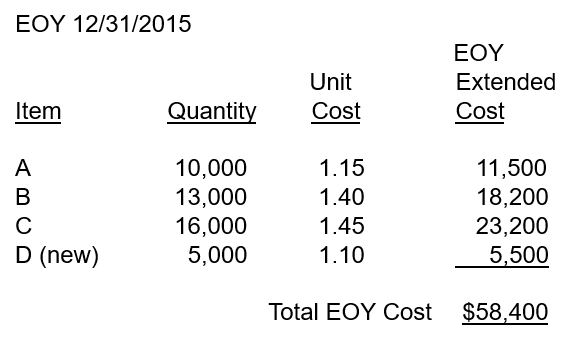
Year 2, Illustration #2.2 – Calculate current year index

Year 2, Illustration #2.3 – Determine if a new base year layer is created. If so, then calculate the current year LIFO layer. Calculate the LIFO inventory value and LIFO reserve.
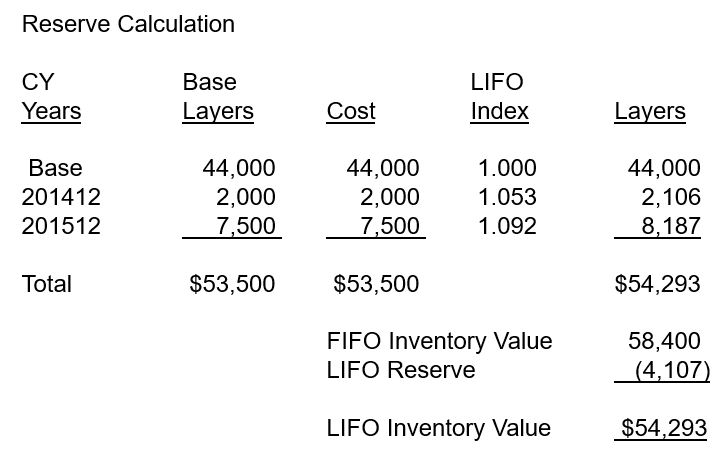
Year 3, Illustration #3.1 – Calculate current-year cost (CYC)
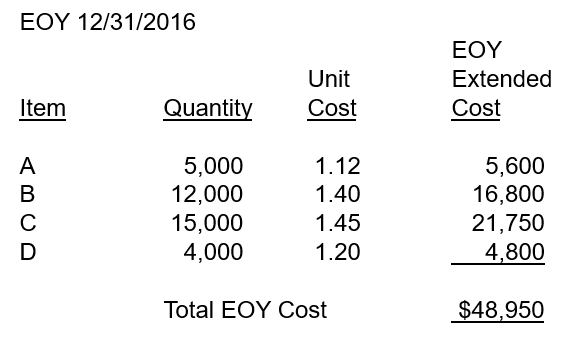
Year 3, Illustration #3.2 – Calculate current year index
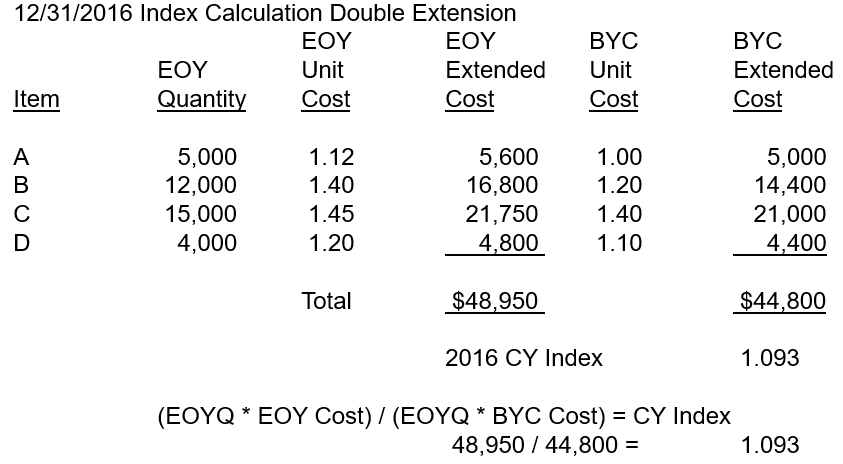
Year 3, Illustration #3.3 – Determine if a new base year layer is created. If not, then reduce the layers and re-calculate LIFO for the remaining base layers. Calculate the LIFO inventory value and LIFO reserve.
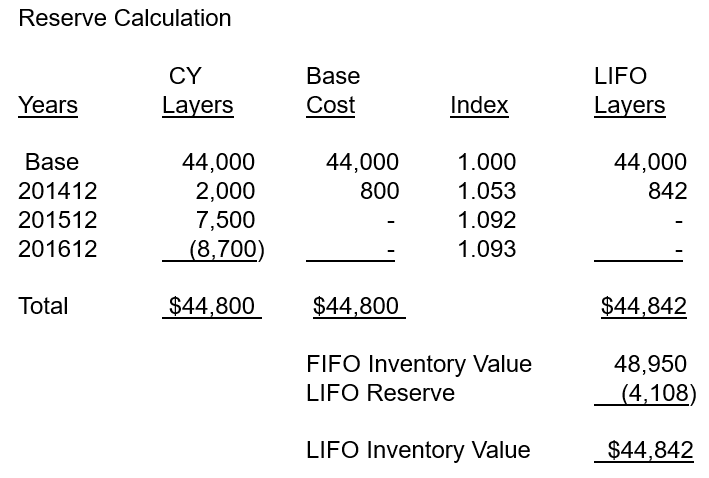
Year 4, Illustration #4.1 – Calculate current-year cost (CYC)
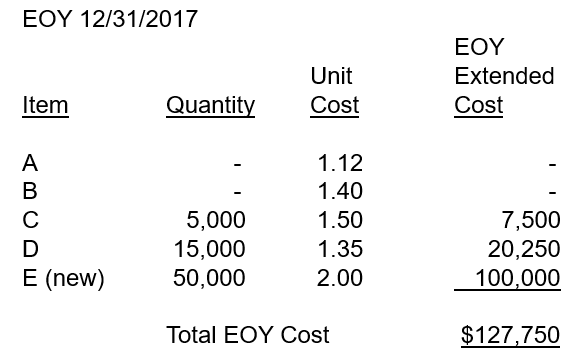
Year 4, Illustration #4.2 – Calculate current year index
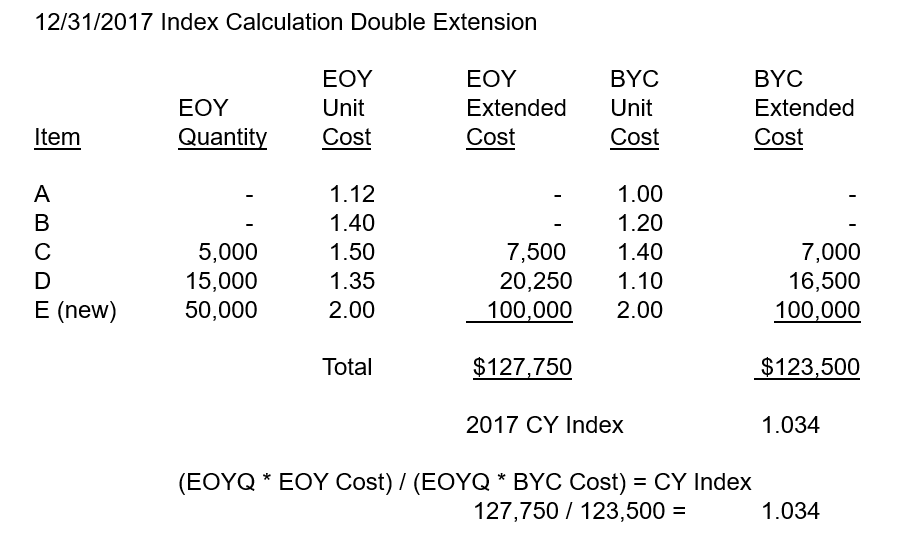
Year 4, Illustration #4.3 – Calculate the LIFO inventory value and LIFO reserve as previously described

Treas. Reg. 1.472-2 provides the general requirements for the adoption and use of the Last-in First-out (LIFO) method.
The following are the basic requirements for adopting and using the LIFO method that will be discussed in this concept unit:
How to Elect LIFO
A taxpayer must complete Form 970, Application to Use the LIFO Inventory Method, and attach it to the tax return in which it first elects LIFO.
Value Beginning Inventory at Cost
A taxpayer must value its beginning inventory at cost in the first taxable year that it uses the LIFO method. See IRC 472(d). In the first taxable year (the year of change), a taxpayer must treat the items in beginning inventory as if it acquired them all at the same time and the taxpayer must re-determine their value using the average cost method. See IRC 472(b)(3). To determine the average cost, a taxpayer sums the cost it paid for each item in ending inventory and divides the summation by the number of items in ending inventory.
A taxpayer adopting the LIFO method cannot use the lower of cost or market method to value its inventory. See IRC 472(b)(2). A taxpayer that had been using the lower of cost or market method before it adopted LIFO must adjust its inventory balances to cost.
The IRS may terminate a taxpayer’s LIFO election if the taxpayer does not value its inventory at cost for the year preceding the LIFO election. Termination is not automatic due to the Service’s discretionary authority in IRC 472(e)(2).
When terminating a taxpayer’s LIFO election, the inventory is restored to cost by changing the beginning inventory in the year of change (see discussion below). See Rev. Proc. 79-23.
A change from the First-in, First-out (FIFO), or any other inventory method, is a change in accounting method. A taxpayer is required to recompute the inventory account balances for inventory using the LIFO cost. A taxpayer includes in income the increase in inventory value, resulting from the restoration of write-downs, ratably in each of the three taxable years beginning with the first taxable year the taxpayer uses the LIFO method. See IRC 472(d).
Restore Inventory Write-downs
A taxpayer adopting the LIFO method must restore all inventory write-downs in ending inventory that the taxpayer claimed in previous years into taxable income. This restoration is required for all write-downs, including write-downs from cost to market value, write-downs for subnormal goods and excess inventory, and percentage write-downs (financial accounting inventory write-downs based on the company’s historical experience). See Rev. Proc. 76-28 and Issue Snapshot -Overview of Inventory Write-Downs.
LIFO Conformity Requirements
A taxpayer must use the LIFO method for book purposes and for any income statements to shareholders in the year the taxpayer adopts the LIFO method and any subsequent year. Financial statement conformity requirements when using the LIFO inventory method are covered in Treas. Reg. 1.472-2(e).The regulation also explains the exceptions to the requirements.
LIFO conformity requirements:
A taxpayer does not have to use the LIFO method in the following items when reporting for financial statement purposes:
Continue to Use the LIFO method
A taxpayer must continue to use the LIFO method after adoption unless:
Maintain Adequate Records
A taxpayer must maintain supplemental and detailed inventory records to enable verification of the taxpayer’s inventory computations and determine its compliance with the requirements of IRC 472 and Treas. Regs. 1.472-1 through 1.472-8. The taxpayer must maintain detailed records of the current and base costs of the items in inventory and the detail of all index determinations.
Termination of a taxpayer’s LIFO election may be warranted if the taxpayer does not maintain adequate books and records for its LIFO inventory and all computations incident thereto in accordance with Rev. Proc 79-23. However, termination in these situations is not automatic due to the Commissioner’s discretionary authority in IRC 472(e)(2) and the underlying regulations.
Since the LIFO inventory value contains historic layers, a taxpayer must maintain the current cost detail listing for every year in which the taxpayer uses the LIFO method. See Treas. Reg. 1.472-8(e). The listing includes the SKU (i.e., stock-keeping unit number), item description, quantity, and current cost of each item in inventory. See Treas. Reg. 1.472-8(e).
The annual current cost detail listing allows for verification of new items that enter into the inventory, the current cost of the new items, and the LIFO computation at any time during the duration of the LIFO election.
Changes in Accounting Methods
A change from a LIFO Method to a non-LIFO method for valuing inventory is a change in accounting method. See IRC 472(e).
If the Service terminates a taxpayer’s LIFO election due to conformity issues, then the taxpayer must follow the rules outlined in Treas. Reg. 1.472-6.A taxpayer must value the inventory:
If the Service terminates a taxpayer’s LIFO election, the taxpayer will not be entitled to any special relief provisions and the termination adjustment would be made under IRC 481.
This would result in a change of accounting method for the earliest year under examination with a corresponding IRC 481(a) adjustment equal to the taxpayer’s LIFO tax reserve as of the first day of the year of change. In addition, there would be a current year adjustment for the difference between LIFO and FIFO costs.
The LIFO reserve is the difference between the ending inventory valued using LIFO and ending inventory valued at current year cost (see below):
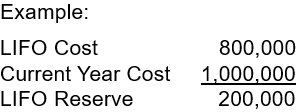
The Service reaffirms that, absent unusual circumstances, a taxpayer may not readopt the LIFO method for at least five taxable years after terminating the election in accordance with Rev. Proc. 2011-14.
When the Service determines a taxpayer’s book inventory method is not a LIFO inventory method, the taxpayer is using an impermissible method of accounting for income tax reporting. The Service may change the taxpayer’s inventory method of accounting to a permissible non-LIFO inventory method for income tax reporting.
A taxpayer electing the Last in –First out (LIFO) method for tax purposes must generally use the LIFO method in its financial statements. The regulations provide a few exceptions to this general rule. Treas. Reg. 1.472-2(e) covers the financial statement conformity requirements for a taxpayer using the LIFO inventory method. It also explains the exceptions to the requirements discussed below.
Other LIFO conformity requirements include:
Two Conformity Requirements
First, the LIFO conformity rules apply to the first taxable year the taxpayer adopts LIFO. A taxpayer must establish that it is using only LIFO and no other inventory method. See IRC 472. The conformity rules apply to all reports or statements of income, profit, or loss to shareholders, beneficiaries or credit holders. There are some exceptions to this rule as noted later.
Second, the LIFO conformity rules apply to future taxable years. Once a taxpayer has elected LIFO, it must continue to report under this method for financial reporting unless the taxpayer also changes to a non-LIFO method for tax purposes.
If a taxpayer violates the LIFO reporting requirement, the IRS may require the taxpayer to change its LIFO method of accounting to a non-LIFO method for tax purposes.
Exceptions to Financial Statement Reporting Requirements
A taxpayer electing the LIFO method has five exceptions to the financial reporting requirements provided in Treas. Reg. 1.472-2(e):
Consolidated Financial Statements
The LIFO conformity requirements apply to consolidated financial statements that include a subsidiary using the LIFO method. The parent must report its subsidiaries operating results in the consolidated financial statements on a LIFO basis. See IRC 472(g).
Exceptions to this rule are available for certain foreign parent-subsidiary groups and foreign controlled brother-sister groups. See Rev. Rul. 78-246. In addition, Rev. Rul. 89-41 provides some other exceptions to the conformity requirement for consolidated financial statements.
Audit Tips
Review a LIFO taxpayer’s annual reports to identify any financial information reported on a non-LIFO basis. In addition, review internal management reports and interim reports to ensure the taxpayer meets the exceptions stated earlier.
Consider any internal non-LIFO reports released to shareholders or interim reports that exceed one year a potential conformity violation issue. Consider the conformity rules as they apply to consolidated financial statements and be aware of the exceptions to the conformity rules.
When the Service determines a taxpayer’s book inventory method is not a LIFO inventory method, the taxpayer is using an impermissible method of accounting. The Service may change the taxpayer’s inventory method of accounting to a permissible non-LIFO inventory method. See Rev. Proc. 2002-18.
Many United States (U.S.) controlled foreign subsidiaries (CFS) use Last In-First Out (LIFO) to value their inventory on U.S. income tax returns. A taxpayer can treat a foreign subsidiary as a U.S. branch by checking the box on Form 8832, Entity Classification Election, and reporting required information on Form 8858, Information Return of U.S. Persons With Respect to Foreign Disregarded Entities (FDEs) and Foreign Branches (FBs).
A controlled foreign corporation is any foreign corporation in which U.S. shareholders own directly, indirectly, or constructively more than 50 percent of the total value of the stock of such foreign corporation or the total combined voting power of the stock of all classes of stock entitled to vote on any day during the taxable year.
IRC 472(g) requires conformity between financial statement and federal income tax reporting. The United States and Japan are the only countries whose governments permit taxpayers to use LIFO for financial statement reporting. Other countries have adopted the International Financial Reporting Standards (IFRS). Adoption of IFRS for financial statement reporting purposes will cause LIFO termination for U.S. tax purposes, because IFRS does not allow the use of the LIFO inventory method for financial statement reporting.
A U.S. CFS must use the LIFO method for valuing inventory on its financial statements to use the LIFO method for valuing inventory on its U.S. income tax return.
Likewise, a taxpayer using the LIFO method of inventory for U.S. tax reporting purposes must use that same method for all financial statement reporting for credit purposes, and for financial statement reports to shareholders, partners, proprietors, and beneficiaries.
Exception to LIFO Conformity -Substantial Foreign Operations
A foreign parent of a consolidated group need not use the LIFO method of inventory valuation in the consolidated financial statements of a consolidated group that engages in substantial foreign operations, even though one or more of its subsidiaries use the LIFO method of valuing inventories for federal tax purposes. See Rev. Rul. 78-246. A group engages in substantial foreign operations if the foreign parent owns, either directly or through members of the group, 30 percent or more of the group’s total operating assets used in foreign operations. Rev. Rul. 78-246 revokes Rev. Rul. 73-57, which had reached a contrary conclusion. The Internal Revenue Service determined it was appropriate to apply the rule of Rev. Rul. 78246 to foreign-owned groups of affiliated corporations that issue financial statements on a combined basis, for the reasons stated in Rev. Rul. 78-246.
United States Controlled Foreign Subsidiaries
However, Rev. Rul. 78-246 does not apply to a United States-owned group of affiliated corporations, because Rev. Rul. 78-246 does not extend to the foreign subsidiary of a domestic parent. See Rev. Rul. 89-41. A broad application of the position in Rev. Rul. 78-246 is not consistent with IRC 472(c), which requires a taxpayer to use LIFO in certain financial statements. Accordingly, a U.S. CFS must use the LIFO method for valuing inventory on its financial statements to use the LIFO method for valuing inventory on its U.S. income tax return.
In addition, the enactment of IRC 472(g)(2) (that is, conformity rules are applied on a controlled group basis) includes foreign corporations in the definition of a “group of financially related corporations.”
Disregarded Entities
A U.S. parent company using LIFO for tax must report the inventory of the foreign disregarded entity on a LIFO basis for book purposes. The U.S. parent must use LIFO for all reporting for credit purposes, reports to shareholders, partners, proprietors and beneficiaries. See the LIFO conformity requirement in Treas. Reg. 1.472-2(e).
Even if a group engages in substantial foreign operations within the meaning of Rev. Rul. 78-246 as explained earlier, that revenue ruling does not apply to United States owned groups of financially related corporations. Accordingly, if a foreign disregarded entity uses the LIFO method of inventory valuation for U.S. federal income tax purposes (but not for foreign financial statement purposes), the foreign disregarded entity cannot use the LIFO method for its inventories when they are included in the consolidated financial statements of the group (i.e., the conformity requirement).
Certain U.S. persons that own foreign disregarded entities (FDEs) directly or indirectly through a tier of FDEs or partnerships, use Form 8858, Information Return of U.S. Persons With Respect to Foreign Disregarded Entities (FDEs) and Foreign Branches (FBs), and its schedules to satisfy the reporting requirements of IRC 6011, 6012, 6031, and 6038, and related regulations. See the instructions for Form 8858 for who must file the form.
Change in Accounting Method
A change from a LIFO Method to a non-LIFO method for valuing inventory is a change in accounting method. See IRC 472(e) and 446.
If the Service terminates a taxpayer’s LIFO election due to conformity issues, the taxpayer must follow the rules outlined in Treas. Reg. 1.472-6. Under a Service-imposed LIFO termination, the taxpayer must value the inventory using the below ordering rules:
If the Service terminates a taxpayer’s LIFO election, the taxpayer will not be entitled to any special relief provisions. The termination adjustment is a change in accounting method under IRC 446 for the earliest year under examination with a corresponding IRC 481(a) adjustment equal to the taxpayer’s LIFO tax reserve as of the first day of the year of change (YOC). In addition, there would be a current year adjustment for the method determined above under Treas. Reg. 1.472-6.
The LIFO reserve is the difference between the ending inventory valued using LIFO and ending inventory valued at current year cost. Example:

In Rev. Proc. 2015-13, the Service reaffirmed that, absent unusual circumstances, a taxpayer may not readopt the LIFO method for at least five taxable years after terminating the election.
When the Service determines a taxpayer’s book inventory method is not a LIFO inventory method, the taxpayer is using an impermissible method of accounting. The Service may change the taxpayer’s inventory method of accounting to a permissible non-LIFO inventory method.
(a)General rule
Whenever in the opinion of the Secretary the use of inventories is necessary in order clearly to determine the income of any taxpayer, inventories shall be taken by such taxpayer on such basis as the Secretary may prescribe as conforming as nearly as may be to the best accounting practice in the trade or business and as most clearly reflecting the income.
(b)Estimates of inventory shrinkage permittedA method of determining inventories shall not be treated as failing to clearly reflect income solely because it utilizes estimates of inventory shrinkage that are confirmed by a physical count only after the last day of the taxable year if—
(1)
the taxpayer normally does a physical count of inventories at each location on a regular and consistent basis, and
(2)
the taxpayer makes proper adjustments to such inventories and to its estimating methods to the extent such estimates are greater than or less than the actual shrinkage.
(c)Exemption for certain small businesses
(1)In generalIn the case of any taxpayer (other than a tax shelter prohibited from using the cash receipts and disbursements method of accounting under section 448(a)(3)) which meets the gross receipts test of section 448(c) for any taxable year—
(A)
subsection (a) shall not apply with respect to such taxpayer for such taxable year, and
(B)the taxpayer’s method of accounting for inventory for such taxable year shall not be treated as failing to clearly reflect income if such method either—
(i)
treats inventory as non-incidental materials and supplies, or
(ii)
conforms to such taxpayer’s method of accounting reflected in an applicable financial statement of the taxpayer with respect to such taxable year or, if the taxpayer does not have any applicable financial statement with respect to such taxable year, the books and records of the taxpayer prepared in accordance with the taxpayer’s accounting procedures.
(2)Applicable financial statement
For purposes of this subsection, the term “applicable financial statement” has the meaning given the term in section 451(b)(3).
(3)Application of gross receipts test to individuals, etc.
In the case of any taxpayer which is not a corporation or a partnership, the gross receipts test of section 448(c) shall be applied in the same manner as if each trade or business of such taxpayer were a corporation or partnership.
(4)Coordination with section 481
Any change in method of accounting made pursuant to this subsection shall be treated for purposes of section 481 as initiated by the taxpayer and made with the consent of the Secretary.
(d)Cross reference
For rules relating to capitalization of direct and indirect costs of property, see section 263A.
(a) In general. Except as provided in paragraph (b) of this section, in order to reflect taxable income correctly, inventories at the beginning and end of each taxable year are necessary in every case in which the production, purchase, or sale of merchandise is an income-producing factor. The inventory should include all finished or partly finished goods and, in the case of raw materials and supplies, only those which have been acquired for sale or which will physically become a part of merchandise intended for sale, in which class fall containers, such as kegs, bottles, and cases, whether returnable or not, if title thereto will pass to the purchaser of the product to be sold therein. Merchandise should be included in the inventory only if title thereto is vested in the taxpayer. Accordingly, the seller should include in his inventory goods under contract for sale but not yet segregated and applied to the contract and goods out upon consignment, but should exclude from inventory goods sold (including containers), title to which has passed to the purchaser. A purchaser should include in inventory merchandise purchased (including containers), title to which has passed to him, although such merchandise is in transit or for other reasons has not been reduced to physical possession, but should not include goods ordered for future delivery, transfer of title to which has not yet been effected. (But see § 1.472-1.)
(b) Exemption for certain small business taxpayers—(1) In general. Paragraph (a) of this section shall not apply to a taxpayer, other than a tax shelter prohibited from using the cash receipts and disbursements method of accounting (cash method) under section 448(a)(3), in any taxable year if the taxpayer meets the gross receipts test described in paragraph (b)(2) of this section, and uses as a method of accounting for its inventory a method that is described in paragraph (b)(3) of this section.
(2) Gross receipts test—(i) In general. A taxpayer, other than a tax shelter prohibited from using the cash method under section 448(a)(3), meets the gross receipts test of this paragraph (b)(2) if it meets the gross receipts test of section 448(c) and § 1.448-2(c). This gross receipts test applies even if the taxpayer is not otherwise subject to section 448(a).
(ii) Application of the gross receipts test—(A) In general. In the case of any taxpayer that is not a corporation or partnership, and except as otherwise provided in paragraphs (b)(2)(ii)(B) and (C) of this section, the gross receipts test of section 448(c) and the accompanying regulations are applied in the same manner as each trade or business of the taxpayer were a corporation or partnership.
(B) Gross receipts of individuals, etc. Except when the aggregation rules of section 448(c)(2) apply, the gross receipts of a taxpayer other than a corporation or partnership are the amount derived from all trades or businesses of such taxpayer. Amounts not related to a trade or businesses are excluded from the gross receipts of the taxpayer. For example, an individual taxpayer‘s gross receipts do not include inherently personal amounts, such as: personal injury awards or settlements with respect to an injury of the individual taxpayer, disability benefits, Social Security benefits received by the taxpayer during the taxable year, and wages received as an employee that are reported on Form W-2.
(C) Partners and S corporation shareholders—(1) In general. Except when the aggregation rules of section 448(c)(2) apply, each partner in a partnership includes a share of the partnership‘s gross receipts in proportion to such partner‘s distributive share (as determined under section 704) of items of gross income that were taken into account by the partnership under section 703. Similarly, a shareholder includes the pro rata share of S corporation gross receipts taken into account by the S corporation under section 1363(b).
(2) [Reserved]
(D) Examples. The operation of this paragraph (b)(2) is illustrated by the following examples:
(1) Example 1. Taxpayer A, a calendar year S corporation, is a reseller and maintains inventories. In 2017, 2018, and 2019, A’s gross receipts were $10 million, $11 million, and $13 million respectively. A is not prohibited from using the cash method under section 448(a)(3). For 2020, A meets the gross receipts test of paragraph (b)(2) of this section.
(2) Example 2. Taxpayer B operates two separate and distinct trades or businesses that are reported on Schedule C, Profit or Loss from Business, of B’s Federal income tax return. For 2020, one trade or business has annual average gross receipts of $5 million, and the other trade or business has average annual gross receipts of $35 million. Under paragraph (b)(2)(ii)(B) of this section, for 2020, neither of B’s trades or businesses meets the gross receipts test of paragraph (b)(2) of this section ($5 million + $35 million = $40 million, which is greater than the inflation-adjusted gross receipts test amount for 2020, which is $26 million).
(3) Example 3. Taxpayer C is an individual who operates three separate and distinct trades or business that are reported on Schedule C of C’s Federal income tax return. For 2020, Business X is a retail store with average annual gross receipts of $15 million, Business Y is a dance studio with average annual gross receipts of $6 million, and Business Z is a car repair shop with average annual gross receipts of $12 million. Under paragraph (b)(2)(ii)(B) of this section, C’s gross receipts are the combined amount derived from all three of C’s trades or businesses. Therefore, for 2020, X, Y and Z do not meet the gross receipts test of paragraph (b)(2)(i) of this section ($15 million + $6 million + $12 million = $33 million, which is greater than the inflation-adjusted gross receipts test amount for 2020, which is $26 million).
(3) Methods of accounting under the small business taxpayer exemption. A taxpayer eligible to use, and that chooses to use, the exemption described in paragraph (b) of this section may account for its inventory by either:
(i) Using a method that treats its inventory as non-incidental materials and supplies (section 471(c) NIMS inventory method), as described in paragraph (b)(4) of this section; or
(ii) Using the method for each item that is reflected in the taxpayer‘s applicable financial statement (AFS) (AFS section 471(c) inventory method); or, if the taxpayer does not have an AFS for the taxable year, the books and records of the taxpayer prepared in accordance with the taxpayer‘s accounting procedures, as defined in paragraph (b)(6)(ii) of this section (non-AFS section 471(c) inventory method).
(4) Inventory treated as non-incidental materials and supplies—(i) In general. The costs of inventory treated as non-incidental materials and supplies are recovered through cost of goods sold only in the taxable year in which the inventory is used or consumed in the taxpayer‘s business, or in the taxable year in which the taxpayer pays for or incurs the cost of the inventory, whichever is later. Inventory treated as non-incidental materials and supplies is used or consumed in the taxpayer‘s business in the taxable year in which the taxpayer provides the inventory to its customer. The costs of inventory are treated as non-incidental materials and supplies under this paragraph (b)(4) are not eligible for the de minimis safe harbor election under § 1.263(a)-1(f)(2).
(ii) Identification and valuation of inventory treated as non-incidental materials and supplies. A taxpayer may determine the amount of the costs of its inventory treated as non-incidental materials and supplies that are recoverable through costs of goods sold by using either a specific identification method, a first-in, first-out (FIFO) method, or an average cost method, provided that method is used consistently. See § 1.471-2(d). A taxpayer that uses the section 471(c) NIMS inventory method may not use any other method described in the regulations under section 471, or the last-in, first-out (LIFO) method described in section 472 and the accompanying regulations, to either identify inventory treated as non-incidental materials and supplies, or to value that inventory treated as non-incidental materials and supplies. The inventory costs includible in the section 471(c) NIMS inventory method are the direct material costs of the property produced or the costs of property acquired for resale. However, an inventory cost does not include a cost for which a deduction would be disallowed, or that is not otherwise recoverable but for paragraph (b)(4) of this section, in whole or in part, under a provision of the Internal Revenue Code.
(iii) Allocation methods. A taxpayer treating its inventory as non-incidental materials and supplies under this paragraph (b)(4) may allocate the costs of such inventory by using specific identification or any other reasonable method.
(iv) Example. Taxpayer D is a baker that reports its baking trade or business on Schedule C, Profit or Loss From Business, of the Form 1040, Individual Tax Return, and D’s baking business has average annual gross receipts for the 3-taxable years prior to 2019 of less than $100,000. D meets the gross receipts test of section 448(c) and is not prohibited from using the cash method under section 448(a)(3) in 2019. Therefore, D qualifies as a small business taxpayer under paragraph (b)(2) of this section. D uses the overall cash method, and the section 471(c) NIMS inventory method. D purchases $50 of peanut butter in November 2019. In December 2019, D uses all of the peanut butter to bake cookies available for immediate sale. D sells those peanut butter cookies to customers in January 2020. The peanut butter cookies are used or consumed under paragraph (b)(4)(i) of this section in January 2020 when the cookies are sold to customers, and D may recover the cost of the peanut butter in 2020.
(5) AFS section 471(c) inventory method—(i) In general. A taxpayer that meets the gross receipts test described in paragraph (b)(2) of this section and that has an AFS for such taxable year may use the AFS section 471(c) inventory method described in this paragraph to account for its inventory costs for the taxable year. For purposes of the AFS section 471(c) inventory method, an inventory cost is a cost of production or resale that a taxpayer capitalizes to inventory property produced or property acquired for resale in its AFS. For purposes of the AFS section 471(c) inventory method, costs that are generally required to be capitalized to inventory under section 471(a) but that the taxpayer does not capitalize to inventory on its AFS are not required to be capitalized to inventory. However, an inventory cost does not include a cost that is neither deductible nor otherwise recoverable but for paragraph (b)(5) of this section, in whole or in part, under a provision of the Internal Revenue Code (for example, section 162(c), (e), (f), (g), or 274). In lieu of the inventory method described in section 471(a), a taxpayer using the AFS section 471(c) inventory method recovers its inventory costs in accordance with the inventory method used in its AFS.
(ii) Definition of Applicable Financial Statement (AFS). The term applicable financial statement (AFS) is defined in section 451(b)(3) and the accompanying regulations. See § 1.451-3(a)(5). The rules relating to additional AFS issues provided in § 1.451-3(h) apply to the AFS section 471(c) inventory method. In the case of a taxpayer with a financial accounting year that differs from the taxpayer‘s taxable year, the taxpayer must consistently use the same method of accounting described in § 1.451-3(h)(4)(i)(A) through (C) that is used for section 451(b) purposes to also determine its inventory for the taxable year under this paragraph (b)(5)(ii). A taxpayer has an AFS for the taxable year if all of the taxpayer‘s taxable year is covered by an AFS.
(iii) Timing of inventory costs. Notwithstanding the timing rules used in the taxpayer‘s AFS, the amount of any inventoriable cost may not be capitalized or otherwise taken into account for Federal income tax purposes any earlier than the taxable year during which the amount is paid or incurred under the taxpayer‘s overall method of accounting, as described in § 1.446-1(c)(1). For example, in the case of an accrual method taxpayer, inventoriable costs must satisfy the all events test, including economic performance, of section 461. See § 1.446-1(c)(1)(ii) and section 461 and the accompanying regulations.
(iv) Example. H is a calendar year C corporation that is engaged in the trade or business of selling office supplies and providing copier repair services. H meets the gross receipts test of section 448(c) and is not prohibited from using the cash method under section 448(a)(3) for 2019 or 2020. For Federal income tax purposes, H chooses to account for purchases and sales of inventory using an accrual method of accounting and for all other items using the cash method. For AFS purposes, H uses an overall accrual method of accounting. H uses the AFS section 471(c) inventory method of accounting. In H’s 2019 AFS, H incurred $2 million in purchases of office supplies held for resale and recovered the $2 million as cost of goods sold. On January 5, 2020, H makes payment on $1.5 million of these office supplies. For purposes of the AFS section 471(c) inventory method of accounting, H can recover the $2 million of office supplies in 2019 because the amount has been included in cost of goods sold in its AFS inventory method and section 461 has been satisfied.
(6) Non-AFS section 471(c) inventory method—(i) In general. A taxpayer that meets the gross receipts test described in paragraph (b)(2) of this section for a taxable year and that does not have an AFS, as defined in paragraph (b)(5)(ii) of this section, for such taxable year may use the non-AFS section 471(c) inventory method to account for its inventories for the taxable year in accordance with this paragraph (b)(6). The non-AFS section 471(c) inventory method is the method of accounting used for inventory in the taxpayer‘s books and records that properly reflect its business activities for non-tax purposes and are prepared in accordance with the taxpayer‘s accounting procedures. For purposes of the non-AFS section 471(c) inventory method, an inventory cost is a cost of production or resale that the taxpayer capitalizes to inventory property produced or property acquired for resale in its books and records, except as provided in paragraph (b)(6)(ii) of this section. Costs that are generally required to be capitalized to inventory under section 471(a), but that the taxpayer does not capitalize in its books and records are not required to be capitalized to inventory. However, an inventory cost does not include a cost that is neither deductible nor otherwise recoverable but for paragraph (b)(5) of this section, in whole or in part, under a provision of the Internal Revenue Code (for example, section 162(c), (e), (f), (g), or 274). In lieu of the inventory method described in section 471(a), a taxpayer using the non-AFS section 471(c) inventory method recovers its applicable costs through its book inventory method of accounting. A taxpayer that has an AFS for such taxable year may not use the non-AFS section 471(c) inventory method.
(ii) Timing and amounts of costs. Notwithstanding the timing of costs reflected in the taxpayer‘s books and records, a taxpayer may not recover any costs that have not been paid or incurred under the taxpayer‘s overall method of accounting, as described in § 1.446-1(c)(1). For example, in the case of an accrual method taxpayer or a taxpayer using an accrual method for purchases and sales, inventory costs must satisfy the all events test, including economic performance, under section 461(h). See § 1.446-1(c)(1)(ii), and section 461 and the accompanying regulations.
(iii) Examples. The following examples illustrate the rules of paragraph (b)(6) of this section.
(A) Example 1. Taxpayer E is a C corporation that is engaged in the retail trade or business of selling beer, wine, and liquor. In 2019, E has average annual gross receipts for the prior 3-taxable-years of $15 million and is not otherwise prohibited from using the cash method under section 448(a)(3). E does not have an AFS for the 2019 taxable year. E is eligible to use the non-AFS section 471(c) inventory method of accounting. E uses the overall cash method, and the non-AFS section 471(c) inventory method of accounting for Federal income tax purposes. In E’s electronic bookkeeping software, E treats all costs paid during the taxable year as presently deductible. As part of its regular business practice, E’s employees take a physical count of inventory on E’s selling floor and its warehouse on December 31, 2019, and E uses this physical count as part of its books and records for purposes of capitalizing and allocating costs to inventory. E also makes representations to its creditor of the cost of inventory on hand for specific categories of product it sells. E may not expense all of its costs paid during the 2019 taxable year because its books and records do not accurately reflect the inventory records used for non-tax purposes in its regular business activity. Instead, E must use the physical inventory count taken at the end of 2019 to determine how its capitalized costs are allocated and recovered.
(B) Example 2. Same facts as Example (1) in paragraph (b)(6)(iii)(A) of this section but E does not use the physical count to capitalize and allocate costs to inventory and does not make any representations about inventory on hand to any creditors. Although E pays or incurs costs that are generally required to be capitalized to inventory under section 471(a), because such costs are not capitalized to inventory in E’s books and records, they are not required to be capitalized to inventory under paragraph (b)(6)(i) of this section.
(C) Example 3. Same facts as Example (1) in paragraph (b)(6)(iii)(A) of this section but E does not use the physical count to capitalize and allocate costs to inventory in its electronic bookkeeping software and does not make any representations about inventory on hand to any external parties. E does use the physical count to value inventory on hand for internal reports to its shareholders. The internal reports to its shareholders are part of E’s books and records and must be taken into account for E’s non-AFS section 471(c) inventory method. E recovers its inventory costs consistent with its non-AFS section 471(c) inventory method.
(D) Example 4. Taxpayer F is a C corporation that is engaged in the manufacture of baseball bats. In 2019, F has average annual gross receipts for the prior 3-taxable-years of less than $25 million and is not otherwise prohibited from using the cash method under section 448(a)(3). F does not have an AFS for the 2019 taxable year. For Federal income tax purposes, F uses the overall cash method of accounting, and the non-AFS section 471(c) inventory method of accounting. For its books and records, F uses an overall accrual method and maintains inventories. In December 2019, F’s financial statements show $500,000 of direct and indirect material costs. F pays its supplier in January 2020. Under paragraph (b)(6)(ii) of this section, F recovers its direct and indirect material costs in 2020.
(E) Example 5. Taxpayer G is a baker that reports its baking trade or business on Schedule C, Profit or Loss From Business, of the Form 1040, Individual Tax Return. In 2020, G’s baking business has average annual gross receipts for the prior 3-taxable years of less than $100,000 and is not otherwise prohibited from using the cash method under section 448(a)(3). G does not have an AFS for the 2020 taxable year. For Federal income tax purposes, G uses the overall cash method of accounting and the non-AFS section 471(c) inventory method. In G’s books and records for 2020 that properly reflects its business activities for non-tax purposes, G capitalizes the cost of its cookie ingredients to inventory but immediately expenses the cost of labor for G’s employee who bakes the cookies. Under paragraphs (b)(6)(i) and (ii) of this section, G treats as an inventory cost the cost of its cookie ingredients and recovers such costs in accordance with the accounting procedures used to prepare its books and records, or, if later, when paid. Additionally, although the cost of direct labor is generally required to be capitalized to inventory under section 471(a), because such cost is not capitalized to inventory in G’s books and records, it is not required to be capitalized to inventory under paragraph (b)(6)(i) of this section. Further, because such direct labor cost is generally deductible under section 162, and not otherwise required to be capitalized under section 263(a), G may deduct the cost of labor in the year G pays that expense.
(F) Example 6. Taxpayer H is a partnership engaged in the resale of beer, wine, and liquor. In 2020, H has average annual gross receipts for the prior 3-taxable-years of less than $25 million and is not otherwise prohibited from using the cash method under section 448(a)(3). H does not have an AFS for the 2020 taxable year. For Federal income tax purposes, H uses the overall cash method of accounting, and the non-AFS section 471(c) inventory method of accounting. For its books and records, H uses the overall cash method. As part of its regular business practice, H’s employees take regular physical counts of the inventory on the shop floor and in the storeroom, however H’s method of accounting for inventory for its books and records does not allocate costs between ending inventory and cost of goods sold, and instead expenses the cost of the inventory in the year it was paid for. Prior to December 2020, H acquires and pays for $500,000 of beer, wine, and liquor. In addition, on December 1, 2020, H acquires $50,000 in beer and wine, and pays for this beer and wine on December 20, 2020. H may recover as deductions in 2020 the $550,000 of inventory costs.
(G) Example 7. Taxpayer J is a partnership engaged in the resale of beer, wine, and liquor. In 2020, J has average annual gross receipts for the prior 3-taxable-years of less than $25 million and is not otherwise prohibited from using the cash method under section 448(a)(3). J does not have an AFS for the 2020 taxable year. For Federal income tax purposes, J uses the overall cash method of accounting, and the non-AFS section 471(c) inventory method of accounting. For its books and records, J uses the overall cash method. J maintains a point-of-sale computer system that tracks acquisition costs and inventory levels of the beer, wine, and liquor. The ledger is periodically reconciled with physical counts performed by J’s employees. J must use the physical inventory count and ledger to determine its ending inventory. J includes in cost of goods sold for 2020 those inventory costs that are not properly allocated to ending inventory.
(7) Effect of section 471(c) on other provisions. Nothing in section 471(c) shall have any effect on the application of any other provision of law that would otherwise apply, and no inference shall be drawn from section 471(c) with respect to the application of any such provision. For example, an accrual method taxpayer that includes inventory costs in its AFS is required to satisfy section 461 before such cost can be included in cost of goods sold for the taxable year. Similarly, nothing in section 471(c) affects the requirement under section 446(e) that a taxpayer secure the consent of the Commissioner before changing its method of accounting. If an item of income or expense is not treated consistently from year to year, that treatment may not clearly reflect income, notwithstanding the application of this section. Finally, nothing in section 471(c) permits the deduction or recovery of any cost that a taxpayer is otherwise precluded from deducting or recovering under any other provision in the Code or Regulations.
(8) Method of accounting—(i) In general. A change in the method of treating inventory under this paragraph (b) is a change in method of accounting under sections 446 and 481 and the accompanying regulations. A taxpayer changing its method of accounting under paragraph (b) of this section may do so only with the consent of the Commissioner as required under section 446(e) and § 1.446-1. For example, a taxpayer using the AFS section 471(c) inventory method or non-AFS section 471(c) inventory method that wants to change its method of accounting for inventory in its AFS, or its books and records, respectively, is required to secure the consent of the Commissioner before using this new method for Federal income tax purposes. However, a change from having an AFS to not having an AFS, or vice versa, without a change in the underlying method for inventory for financial reporting purposes that affects Federal income tax is not a change in method of accounting for such inventory under section 446(e). In the case of any taxpayer required by this section to change its method of accounting for any taxable year, the change shall be treated as a change initiated by the taxpayer. For rules relating to the clear reflection of income and the pattern of consistent treatment of an item, see section 446 and § 1.446-1. The amount of the net section 481(a) adjustment and the adjustment period necessary to implement a change in method of accounting required under this section are determined under § 1.446-1(e) and the applicable administrative procedures to obtain the Commissioner’s consent to change a method of accounting as published in the Internal Revenue Bulletin (see Revenue Procedure 2015-13 (2015-5 IRB 419) (or successor) (see also § 601.601(d)(2) of this chapter).
(ii) Automatic consent for certain method changes. Certain changes in method of accounting made under paragraph (b) of this section may be made under the procedures to obtain the automatic consent of the Commissioner to change a method of accounting. See Revenue Procedure 2015-13 (2015-5 IRB 419) (or successor) (see § 601.601(d)(2) of this chapter)). In certain situations, special terms and conditions may apply.
(c) Applicability dates. This section applies for taxable years beginning on or after January 5, 2021. However, for a taxable year beginning after December 31, 2017, and before January 5, 2021, a taxpayer may apply this section provided that the taxpayer follows all the applicable rules contained in this section for such taxable year and all subsequent taxable years.
(a) Section 471 provides two tests to which each inventory must conform:
(1) It must conform as nearly as may be to the best accounting practice in the trade or business, and
(2) It must clearly reflect the income.
(b) It follows, therefore, that inventory rules cannot be uniform but must give effect to trade customs which come within the scope of the best accounting practice in the particular trade or business. In order to clearly reflect income, the inventory practice of a taxpayer should be consistent from year to year, and greater weight is to be given to consistency than to any particular method of inventorying or basis of valuation so long as the method or basis used is in accord with §§ 1.471-1 through 1.471-11.
(c) The bases of valuation most commonly used by business concerns and which meet the requirements of section 471 are (1) cost and (2) cost or market, whichever is lower. (For inventories by dealers in securities, see § 1.471-5.) Any goods in an inventory which are unsalable at normal prices or unusable in the normal way because of damage, imperfections, shop wear, changes of style, odd or broken lots, or other similar causes, including second-hand goods taken in exchange, should be valued at bona fide selling prices less direct cost of disposition, whether subparagraph (1) or (2) of this paragraph is used, or if such goods consist of raw materials or partly finished goods held for use or consumption, they shall be valued upon a reasonable basis, taking into consideration the usability and the condition of the goods, but in no case shall such value be less than the scrap value. Bona fide selling price means actual offering of goods during a period ending not later than 30 days after inventory date. The burden of proof will rest upon the taxpayer to show that such exceptional goods as are valued upon such selling basis come within the classifications indicated above, and he shall maintain such records of the disposition of the goods as will enable a verification of the inventory to be made.
(d) In respect of normal goods, whichever method is adopted must be applied with reasonable consistency to the entire inventory of the taxpayer‘s trade or business except as to those goods inventoried under the last-in, first-out method authorized by section 472 or to animals inventoried under the elective unit, livestock-price-method authorized by § 1.471-6. See paragraph (d) of § 1.446-1 for rules permitting the use of different methods of accounting if the taxpayer has more than one trade or business. Where the taxpayer is engaged in more than one trade or business the Commissioner may require that the method of valuing inventories with respect to goods in one trade or business also be used with respect to similar goods in other trades or businesses if, in the opinion of the Commissioner, the use of such method with respect to such other goods is essential to a clear reflection of income. Taxpayers were given an option to adopt the basis of either (1) cost or (2) cost or market, whichever is lower, for their 1920 inventories. The basis properly adopted for that year or any subsequent year is controlling, and a change can now be made only after permission is secured from the Commissioner. Application for permission to change the basis of valuing inventories shall be made in writing and filed with the Commissioner as provided in paragraph (e) of § 1.446-1. Goods taken in the inventory which have been so intermingled that they cannot be identified with specific invoices will be deemed to be the goods most recently purchased or produced, and the cost thereof will be the actual cost of the goods purchased or produced during the period in which the quantity of goods in the inventory has been acquired. But see section 472 as to last-in, first-out inventories. Where the taxpayer maintains book inventories in accordance with a sound accounting system in which the respective inventory accounts are charged with the actual cost of the goods purchased or produced and credited with the value of goods used, transferred, or sold, calculated upon the basis of the actual cost of the goods acquired during the taxable year (including the inventory at the beginning of the year), the net value as shown by such inventory accounts will be deemed to be the cost of the goods on hand. The balances shown by such book inventories should be verified by physical inventories at reasonable intervals and adjusted to conform therewith.
(e) Inventories should be recorded in a legible manner, properly computed and summarized, and should be preserved as a part of the accounting records of the taxpayer. The inventories of taxpayers on whatever basis taken will be subject to investigation by the district director, and the taxpayer must satisfy the district director of the correctness of the prices adopted.
(f) The following methods, among others, are sometimes used in taking or valuing inventories, but are not in accord with the regulations in this part:
(1) Deducting from the inventory a reserve for price changes, or an estimated depreciation in the value thereof.
(2) Taking work in process, or other parts of the inventory, at a nominal price or at less than its proper value.
(3) Omitting portions of the stock on hand.
(4) Using a constant price or nominal value for so-called normal quantity of materials or goods in stock.
(5) Including stock in transit, shipped either to or from the taxpayer, the title to which is not vested in the taxpayer.
(6) Segregating indirect production costs into fixed and variable production cost classifications (as defined in § 1.471-11(b)(3)(ii)) and allocating only the variable costs to the cost of goods produced while treating fixed costs as period costs which are currently deductible. This method is commonly referred to as the “direct cost” method.
(7) Treating all or substantially all indirect production costs (whether classified as fixed or variable) as period costs which are currently deductible. This method is generally referred to as the “prime cost” method.
Cost means:
(a) In the case of merchandise on hand at the beginning of the taxable year, the inventory price of such goods.
(b) In the case of merchandise purchased since the beginning of the taxable year, the invoice price less trade or other discounts, except strictly cash discounts approximating a fair interest rate, which may be deducted or not at the option of the taxpayer, provided a consistent course is followed. To this net invoice price should be added transportation or other necessary charges incurred in acquiring possession of the goods. But see § 1.263A-1(d)(2)(iv)(C) for special rules for certain direct material costs that in certain cases are permitted to be capitalized as additional section 263A costs by taxpayers using a simplified method under § 1.263A-2(b) or (c) or § 1.263A-3(d). For taxpayers acquiring merchandise for resale that are subject to the provisions of section 263A, see §§ 1.263A-1 and 1.263A-3 for additional amounts that must be included in inventory costs.
(c) In the case of merchandise produced by the taxpayer since the beginning of the taxable year, (1) the cost of raw materials and supplies entering into or consumed in connection with the product, (2) expenditures for direct labor, and (3) indirect production costs incident to and necessary for the production of the particular article, including in such indirect production costs an appropriate portion of management expenses, but not including any cost of selling or return on capital, whether by way of interest or profit. See §§ 1.263A-1 and 1.263A-2 for more specific rules regarding the treatment of production costs.
(d) In any industry in which the usual rules for computation of cost of production are inapplicable, costs may be approximated upon such basis as may be reasonable and in conformity with established trade practice in the particular industry. Among such cases are:
(1) Farmers and raisers of livestock (see § 1.471-6);
(2) Miners and manufacturers who by a single process or uniform series of processes derive a product of two or more kinds, sizes, or grades, the unit cost of which is substantially alike (see § 1.471-7); and
(3) Retail merchants who use what is known as the “retail method” in ascertaining approximate cost (see § 1.471-8).
(e) Sales-based vendor allowances—(1) Treatment of sales-based vendor chargebacks—(i) In general. A sales-based vendor chargeback is an allowance, discount, or price rebate that a taxpayer becomes unconditionally entitled to by selling a vendor’s merchandise to specific customers identified by the vendor at a price determined by the vendor. A sales-based vendor chargeback decreases cost of goods sold and does not reduce the cost of goods on hand at the end of the taxable year.
(ii) Example. The following example illustrates the provisions of this paragraph (e)(1).
Example.
(i) W is a wholesaler of pharmaceuticals. W purchases Drug X from the manufacturer, M, for $10x per unit. M has agreements with specific customers that allow those customers to acquire Drug X from M’s wholesalers for $6x per unit. Under an agreement between W and M, W is required to sell Drug X to specific customers at the prices M has negotiated with such customers ($6x per unit) and, in exchange, M agrees to provide a price rebate to W equal to the difference between W’s cost for Drug X and the price W is required to charge specific customers under the agreement (a difference of $4x per unit). W sells Drug X to specific customer Y for $6x. Under the agreement between W and M, the price rebate can be paid to W, credited against M’s invoice to W for W’s purchase of Drug X, or it can be credited to W’s future purchases of drugs from M.
(ii) Under the terms of the agreement, W is unconditionally entitled to the price rebate of Drug X when it sells Drug X to specific customer Y, a specifically identified customer of M. The price rebate received by W for the sale of Drug X to Y is a sales-based vendor chargeback. Therefore, the amount of the sales-based vendor charge back, $4x per unit for Drug X, whether paid to W, credited against M’s invoice to W for W’s purchase of Drug X or credited against a future purchase, decreases cost of goods sold and does not reduce the cost of Drug X on hand at the end of the taxable year.
(2) Treatment of other sales-based vendor allowances. [Reserved]
(f) Notwithstanding the other rules of this section, cost shall not include an amount which is of a type for which a deduction would be disallowed under section 162 (c), (f), or (g) and the regulations thereunder in the case of a business expense.
(g) Effective/applicability date. Paragraph (f) of this section applies to taxable years ending on or after January 13, 2014.
(a) In general—(1) Market definition. Under ordinary circumstances and for normal goods in an inventory, market means the aggregate of the current bid prices prevailing at the date of the inventory of the basic elements of cost reflected in inventories of goods purchased and on hand, goods in process of manufacture, and finished manufactured goods on hand. The basic elements of cost include direct materials, direct labor, and indirect costs required to be included in inventories by the taxpayer (e.g., under section 263A and its underlying regulations for taxpayers subject to that section). For taxpayers to which section 263A applies, for example, the basic elements of cost must reflect all direct costs and all indirect costs properly allocable to goods on hand at the inventory date at the current bid price of those costs, including but not limited to the cost of purchasing, handling, and storage activities conducted by the taxpayer, both prior to and subsequent to acquisition or production of the goods. The determination of the current bid price of the basic elements of costs reflected in goods on hand at the inventory date must be based on the usual volume of particular cost elements purchased (or incurred) by the taxpayer.
(2) Fixed price contracts. Paragraph (a)(1) of this section does not apply to any goods on hand or in process of manufacture for delivery upon firm sales contracts (i.e., those not legally subject to cancellation by either party) at fixed prices entered into before the date of the inventory, under which the taxpayer is protected against actual loss. Any such goods must be inventoried at cost.
(b) Inactive markets. Where no open market exists or where quotations are nominal, due to inactive market conditions, the taxpayer must use such evidence of a fair market price at the date or dates nearest the inventory as may be available, such as specific purchases or sales by the taxpayer or others in reasonable volume and made in good faith, or compensation paid for cancellation of contracts for purchase commitments. Where the taxpayer in the regular course of business has offered for sale such merchandise at prices lower than the current price as above defined, the inventory may be valued at such prices less direct cost of disposition, and the correctness of such prices will be determined by reference to the actual sales of the taxpayer for a reasonable period before and after the date of the inventory. Prices which vary materially from the actual prices so ascertained will not be accepted as reflecting the market.
(c) Comparison of cost and market. Where the inventory is valued upon the basis of cost or market, whichever is lower, the market value of each article on hand at the inventory date shall be compared with the cost of the article, and the lower of such values shall be taken as the inventory value of the article.
(d) Effective date. This section applies to inventory valuations for taxable years beginning after December 31, 1993. For taxable years beginning before January 1, 1994, taxpayers must take reasonable positions on their federal income tax returns with respect to the application of section 263A, and must have otherwise complied with § 1.471-4 (as contained in the 26 CFR part 1 edition revised April 1, 1993). For purposes of this paragraph (d), a reasonable position as to the application of section 263A is a position consistent with the temporary regulations, revenue rulings, revenue procedures, notices, and announcements concerning section 263A applicable in taxable years beginning before January 1, 1994. (See § 601.601(d)(2)(ii)(b) of this chapter.)
(a) In general. A taxpayer that is a retail merchant may use the retail inventory method of accounting described in this section. The retail inventory method uses a formula to convert the retail selling price of ending inventory to an approximation of cost (retail cost method) or an approximation of lower of cost or market (retail LCM method). A taxpayer may use the retail inventory method instead of valuing inventory at cost under § 1.471-3 or lower of cost or market under § 1.471-4.
(b) Computation—(1) In general. A taxpayer computes the value of ending inventory under the retail inventory method by multiplying a cost complement by the retail selling prices of the goods on hand at the end of the taxable year.
(2) Cost complement—(i) In general. The cost complement is a ratio computed as follows:
(A) The numerator is the value of beginning inventory plus the cost (as determined under § 1.471-3, except as otherwise provided in this section) of goods purchased during the taxable year.
(B) The denominator is the retail selling prices of beginning inventory plus the retail selling prices of goods purchased during the year (that is, the bona fide retail selling prices of the items at the time acquired), adjusted for all permanent markups and markdowns, including markup and markdown cancellations and corrections. The denominator is not adjusted for temporary markups or markdowns.
(ii) Vendor allowances required to reduce only cost of goods sold. A taxpayer may not reduce the numerator of the cost complement by the amount of an allowance, discount, or price rebate that is required under § 1.471-3(e) to reduce only cost of goods sold.
(3) Additional rules for cost complement for retail LCM method—(i) In general—(A) Margin protection payments. A taxpayer using the retail LCM method may not reduce the numerator of the cost complement by the amount of an allowance, discount, or price rebate that is related to or intended to compensate for a permanent reduction in the taxpayer‘s retail selling price of inventory (a margin protection payment).
(B) Markdowns. A taxpayer using the retail LCM method does not adjust the denominator of the cost complement for markdowns (and markdown cancellations or corrections). Markups must be reduced by the markdowns made to cancel or correct them.
(ii) Alternative methods for computing cost complement—(A) In general. In lieu of the method described in paragraph (b)(3)(i) of this section, a taxpayer using the retail LCM method may compute the cost complement using one of the alternative methods described in this paragraph (b)(3)(ii). A taxpayer using an alternative method under this paragraph (b)(3)(ii) must use that method for all cost complements.
(B) Adjust numerator and denominator. A taxpayer using the retail LCM method may reduce the numerator of the cost complement by the amount of all margin protection payments if the taxpayer also reduces the denominator of the cost complement by the amount of the permanent reduction in retail selling price to which the margin protection payments relate (related markdowns).
(C) Deemed adjustment to denominator. A taxpayer using the retail LCM method that is able to determine the amount of all margin protection payments but cannot determine the amount of the related markdowns may reduce the numerator of the cost complement by the amount of all margin protection payments if the taxpayer also reduces the denominator by the amount that, in conjunction with the reduction of the numerator for the margin protection payments, maintains what would have been the cost complement percentage before taking into account the margin protection payment and the related markdown. A taxpayer that can determine the amount of a related markdown but not the associated margin protection payments may not use this method to compute an adjustment to the numerator.
(iii) Statistical sampling. A taxpayer using the retail LCM method may use statistical sampling in accordance with Rev. Proc. 2011-42 or any successor (see § 601.601(d) of this chapter), in conjunction with any method of computing the cost complement described in this paragraph (b)(3), to determine the amount of margin protection payments and related markdowns. A taxpayer using statistical sampling must use it for all margin protection payments and related markdowns associated with the inventory items valued by a particular cost complement, but is not required to use it for every cost complement.
(4) Ending inventory retail selling prices. A taxpayer must include all permanent markups and markdowns but may not include temporary markups or markdowns in determining the retail selling prices of goods on hand at the end of the taxable year. A taxpayer may not include a markdown that is not an actual reduction of retail selling price.
(c) Special rules for LIFO taxpayers. A taxpayer using the last-in, first-out (LIFO) inventory method with the retail inventory method uses the retail cost method. See § 1.472-1(k) for additional adjustments for a taxpayer using the LIFO inventory method with the retail cost method.
(d) Scope of retail inventory method. A taxpayer may use the retail inventory method to value ending inventory for a department, a class of goods, or a stock-keeping unit. A taxpayer maintaining more than one department or dealing in classes of goods with different percentages of gross profit must compute cost complements separately for each department or class of goods.
(e) Examples. The following examples illustrate the rules of this section:
Example 1.
(i) R, a retail merchant who uses the retail LCM method and uses a calendar taxable year, has no beginning inventory in 2012. R purchases 40 tables during 2012 for $60 each for a total of $2,400. R offers the tables for sale at $100 each for an aggregate retail selling price of $4,000. R does not sell any tables at a price of $100, so R permanently marks down the retail selling price of its tables to $90 each. As a result of the $10 markdown, R’s supplier provides R a $6 per table margin protection payment. R sells 25 tables during 2012 and has 15 tables in ending inventory at the end of 2012.
(ii) Under paragraph (b)(2)(i)(A) of this section, the numerator of the cost complement is the aggregate cost of the tables, $2,400. Under paragraph (b)(3)(i)(A) of this section, R may not reduce the numerator of the cost complement by the amount of the margin protection payment. Under paragraph (b)(2)(i)(B) of this section, the denominator of the cost complement is the aggregate of the bona fide retail selling prices of all the tables at the time acquired, $4,000. Under paragraph (b)(3)(i)(B) of this section, R does not adjust the denominator of the cost complement for the markdown. Therefore, R’s cost complement is $2,400/$4,000, or 60%.
(iii) Under paragraph (b)(4) of this section, R includes the permanent markdown in determining year-end retail selling prices. Therefore, the aggregate retail selling price of R’s ending table inventory is $1,350 (15 * $90). Approximating LCM under the retail method, the value of R’s ending table inventory is $810 (60% * $1,350).
Example 2.
(i) The facts are the same as in Example 1, except that R permanently reduces the retail selling price of all 40 tables to $50 per unit and the 15 tables on hand at the end of the year are marked for sale at that price. The additional $40 markdown is unrelated to a margin protection payment or other allowance.
(ii) Under paragraph (b)(3)(i)(B) of this section, R does not adjust the denominator of the cost complement for the markdown. Therefore, R’s cost complement is $2,400/$4,000, or 60%.
(iii) Under paragraph (b)(4) of this section, R includes the permanent markdowns in determining year-end retail selling prices. Therefore, the aggregate retail selling price of R’s ending inventory is $750 (15 * $50). Approximating LCM under the retail method, the value of R’s ending inventory is $450 (60% * $750).
Example 3.
(i) The facts are the same as in Example 1, except that R computes the cost complement using the alternative method under paragraph (b)(3)(ii)(B) of this section.
(ii) R reduces the numerator of the cost complement by the margin protection payments of $240 ($6 * 40) and reduces the denominator of the cost complement by the related markdowns of $400 ($10 * 40). Therefore, R’s cost complement is $2,160/$3,600, or 60%.
(iii) Under paragraph (b)(4) of this section, R includes the permanent markdown in determining year-end retail selling prices. Therefore, the aggregate retail selling price of R’s ending table inventory is $1,350 (15 * $90). Approximating LCM under the retail method, the value of R’s ending table inventory is $810 (60% * $1,350).
Example 4.
(i) The facts are the same as in Example 1, except that R cannot determine the amount of its related markdowns and computes the cost complement using the alternative method under paragraph (b)(3)(ii)(C) of this section.
(ii) R reduces the numerator of the cost complement by the margin protection payments of $240 ($6 * 40). R reduces the denominator of the cost complement by the amount that, in conjunction with the reduction in the numerator, maintains the cost complement percentage before taking into account the margin protection payments and the related markdowns. R’s original cost complement was 60% ($2,400/$4,000). The numerator of R’s new cost complement is $2,160 ($2,400−$240). Therefore, R reduces the denominator by $400, which maintains the cost complement of 60% ($2,160/$3,600).
(iii) Under paragraph (b)(4) of this section, R includes the permanent markdowns in determining year-end retail selling prices. Therefore, the aggregate retail selling price of R’s ending table inventory is $1,350 (15 * $90). Approximating LCM under the retail method, the value of R’s ending table inventory is $810 (60% * $1,350).
Example 5.
(i) The facts are the same as in Example 1, except that R uses the LIFO inventory method. R must value inventories at cost and, under paragraph (c) of this section, uses the retail cost method.
(ii) Under paragraph (b)(2)(i)(A) of this section, R reduces the numerator of the cost complement by the amount of the margin protection payment. Under paragraph (b)(2)(i)(B) of this section, R includes the permanent markdown in the denominator of the cost complement. Therefore, R’s cost complement is $2,160/$3,600, or 60%.
(iii) Under paragraph (b)(4) of this section, R includes the permanent markdown in determining year-end retail selling prices. Therefore, the aggregate retail selling price of R’s ending inventory is $1,350 (15 * $90). Approximating cost under the retail method, the value of R’s ending inventory is $810 (60% * $1,350).
(f) Effective/applicability date. This section applies to taxable years beginning after December 31, 2014. For taxable years beginning before January 1, 2015, see § 1.471-8 as contained in 26 CFR part 1, revised April 1, 2014.
For additional rules in the case of certain corporate acquisitions specified in section 381(a), see section 381(c)(5) and the regulations thereunder.
Have a phone call or WebEx with the LIFO-PRO team to get started today or learn more about our offerings. Schedule online using our easy-to use booking tool.
Sign up today to receive industry news & promotional offers from LIFO-PRO